The Employability Crisis in India: Rethinking Academia–Industry Collaboration

- 01 Nov 2025
In News:
India is grappling with a growing employability crisis, underscored by the fact that only 42.6% of graduates are considered job-ready. This mismatch between academic training and labour market needs has become a structural challenge, affecting productivity, economic growth, and youth aspirations. The crisis signals a systemic misalignment rather than a shortage of talent.
Understanding Employability
Employability today goes beyond academic qualifications. It includes the ability to:
- Acquire and apply knowledge in real-world contexts.
- Adapt to evolving technologies and workplace demands.
- Engage in lifelong learning, unlearning, and relearning.
- Demonstrate soft skills, value creation, and ethical behaviour.
Modern industries require graduates who combine technical capability with communication, teamwork, problem-solving, and a growth mindset.
Causes of the Academia–Industry Divide
Academic Factors
- Outdated Curriculum: Syllabi often fail to match rapid technological changes, new job roles, and automation trends.
- Theory-Oriented Pedagogy: Learning remains exam-centric with limited exposure to practical projects, internships, or problem-solving environments.
- Soft Skills Deficit: Institutions provide little training in communication, adaptability, workplace behaviour, and emotional intelligence.
Industry Factors
- High Expectations: Employers expect “ready-to-deploy” graduates but invest minimally in onboarding or mentoring.
- Rapid Technological Shifts: Industry skill needs evolve faster than academia can adjust, widening the skills gap.
- Weak Collaboration: Companies often view academic institutions as outdated, resulting in minimal engagement in curriculum design or research.
- Short-Term Approach: Recruitment is prioritised over building robust, long-term skill ecosystems.
Government and Institutional Initiatives
- National Education Policy (NEP) 2020: Encourages experiential learning, flexibility, internships, and stronger industry linkages.
- AICTE Internship Mandate: Requires engineering students to undergo industrial exposure.
- Skill India Mission: Strengthens vocational education through Sector Skill Councils aligned with market needs.
- NASSCOM FutureSkills PRIME: Upskills youth in digital technologies such as AI, data analytics, and cybersecurity.
These initiatives aim to modernise learning pathways and improve alignment with industry demands.
Challenges in Implementation
Despite reforms, several structural challenges persist:
- Curricular Inertia: Bureaucratic hurdles delay rapid updates in university syllabi.
- Fragmented Skills Ecosystem: Weak coordination among government, academia, and industry limits policy effectiveness.
- Faculty Skill Gaps: Many educators lack exposure to new technologies and contemporary workplace practices.
- Urban–Rural Divide: Smaller and rural institutions suffer from poor infrastructure and limited corporate linkages.
- Low Industry Investment: Companies underinvest in academia–industry partnerships and long-term talent development.
Way Forward
- Structural Reforms
- Curriculum Co-Design: Regular, collaborative revision of syllabi with inputs from employers, universities, and policymakers.
- Dual-Learning Model: Embed apprenticeships, live projects, and work-integrated learning into higher education.
- Faculty Immersion: Promote faculty internships, industry sabbaticals, and continuous upskilling.
- Skills and Ethics
- Soft Skills & Ethics Labs: Establish dedicated centres for communication, workplace ethics, and emotional intelligence.
- Outcome-Based Tracking: Use data to monitor alumni career trajectories and skill relevance.
- Industry Engagement: Incentivise long-term corporate participation in curriculum development, research, and training.
Conclusion
India’s employability challenge is fundamentally an issue of alignment, not ability. Bridging the gap between academia and industry requires shared responsibility, continuous innovation, and sustained collaboration. When education becomes practical, dynamic, ethical, and closely connected to the world of work, India can unlock its demographic potential and build a resilient, future-ready workforce.
Lokpal of India
- 31 Oct 2025
In News:
The Lokpal of India, established under the Lokpal and Lokayuktas Act, 2013, was envisaged as an independent anti-corruption ombudsman capable of investigating complaints against high public officials, including the Prime Minister, Union Ministers, MPs and government officials.
Conceived in the backdrop of the 2011 anti-corruption movement, the institution began functioning meaningfully only in 2019, when the first Lokpal was constituted—marking a long-awaited step in strengthening mechanisms for integrity and transparency in governance.
Mandate and Powers
- The Lokpal is empowered to conduct inquiries and investigations under the Prevention of Corruption Act, 1988.
- Its jurisdiction extends to all public servants—Groups A to D—besides heads of government-funded institutions.
- It possesses quasi-judicial powers, including summoning witnesses, demanding documents, ordering asset freezes, and recommending prosecution.
- Crucially, it maintains supervisory authority over the CBI in cases referred by it, reinforcing independent and credible investigations.
- The Lokpal’s composition includes a Chairperson and up to eight members—half of them judicial. As of 2025, Justice A.M. Khanwilkar (retd.) serves as Chairperson, supported by a seven-member team. Members are appointed by the President upon the recommendation of a selection committee comprising the Prime Minister, Speaker of Lok Sabha, Leader of Opposition, Chief Justice of India, and an eminent jurist.
Performance Crisis and Data Trends
Despite its powerful mandate, the Lokpal’s performance has raised serious concerns. Since inception, it has received 6,955 complaints, yet only 289 preliminary inquiries have been ordered. Out of these, a mere seven cases have progressed to the prosecution stage—an alarming indicator of institutional underutilisation.
The declining public engagement is sharper still. Annual complaints peaked at 2,469 in 2022–23 but plummeted to 233 in 2025, suggesting fading public confidence. Nearly 90% of all complaints were received in its first four years (2019–2023), while the past three years recorded only 691 complaints combined.
Civil society groups have criticised the procedural rigidity of the Lokpal. Activists point out that many complaints are dismissed on technical grounds such as format errors, while substantive allegations remain unaddressed. Further, the Lokpal’s failure to upload annual reports since 2021–22 has generated questions about its transparency and accountability.
Institutional Weaknesses and Controversies
A major lacuna has been the delayed operationalisation of the prosecution wing, notified only in June 2025—twelve years after the enactment of the Lokpal Act—severely constraining its ability to pursue legal action. The credibility of the institution also came under public scrutiny when it issued a tender to procure seven BMW 330Li luxury cars for its Chairperson and members. Critics argue that an anti-corruption body must demonstrate fiscal restraint and ethical prudence in its own functioning.
Way Forward
Strengthening the Lokpal requires structural, procedural, and ethical reforms. A real-time digital dashboard should be created to enable public tracking of cases and reduce opacity. Complaint formats must be simplified to ensure accessibility for ordinary citizens. Institutional autonomy must be reinforced with adequate staffing for inquiry and prosecution wings. Annual reports should be mandatorily published and tabled in Parliament. Above all, Lokpal must cultivate public trust by adopting austerity and demonstrating moral credibility.
Conclusion
The Lokpal was created to be the custodian of public integrity—an independent safeguard against high-level corruption. However, its diminishing complaint inflow, administrative inertia, and controversies signal a crisis of legitimacy. Revitalising the institution through stronger transparency, greater accountability, and ethical restraint is essential if it is to fulfil its constitutional promise of clean and accountable governance.
Reimagining Green Economy through Landscapes
- 02 Oct 2025
In News:
India stands at a critical juncture where the pursuit of economic growth must align with environmental sustainability. The transition to a green economy offers an opportunity to reshape the country’s development paradigm—one that integrates ecological balance, inclusive livelihoods, and technological innovation within a landscape-driven framework.
India’s Green Economy: Growth and Scope
India’s bioeconomy has expanded remarkably from $10 billion in 2014 to $165.7 billion in 2024, growing sixteenfold and accounting for 4.25% of the national GDP. This growth, driven by over 10,000 bio-based start-ups, spans biofuels, bioplastics, pharmaceuticals, and bioinformatics. The industrial bioeconomy contributes nearly half the sectoral share, while India’s achievements—such as 20% ethanol blending in petrol and becoming the third-largest pharmaceutical producer by volume—reflect the scale of progress.
A green economy, however, extends beyond bio-based industries. It encompasses low-carbon growth, circular resource use, ecosystem restoration, and inclusive employment. By 2030, it is estimated to create 35 million green jobs, strengthening India’s resilience against climate shocks and enhancing energy security under Aatmanirbhar Bharat.
Challenges in the Green Transition
Despite this momentum, India’s green growth exhibits deep regional and socio-economic disparities. Urban centers like Maharashtra, Karnataka, and Gujarat dominate green investments, while the North-Eastern and tribal states contribute less than 6% despite abundant natural resources. This spatial imbalance mirrors unequal access to clean energy, irrigation, and digital infrastructure.
Simultaneously, energy transition dilemmas persist. While renewables are expanding, fossil fuel subsidies—still around 40%—undermine emission reduction efforts. In agriculture, solar pump deployment risks groundwater depletion, highlighting the complexity of balancing environmental and livelihood goals. Hard-to-abate sectors such as steel, cement, and power, which contribute nearly 23% of GHG emissions, face prohibitive costs for green technologies—often four times higher than conventional alternatives.
Social inclusion remains another challenge. Women hold only 11% of rooftop solar jobs, and their share in technical green roles is as low as 1–3%. Similarly, tribal and marginalised communities remain passive beneficiaries rather than active stakeholders in climate action.
Reimagining the Green Economy through Landscapes
A landscape-based approach can make India’s green transition more inclusive and ecologically coherent. Landscapes represent interconnected systems of land, water, biodiversity, and human activity. Integrating these systems through participatory planning—from village to national level—can enhance ecosystem services such as air and water regulation, soil fertility, and climate moderation.
Institutionally, leveraging 2.5 lakh Panchayati Raj Institutions (PRIs) and 12 million women-led Self-Help Groups (SHGs) can embed community ownership into green initiatives. Promoting tribal-led bioeconomy models based on non-timber forest produce, agro-waste reuse, and medicinal flora can align conservation with livelihoods.
Technology and fiscal innovation must complement this vision—through green budgeting, public procurement of sustainable products, and expansion of 5G/6G labs for greening digital infrastructure. Decentralised waste management and circular economy practices are vital, especially as urban areas generate 75% of India’s solid waste.
Conclusion
India’s green transformation must evolve from a sectoral to a landscape-driven, community-based model that harmonises economic growth with ecological integrity. Empowering local institutions, mainstreaming gender, and integrating traditional knowledge with modern innovation will be crucial to achieving a just and resilient green future. By 2047, the goal should not merely be higher GDP, but ecological regeneration, social equity, and global climate leadership.
Vultures and Public Health: Linking Conservation with Pandemic Preparedness

- 14 Sep 2025
Introduction
Vultures, often overlooked in mainstream conservation discourse, are vital ecological assets that deliver critical ecosystem services. As nature’s most efficient waste managers, they swiftly consume animal carcasses, thereby preventing the spread of deadly pathogens such as anthrax, botulism, and rabies. Their decline in South Asia, particularly in India, is not only an ecological concern but also a pressing public health challenge with implications for pandemic preparedness.
Ecological and Public Health Role
Vultures are unique as obligate scavengers capable of consuming large quantities of rotting flesh and bone. By doing so, they prevent the accumulation of carcasses that otherwise become breeding grounds for zoonotic diseases. Studies link the disappearance of vultures to rising cases of rabies and other infections, as feral dogs and rodents, which proliferate in their absence, act as alternative scavengers and reservoirs of disease.
The economic value of this “free service” is immense. Between 1993 and 2006, India’s vulture collapse—among the worst human-caused wildlife die-offs—was estimated to have cost the economy nearly USD 34 billion and indirectly contributed to around 50,000 human deaths due to rabies. This highlights the underestimated yet indispensable role of vultures in sustaining public health and economic stability.
India’s Vulture Crisis
India once hosted more than 40 million vultures, but populations crashed by over 95% since the 1990s, mainly due to the veterinary use of diclofenac, a drug toxic to vultures when ingested through livestock carcasses. Other threats include habitat loss, poisoning, and electrocution from power lines. Although the National Action Plan for Vulture Conservation (2016–25) sought to mitigate these risks, the species remains critically endangered.
The vulture decline demonstrates a direct link between biodiversity loss and increased pandemic risks. Carcass dumps once swarmed with hundreds of vultures, but today many remain unprocessed, heightening risks of disease spillover from animals to humans.
Regional Dimensions: The Central Asian Flyway
Vultures in India are part of the Central Asian Flyway (CAF), a migratory corridor spanning over 30 countries and connecting ecosystems across Asia. Poorly managed landfills, slaughter sites, and carcass dumps along this route can become hotspots for pathogen spillover. Thus, the CAF is not only a biodiversity corridor but also a public health corridor, demanding transboundary collaboration under regional and global frameworks.
Post-2025 Strategy and One Health Approach
As India prepares its post-2025 vulture conservation strategy, a shift from recovery to resilience is crucial. Key priorities include:
- Satellite telemetry to map habitats and carcass hotspots.
- A Decision Support System integrating wildlife, livestock, and health data.
- Embedding vulture conservation within One Health frameworks linking human, animal, and environmental health.
- Cross-border cooperation under CAF to align conservation with global health security.
- Community stewardship, empowering women, youth, and local groups in surveillance and awareness.
Such measures would safeguard vultures as keystone species while strengthening systemic resilience against pandemics at relatively low cost compared to outbreak responses.
Conclusion
Vultures exemplify the interdependence of biodiversity and human health. Their conservation is not merely an ecological obligation but a strategic investment in pandemic preparedness, public health, and economic security. By integrating vulture protection into One Health strategies and regional cooperation frameworks, India can lead in showcasing how biodiversity conservation can double as a frontline defence against future health crises. Protecting vultures, therefore, is not just about saving a species—it is about safeguarding humanity itself.
Pulses Production in India: Pathways to Atmanirbharta
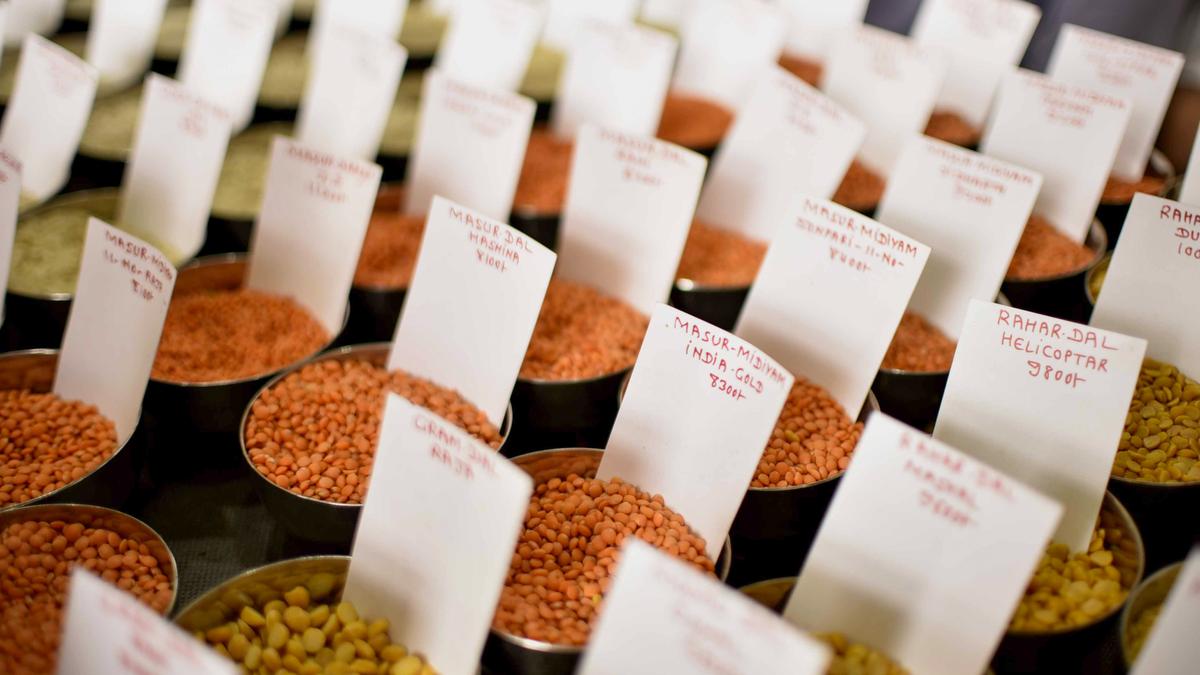
- 06 Sep 2025
In News:
Pulses hold a unique place in India’s agricultural economy, food security, and nutritional well-being. As a protein-rich staple in largely vegetarian diets, they not only address malnutrition but also contribute to sustainable farming through nitrogen fixation, low water requirements, and reduced carbon emissions. Despite being the world’s largest producer and consumer of pulses, India continues to import sizeable quantities, making self-reliance a critical national goal.
Current Scenario and Progress
India cultivates 12 pulse crops across kharif, rabi, and summer seasons, supported by diverse agro-climatic conditions. Production, however, is highly concentrated—Madhya Pradesh, Maharashtra, and Rajasthan together account for over 55% of total output, while the top 10 states contribute more than 91%.
Historically, the sector suffered from low yields and import dependence. Production declined to 16.35 million tonnes (MT) in 2015–16, forcing imports of nearly 6 MT. However, government interventions such as the National Food Security Mission (NFSM) and higher Minimum Support Prices (MSP) have significantly reversed this trend. By 2022–23, production surged by 59.4% to 26.06 MT, while productivity improved by 38%. Import dependence fell from 29% to just 10.4%, marking substantial progress.
Yet, challenges remain. Nearly 80% of pulses cultivation is rain-fed, leaving it vulnerable to monsoon fluctuations. The sector supports the livelihood of over five crore farmers, making policy stability and targeted support crucial.
NITI Aayog’s Roadmap
Recognising the pivotal role of pulses, NITI Aayog released a report titled “Strategies and Pathways for Accelerating Growth in Pulses towards the Goal of Atmanirbharta” in September 2025. The report projects domestic production to reach 30.59 MT by 2030 and 45.79 MT by 2047, thereby reducing imports and strengthening India’s food sovereignty.
Key Recommendations:
- Area Retention and Diversification – Establish region-specific crop clusters to optimise land use.
- Technology Adoption – Promote customised technologies suited for varied agro-ecological zones.
- Seed Quality and Distribution – Ensure timely availability of high-quality seeds, with special focus on 111 high-potential districts that account for 75% of national output.
- Cluster-Based Hubs – Implement the “One Block–One Seed Village” model through farmer producer organisations (FPOs) to enhance productivity.
- Mission for Atmanirbharta in Pulses – A six-year initiative targeting key crops such as pigeonpea, black gram, and lentil to fast-track self-sufficiency.
According to NITI Aayog, India could achieve self-sufficiency in pulses within the next decade if the current pace of growth is sustained.
Nutritional and Environmental Significance
Pulses are indispensable in addressing India’s protein deficiency and micronutrient gaps, particularly in iron and folate. Their role in combating hidden hunger makes them vital to achieving Sustainable Development Goals (SDGs) related to nutrition.
Environmentally, pulses act as natural soil enrichers through nitrogen fixation, reduce dependence on chemical fertilisers, and have a lower water footprint compared to cereals. Thus, scaling up their production aligns with both climate resilience and sustainable agriculture goals.
Conclusion
India has made commendable progress in reducing import dependence and improving productivity in pulses production over the past decade. However, achieving complete self-sufficiency requires sustained, region-specific strategies, robust seed systems, and technology-driven interventions. NITI Aayog’s roadmap, backed by focused initiatives like the Mission for Atmanirbharta in Pulses, provides a viable pathway.
By 2047, India not only aims to meet its domestic demand but also emerge as a global leader in pulses production—ensuring food security, nutritional well-being, and environmental sustainability for its growing population.
Regulating Social Media in India

- 03 Sep 2025
In News:
The Supreme Court of India, in a recent case concerning derogatory remarks by comedians, observed that social media influencers commercialise free speech, often blurring the line between legitimate expression and harmful speech. It stressed that while humour and satire are constitutionally protected, derogatory jokes against vulnerable groups perpetuate stigma and undermine inclusivity. The Court urged the Union Government to frame effective guidelines with enforceable consequences to ensure accountability in the digital space. This development underscores the growing debate on the regulation of social media in India.
Judicial Observations and Recommendations
- Commercialisation& Accountability: Free speech is increasingly monetised by influencers, creating overlaps with prohibited speech. Such expression cannot become a shield for targeting disadvantaged groups.
- Humour vs. Dignity: The Court emphasised that humour should not compromise dignity, particularly of persons with disabilities, women, children, minorities, and senior citizens.
- Guidelines with Consequences: Directed the Union Government, in consultation with industry bodies, to frame proportionate and enforceable rules.
- Digital Responsibility: Called for sensitisation and ethical conduct on social media, along with unconditional apologies for derogatory remarks.
Existing Legal and Regulatory Framework
- Information Technology Act, 2000 – Principal legislation for digital communication.
- Section 79(1): Provides safe harbour to intermediaries if they act neutrally.
- Section 69A: Allows government to block content for sovereignty, security, and public order.
- IT (Intermediary Guidelines and Digital Media Ethics Code) Rules, 2021 – Mandates due diligence, grievance redressal, and removal of unlawful content.
- 2023 Amendment – Required intermediaries to remove false/misleading content about the government; however, its enforcement was stayed by SC.
- Key Judicial Precedents:
- Shreya Singhal v. Union of India (2015): Struck down Section 66A of IT Act for vagueness, reaffirming free speech under Article 19(1)(a).
- K.S. Puttaswamy v. Union of India (2017): Recognised privacy as a fundamental right under Article 21, shaping later data protection measures.
Need for Regulation
- Protecting Vulnerable Groups: Prevents cyberbullying, trolling, and derogatory content.
- Curbing Misinformation & Hate Speech: Essential to check fake news, deepfakes, and extremist propaganda that threaten social harmony and security.
- Mental Health Safeguards: Addresses anxiety, depression, and addictive behaviours linked to excessive use.
- Influencer Accountability: Prevents consumer harm through undisclosed endorsements and fraudulent promotions.
- Data Privacy & Security: Ensures user rights under Article 21 are not compromised by exploitative data practices.
- Balancing Free Speech & Responsibility: Draws boundaries within Article 19(2) restrictions (public order, morality, security).
Challenges in Regulation
- High Volume & Anonymity: Makes monitoring difficult.
- Transparency Gaps: Platforms’ opaque moderation policies lack accountability.
- Defining Harmful Content: Subjectivity and cultural sensitivities complicate consensus.
- Risk of Overreach: Regulations can be misused as censorship.
- Cross-Border Jurisdiction: Large share of harmful content originates outside India.
- Political Neutrality Concerns: Allegations of bias in content moderation decisions.
Way Forward
- Comprehensive Legal Framework: Update IT Act with the proposed Digital India Act, ensuring balance of rights and responsibilities.
- Algorithmic Transparency: Mandate audits, reporting, and oversight of AI-driven content moderation.
- Institutional Capacity: Invest in cyber forensic labs and AI-enabled monitoring.
- Digital Literacy Campaigns: Encourage ethical online behaviour and awareness of misinformation.
- Global Cooperation: Strengthen cross-border regulatory partnerships and multi-stakeholder governance.
Conclusion
Regulating social media in India requires a balanced approach—one that safeguards freedom of expression under Article 19(1)(a) while addressing harms that erode dignity, social harmony, and democratic discourse. A mix of robust laws, technological innovation, ethical guidelines, and digital literacy can build a safe, inclusive, and accountable digital ecosystem aligned with India’s constitutional vision of justice, liberty, equality, and fraternity.
Civil Society in India: Strengthening Democracy and Human Dignity

- 02 Sep 2025
Introduction
Civil Society Organizations (CSOs) form the third pillar of democracy beyond the state and market, playing a crucial role in mobilizing communities, protecting rights, and addressing gaps in governance. From social reform movements of the 19th century to present-day advocacy for rights, CSOs have evolved into indispensable actors shaping India’s democratic landscape.
Evolution of Civil Society in India
- Ancient–Medieval roots: Guided by concepts of dharma, daan, and karma, religious and social movements emphasized community service.
- Pre-independence era: Organizations like Brahmo Samaj (1828), Theosophical Society (1879), and Ramakrishna Mission (1897) linked voluntary action with reform. Gandhiji’s philosophy of constructive work and self-reliance inspired mass mobilization.
- Post-independence: The First Five-Year Plan (1951–56) recognized voluntary action in development. The Panchayati Raj system deepened community participation. During the 1965–67 droughts, foreign aid through NGOs strengthened India’s civil society base.
- Contemporary era: CSOs shifted from welfare delivery to a rights-based approach, visible in the Chipko (1973) and Narmada Bachao (1985) movements, and campaigns for RTI, MGNREGA, RTE, and food security.
Today, India has around 1.5 million NGOs engaging over 19 million volunteers, though most remain small and resource-constrained.
Role of Civil Society in a Democracy
- Accountability and Transparency: Groups like Mazdoor Kisan Shakti Sangathan spearheaded the RTI Act (2005), strengthening citizen oversight. CSOs monitor elections, detect fraud, and counter corruption.
- Citizen Empowerment: They spread awareness of laws and rights, enabling participation of marginalized groups. For instance, Jagori and Swayam advanced women’s rights, while SEWA empowered informal sector workers.
- Social Justice and Inclusion: CSOs amplify voices of women, Dalits, Adivasis, and persons with disabilities. The Rights of Persons with Disabilities Act (2016) was shaped through sustained advocacy.
- Service Delivery and Humanitarian Work: During COVID-19, organizations like Goonj launched relief programmes. In healthcare, civil society has been pivotal in palliative care, advocating for dignity of terminally ill patients by mobilising volunteers, spreading awareness, and supplementing public health gaps.
- Leadership and Political Socialization: CSOs nurture grassroots leadership, especially among women in Panchayati Raj Institutions, challenging entrenched hierarchies.
- Global Governance: Indian CSOs engage with international human rights, climate change, and sustainable development discourses, influencing domestic reforms.
Challenges Facing Civil Society
- Regulatory hurdles: The FCRA (2010) and its 2020 amendment have restricted foreign funding, reducing financial independence.
- Funding constraints: Overdependence on international donors and weak domestic philanthropy limit sustainability.
- Internal undemocracy: Lack of transparency and inclusive decision-making undermines credibility.
- State–CSO friction: Governments often view rights-based activism as adversarial, creating tensions.
- Representation gaps: Elite capture and urban bias may sideline grassroots voices.
- Volunteer retention and professionalism remain persistent challenges.
Way Forward
- Enhancing transparency: Mandatory impact audits and a national CSO database can strengthen trust.
- Institutionalized consultation: Formal representation of CSOs in policy committees ensures evidence-based policymaking.
- Diversified funding: Domestic philanthropy, CSR initiatives, and social impact investing must be promoted.
- Simplified regulation: A single-window digital compliance system for registrations and reporting can reduce bureaucratic friction.
- Boosting volunteerism: Integrating service into school and university curricula can create a culture of civic participation.
Conclusion
Civil society in India has evolved from religious charity to rights-based activism, standing as a bridge between state and society. From advocating landmark legislations like RTI to ensuring the dignity of palliative care patients, CSOs embody participatory democracy in action. Strengthening their autonomy, inclusivity, and accountability is essential for a resilient, equitable, and responsive democracy.
Migration and Globalisation
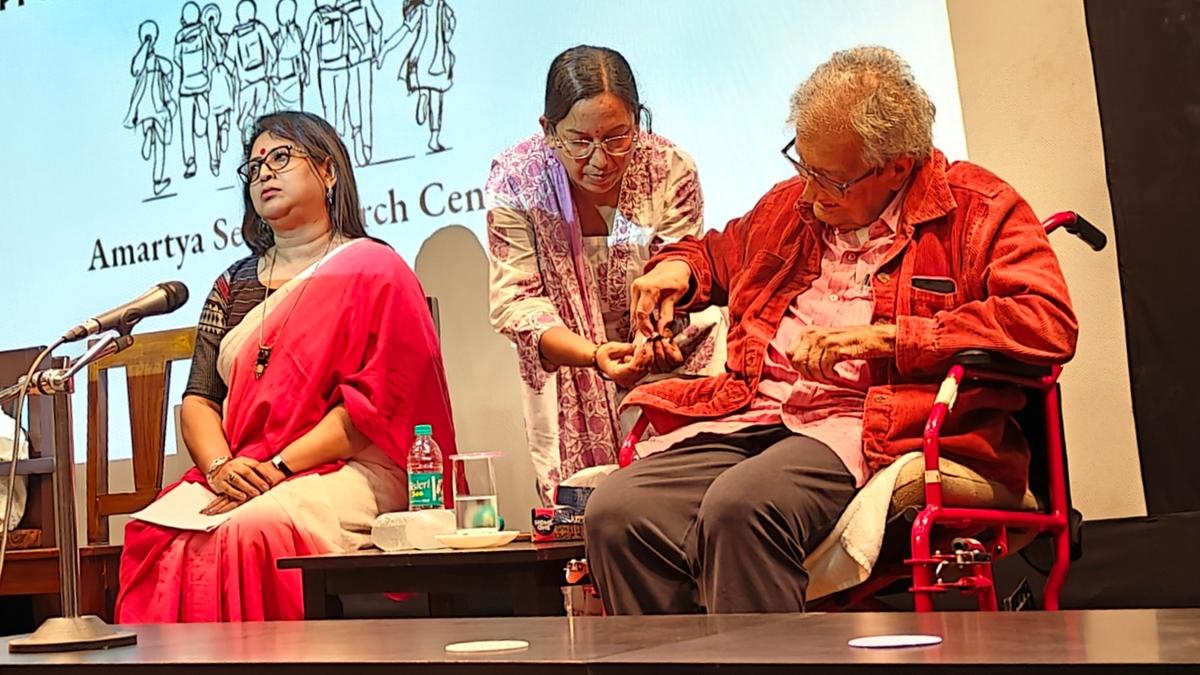
- 31 Aug 2025
Context:
Migration has historically been central to human survival, cultural enrichment, and economic development. Nobel laureate Amartya Sen, in a recent interaction with students in Kolkata (August 2025), underlined that migration is not merely a by-product of globalisation but an essential driver of it. He argued that without the movement of people, exchange of ideas, and diversity, “almost nothing would happen” in society. His observations highlight the need to place migration at the core of discussions on inclusive development and global integration.
Migration and Globalisation: A Two-Way Link
Migration represents both a cause and consequence of globalisation. The growing interconnectedness of economies, labour markets, and cultures compels people to move in search of livelihood, education, and security. Conversely, migration sustains the very processes of globalisation by ensuring labour mobility, knowledge transfer, and cultural exchange.
Remittances from international migrants significantly support local economies in poorer regions, while in ageing industrial societies, migrants fill labour shortages and keep welfare systems functional. Similarly, internal migration within developing countries responds to shifts in industrial location and the expansion of tourism, service, and construction sectors.
Economic and Social Contributions of Migrants
Migration plays a critical role in sustaining households and reshaping communities:
- Economic Support: Remittances are often the backbone of rural economies, enabling investments in agriculture, housing, and small enterprises.
- Skill Transfer: Return migrants bring exposure, technology, and non-farm opportunities, provided there is institutional support.
- Cultural Exchange: Migrants enrich host societies by introducing new languages, cuisines, music, and traditions, fostering cosmopolitan growth.
- Empowerment: For many youth and women, migration becomes a pathway to independence, autonomy, and expanded life choices.
Sen himself cited historical examples—such as Arabic translations of Brahmagupta’s mathematical works—that demonstrate how migration and cultural contact drive intellectual advancement.
Key Challenges
Despite its benefits, migration remains highly contested. Restrictive immigration policies in developed nations often strengthen illegal smuggling networks and leave migrants vulnerable to exploitation. Within India, internal migrants frequently face exclusion from basic urban services such as housing, education, and healthcare.
Undocumented and unskilled migrants are particularly prone to labour exploitation, earning low wages under insecure conditions. Women migrants confront additional gender disparities, ranging from wage inequality to social stigma, although they can emerge as strong agents of change where given resources and support.
Policy Imperatives
Migration must be recognised not as a threat but as an enabler of development. The policy framework should:
- Protect migrant rights and improve workplace safety.
- Facilitate the productive use of remittances through training, financial literacy, and infrastructure.
- Ensure equitable access to resources for women migrants.
- Address structural constraints such as rural distress, which force people into migration as a survival strategy.
India has already witnessed tensions, including attacks on migrant workers from West Bengal in other states, highlighting the urgency of a protective and inclusive approach.
Conclusion
Migration is inseparable from globalisation and has historically propelled human progress. It strengthens economies, sustains welfare systems, and enriches cultures. Yet, the absence of supportive policies leaves migrants vulnerable to exclusion and exploitation. As Amartya Sen emphasised, diversity is the foundation of Indian society and the movement of people is the essence of globalisation. Recognising migrants as partners in development rather than problems to be managed is essential for building an inclusive, equitable, and resilient global future.
UGC Draft Curriculum Highlights Ancient Wisdom in Higher Education
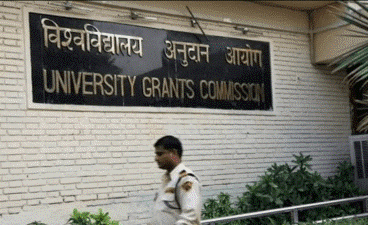
- 30 Aug 2025
Background
The University Grants Commission (UGC) has released a draft Learning Outcomes-based Curriculum Framework (LOCF) for undergraduate programmes in fields such as anthropology, chemistry, commerce, economics, geography, mathematics, political science, home science, and physical education.
A defining feature of this framework is the inclusion of Indian Knowledge Systems (IKS), aiming to blend traditional philosophies and practices with contemporary pedagogy. The draft has been made public for feedback from stakeholders.
Integration of Indian Knowledge Systems
The framework seeks to position higher education within India’s cultural and intellectual heritage, reflecting the vision of the National Education Policy (NEP) 2020, which emphasiseddecolonisation of curricula and recognition of indigenous wisdom.
Every subject has been asked to incorporate aspects of Indian traditions, linking them to modern learning outcomes.
Subject-Wise Highlights
- Mathematics
- Modules on mandala geometry, yantras, rangoli, kolam as algorithmic art forms.
- Study of temple architecture through ?y?di ratios.
- Contributions of Indian mathematicians in arithmetic, algebra, geometry, and calculus, and their influence on global traditions.
- Commerce
- Incorporation of Bhartiya philosophy and Gurukul pedagogy, focusing on holistic learning.
- Study of Kautilya’sArthashastra for insights into trade and financial systems.
- Ideas like Ram Rajya, Shubh-labh (profit with responsibility), CSR, and ESG frameworks integrated into modern governance discussions.
- Economics
- Emphasis on dharmic perspectives on wealth and prosperity.
- Exploration of indigenous exchange systems, agrarian values, dana (charity), and state-led economic roles.
- Ethical trade and collective enterprise highlighted as core themes.
- Chemistry
- Introduction of traditional Indian fermented drinks (kanji, mahua, toddy) in modules on alcoholic beverages.
- Integration of parmanu (ancient atomic concept) with modern atomic theory.
- Anthropology
- Curriculum draws on Charaka, Sushruta, Buddha, and Mahavira, focusing on their insights into the relationship between culture and nature.
Criticism and Concerns
- While NEP 2020 promotes interdisciplinarity, the LOCF allocates a large portion of credits to single-major courses. For example, chemistry students must take 96 out of 172 credits in core courses, reducing scope for cross-disciplinary learning.
- Critics, including some opposition-led states, allege that the draft encourages “saffronisation” of education.
- The key challenge lies in ensuring that cultural heritage is respected while preserving academic rigour, scientific temper, and global competitiveness.
Significance
The draft framework represents a paradigm shift in Indian higher education, with potential to:
- Decolonise curricula by embedding indigenous systems.
- Offer culturally rooted yet globally relevant education.
- Encourage ethical, sustainable practices across professional fields.
- Highlight India’s contributions to mathematics, medicine, governance, and economics.
Way Forward
The draft is currently open for feedback and may be revised before implementation. If adopted, it could reshape the intellectual foundation of higher education, grounding it more deeply in India’s heritage while aligning with international standards.
The real challenge, however, will be to ensure that ancient wisdom complements — rather than replaces — critical thinking, scientific inquiry, and multidisciplinary exploration.
Why India needs a national space law urgently
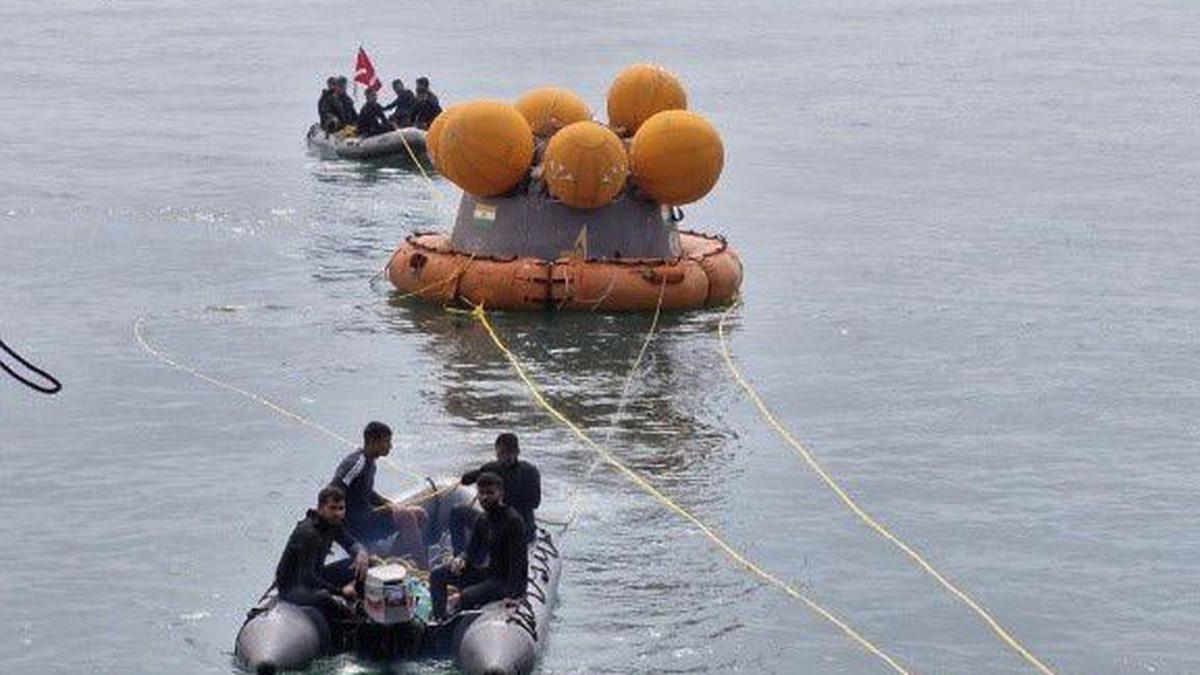
- 22 Aug 2025
In News:
India’s space programme has made remarkable strides in recent years, with missions such as Chandrayaan-3, the upcoming Gaganyaan human spaceflight, and plans for the Bharat Antariksh Station. Alongside, private participation in launch services, satellite communication, and space-based applications has grown significantly. However, despite being a signatory to key international treaties like the Outer Space Treaty (OST) 1967, India still lacks a comprehensive national space legislation. This gap creates uncertainty for private enterprises, investors, and regulators, making a space law an urgent necessity.
International Context and Treaty Obligations
The OST of 1967 provides foundational principles:
- Outer space as the common heritage of mankind with no claims of sovereignty.
- Activities limited to peaceful purposes and free scientific exploration.
- State responsibility for activities conducted by both government and non-government actors.
- Liability of states for damage caused by space objects launched from their territory.
While India is bound by these obligations, the treaty is not self-executing. National legislation is required to translate these commitments into enforceable domestic rules. Many countries such as the U.S., Luxembourg, Japan, and UAE have enacted laws clarifying ownership, licensing, and liability frameworks, thereby attracting global investments in their space sectors.
India’s Current Approach
India has followed an incremental strategy, relying on policies and guidelines rather than legislation:
- Indian Space Policy, 2023 → opens space activities to private players.
- IN-SPACe Norms and Guidelines, 2024 → provides authorization mechanisms.
- Catalogue of Indian Standards for Space Industry, 2023 → ensures safety and quality.
However, these are executive measures without statutory authority. The Indian National Space Promotion and Authorisation Centre (IN-SPACe) currently functions without legal backing, undermining its ability to act as a credible single-window regulator.
Key Challenges in the Absence of a Law
- Regulatory Fragmentation: Space activities involve multiple ministries (Defence, Telecom, Commerce, DoS), leading to duplication and delays. For instance, satellite communication projects require parallel clearances from DoT, Defence, and ISRO.
- Liability Concerns: Under OST, India is internationally liable for damages caused by private launches. Without domestic liability-sharing norms, startups face prohibitive insurance costs.
- FDI Uncertainty: India allows partial FDI in satellite manufacturing, but unclear automatic routes deter investors. Competitor nations offer liberal FDI frameworks, drawing startups away.
- Intellectual Property Issues: Ambiguity in IP ownership discourages innovation and risks talent migration to IP-friendly jurisdictions.
- Innovation Barriers: Overlapping clearances and unclear rules delay project timelines, stifling private-sector growth.
Way Forward
- Comprehensive Space Activities Law: Clearly define licensing, liability, insurance, IP rights, and dispute resolution in line with OST.
- Statutory Empowerment of IN-SPACe: Grant it legal authority as an independent single-window regulator with transparent, time-bound processes.
- Insurance Framework: Establish government-backed reinsurance pools to make liability coverage affordable for startups.
- Liberalised FDI Norms: Allow 100% FDI in satellite component manufacturing under the automatic route with safeguards for national security.
- IP and Innovation Ecosystem: Protect private patents, encourage industry–academia collaboration, and retain domestic talent.
Conclusion
India stands at a decisive moment in its space journey. The absence of a comprehensive space law risks slowing down private participation, deterring investment, and exposing the country to unmitigated liability under international law. Enacting robust legislation would not only provide clarity and predictability but also align India with global best practices, nurture its commercial space ecosystem, and position it as a trusted global leader in space governance. With India aspiring to host major international space events and expand its presence in global markets, the urgency for a national space law has never been greater.
India’s Unique Genetic Legacy
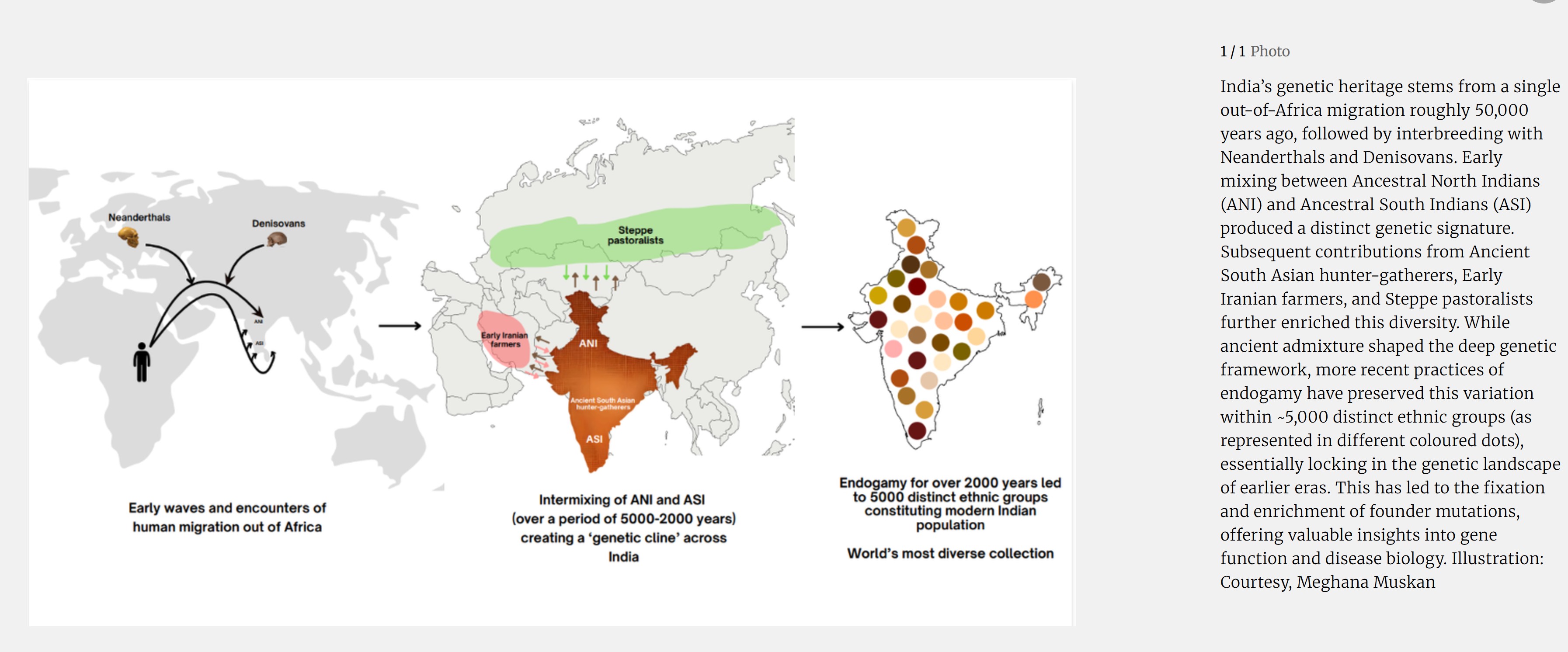
- 17 Aug 2025
Context:
India, with a population of over 1.4 billion and nearly 5,000 distinct ethnic groups, represents one of the richest reservoirs of human genetic diversity in the world. This diversity, shaped by ancient migrations, interbreeding with archaic humans, and centuries of endogamy, makes India a living archive of evolutionary history as well as a frontier for personalised medicine.
Evolutionary Roots and Genetic Mixing
The genetic history of Indians can be traced to a single out-of-Africa migration around 50,000 years ago. These early settlers interbred with archaic humans such as Neanderthals and Denisovans, leaving modern populations with 1–2% of archaic DNA. Some of these variants continue to influence present-day biology—for example, Denisovan genes aiding Tibetan high-altitude adaptation and Neanderthal genes linked to immune responses and even COVID-19 severity.
Within India, genetic blending between Ancestral North Indians (ANI) and Ancestral South Indians (ASI) created a distinct genetic signature. Later contributions from ancient hunter-gatherers, early Iranian farmers, and Steppe pastoralists added further complexity. This intricate demographic history is preserved in the unique genomic architecture of Indian populations, which remains poorly represented in global studies such as the UK Biobank or 1000 Genomes Project.
Endogamy and Disease Patterns
A distinctive feature of Indian society has been endogamy, or marrying within one’s community. While this preserved ancient traits, it also intensified genetic relatedness and strengthened “founder effects.” As a result, many rare recessive diseases occur at unusually high frequencies within specific groups.
For instance, the Vysya community shows a hundred-fold higher prevalence of butyrylcholinesterase deficiency, while other groups carry unique mutations linked to progressive pseudorheumatoid dysplasia or congenital disorders. Large-scale genome sequencing of ~2,700 Indians revealed that each person, on average, has at least one fourth-degree relative, underscoring the depth of relatedness. More than 1.6 lakh previously unreported variants have been identified, many linked to neurological, metabolic, and cardiovascular conditions.
Scientific and Healthcare Potential
This diversity is not merely of anthropological interest but holds transformative implications for medicine. Each Indian community functions as a natural genetic laboratory, preserving rare variants that allow scientists to study gene functions without laboratory-induced mutations. This provides an unprecedented opportunity to advance precision medicine, drug discovery, and disease prevention strategies tailored to Indian populations.
The Genome India Project, which has already sequenced 10,000 genomes, is a milestone towards this goal. Scaling it to millions of individuals, coupled with the creation of a national biobank on the lines of the UK Biobank, could position India as a global hub for genome-driven healthcare and innovation.
Challenges and Way Forward
Despite these opportunities, India faces major gaps. Representation in international genomic databases remains minimal. The risks of genetic discrimination and privacy breaches call for a robust ethical and legal framework. Moreover, integrating genetic screening into public health policy requires awareness campaigns, trained professionals, and equitable access to avoid deepening existing inequalities.
Conclusion
India’s genetic mosaic is both a scientific treasure and a public health imperative. By scaling up sequencing, building inclusive biobanks, and embedding genomics into healthcare policy, India can simultaneously improve disease management, reduce the burden of rare disorders, and emerge as a leader in global genomics research. With foresight, investment, and ethical safeguards, India’s genetic legacy can be harnessed to transform healthcare and strengthen its knowledge economy.
Judicial Pendency in India
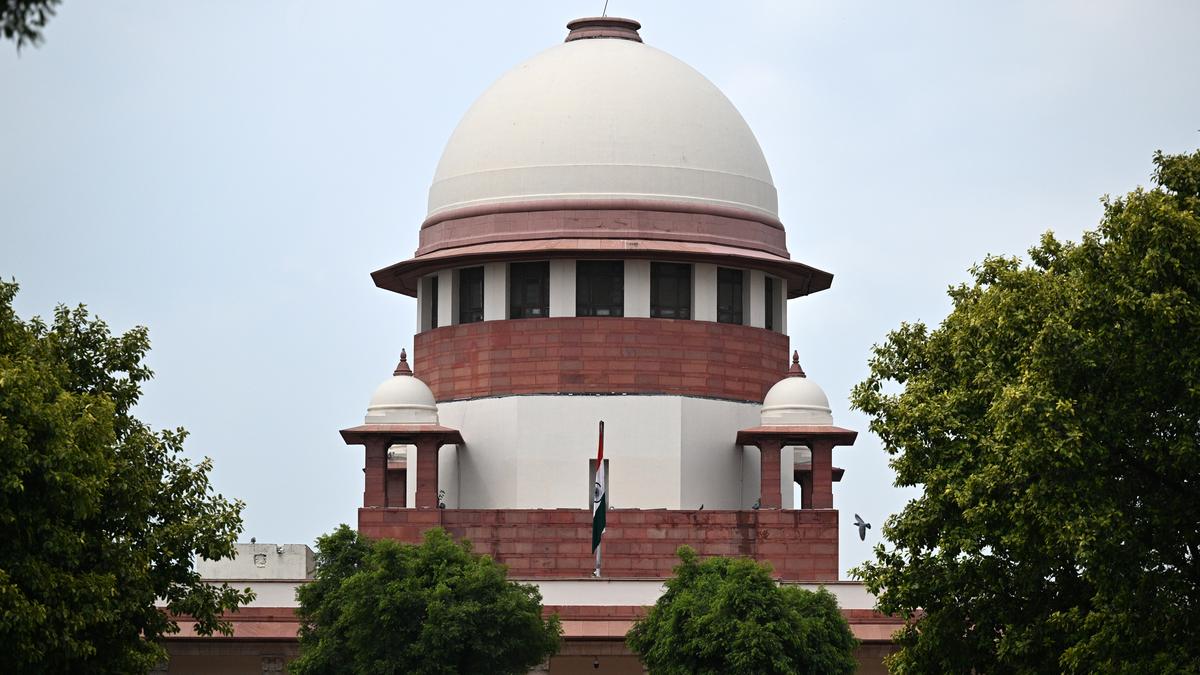
- 14 Aug 2025
In News:
The Indian judiciary today faces an unprecedented backlog of over 5 crore pending cases across all levels—Supreme Court, High Courts, and District Courts. This crisis not only weakens the justice delivery system but also erodes citizen trust in governance and constitutional values.
Magnitude of Pendency
As of mid-2025:
- District Courts account for nearly 90% of pendency, with 4.6 crore+ cases.
- High Courts face a backlog of 63.3 lakh+ cases.
- The Supreme Court has 86,700+ pending cases.
A notable disparity exists between criminal and civil case disposal. While 85.3% of criminal cases in High Courts are resolved within a year, only 38.7% of civil cases in district courts meet this timeline. Alarmingly, nearly 20% of civil cases remain unresolved for more than five years. The Chief Justice of India has flagged the issue of excessive caution in granting bail as one contributor to this delay.
Causes of Judicial Pendency
- Low Judge-Population Ratio: With only 15 judges per 10 lakh population, India lags behind the Law Commission’s recommendation of 50 judges per million. Though women constitute 38% of lower judiciary, their representation in High Courts remains at just 14%.
- Adjournment Culture: Excessive adjournments worsen pendency. A Delhi High Court study found 70% of delayed cases involved over three adjournments, leading to the infamous “tareek pe tareek” phenomenon.
- Underutilized ADR: Mediation, arbitration, and conciliation are not fully tapped despite their cost-effectiveness. Absence of comprehensive ADR performance data further hampers evaluation.
- Rising Litigation: Greater legal awareness, increasing PILs, and non-meritorious cases fuel the backlog. Notably, nearly half of pending cases involve government departments, where routine appeals prolong litigation.
- Structural Deficits: Shortage of courtrooms, staff, weak ICT systems, delays in evidence and witness availability, and lack of case management frameworks further strain judicial functioning.
Reform Initiatives
- National Mission for Justice Delivery and Legal Reforms (2011): Enhancing access and efficiency.
- e-Courts Project: Paperless filing, virtual hearings, faster processing.
- Fast Track Special Courts: Speedy trials for specific offences.
- Tele-Law & Nyaya Bandhu: Expanding legal aid through technology and pro bono services.
- Appointments: Between 2014–2024, 62 Supreme Court and 976 High Court judges were appointed; district courts saw strength rise from 19,518 to 25,609.
Lok Adalats remain highly effective, having disposed of 27.5 crore cases between 2021–2025.
Strengthening the Judicial System
- Capacity Expansion: Raise judge strength to 50 per million, expedite appointments, enhance collegium transparency, and establish specialized courts.
- Infrastructure & Technology: Create a National Judicial Infrastructure Authority, expand e-Courts, use AI for case clustering and tracking, and adopt tools like FASTER for electronic transmission of orders.
- Procedural Reforms: Enforce strict limits on adjournments, adopt summary trials, pre-trial conferences, and time-bound hearings.
- Promote ADR: Effective implementation of the Mediation Act, 2023, expansion of arbitration centres, and scaling up of Lok Adalats can significantly reduce court burden.
- Legal Access: Strengthen Tele-Law, legal aid clinics, and NALSA’s outreach for marginalized groups.
Conclusion
India’s judiciary stands at a crossroads. The sheer volume of pending cases undermines the principle that “justice delayed is justice denied.” Addressing judicial vacancies, modernizing infrastructure, embracing technology, and institutionalizing ADR mechanisms are no longer policy options but constitutional imperatives. Strengthening the justice delivery system is vital not only for effective governance but also for sustaining the rule of law and democratic trust.
ESG Oversight and the Challenge of Greenwashing in India
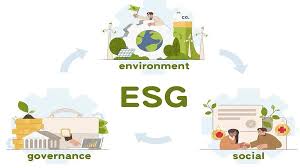
- 13 Aug 2025
Introduction
Environmental, Social, and Governance (ESG) practices are increasingly shaping corporate accountability and sustainable development worldwide. In India, where environmental degradation, social inequality, and governance failures remain pressing challenges, ESG assumes even greater significance. Recognising rising risks of greenwashing—the practice of making false or exaggerated sustainability claims—a Parliamentary Standing Committee on Finance has recently recommended the establishment of a dedicated ESG oversight body under the Ministry of Corporate Affairs (MCA).
Understanding ESG
- Environmental: Evaluates a company’s impact on the climate, energy use, waste management, and biodiversity.
- Social: Measures inclusivity, labour standards, community engagement, and equitable growth.
- Governance: Focuses on transparency, ethical decision-making, compliance, and protection of shareholder interests.
In India, ESG is critical because of:
- Climate vulnerability: India experienced 322 extreme weather days in 2024 (CSE), making sustainability practices urgent.
- Social concerns: Persistent poverty and inequality require businesses to prioritise inclusivity.
- Governance needs: Strong corporate ethics help attract investment and build long-term trust.
Key Recommendations of the Standing Committee
- ESG Oversight Authority: A specialised body under MCA to verify sustainability claims, detect fraud, and design sector-specific ESG guidelines.
- Strengthening Legal Mandate: Amendments to the Companies Act, 2013 to embed ESG responsibilities into directors’ duties, making sustainability a core element of business strategy.
- Support for MSMEs: Providing frameworks and guidance to help small enterprises adopt ESG without excessive compliance burden.
- Deterrence Measures: Faster penalties for false claims to curb greenwashing.
- Strengthening Institutions: Empowering SFIO and NFRA to detect financial crimes linked with ESG misreporting.
- CSR Transparency: Better monitoring to ensure Corporate Social Responsibility efforts are genuine and impactful.
India’s ESG Initiatives
- SEBI’s BRSR Framework: Mandates top 1,000 listed companies to disclose ESG performance, aligned with international norms like GRI and SASB.
- CSR Mandate (Companies Act, 2013): Encourages companies to invest in social and environmental causes.
- Green Rating Project (CSE): Rates industries on environmental performance.
The Challenge of Greenwashing
Greenwashing undermines ESG credibility by misleading consumers and investors. It often involves vague labels (“eco-friendly,” “natural”), token CSR activities, or misuse of traditional systems like Ayurveda to project sustainability without genuine practices.
Factors driving greenwashing in India
- Eco-consumerism: Rising demand for sustainable goods, especially among youth.
- Weak enforcement: Non-mandatory standards like BIS Eco-Mark limit accountability.
- Fragmented regulations: ESG rules spread across multiple agencies, creating compliance gaps.
- Cultural exploitation: Misuse of heritage-based terms for marketing.
- CSR marketing: Highlighting symbolic actions while continuing harmful operations.
Regulatory Safeguards
- Consumer Protection Act, 2019: Central Consumer Protection Authority can penalise misleading environmental claims.
- ASCI Guidelines: Ensure environmental claims in advertising are evidence-based.
- Plastic Waste Management Rules: Aim to regulate reduction claims, though gaps remain.
Conclusion
The rise of ESG reflects India’s journey towards balancing economic growth with sustainability and ethics. However, greenwashing threatens this transition, diluting genuine efforts. The Parliamentary Committee’s recommendation for a centralised ESG oversight authority is timely, offering a pathway to ensure accountability, strengthen investor confidence, and align India’s corporate governance with global sustainability standards.
For India, integrating ESG into the corporate ethos is not merely regulatory compliance—it is a strategic imperative for long-term resilience, social equity, and climate security.
Groundwater Contamination in India
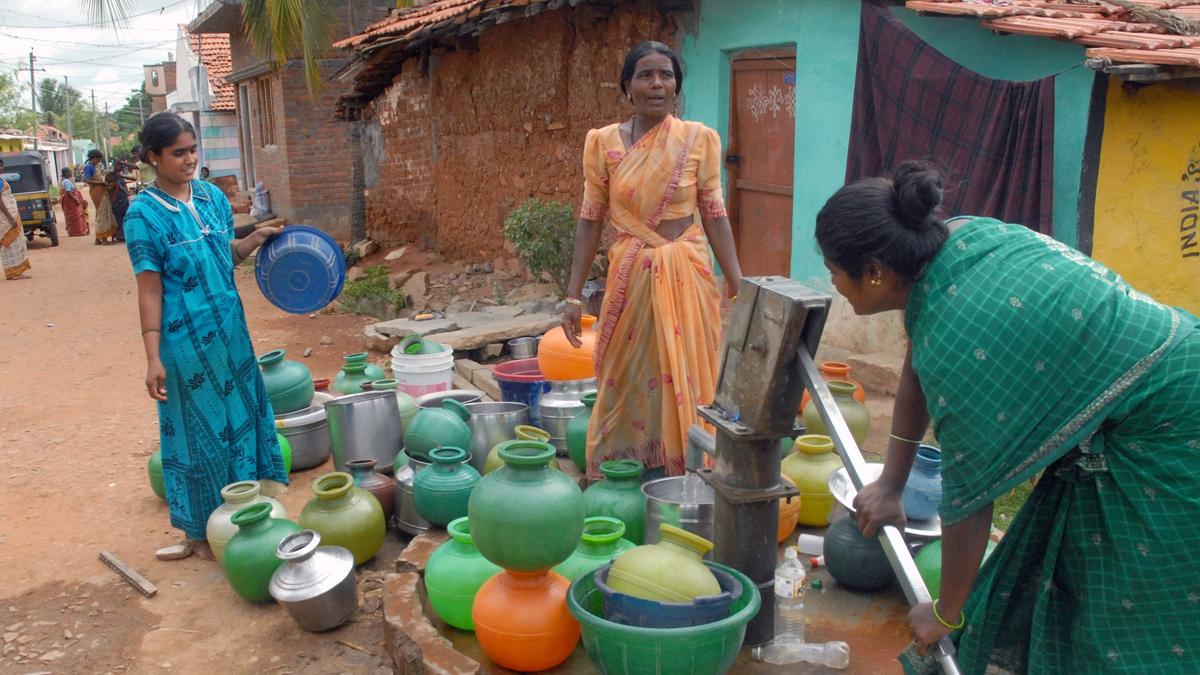
- 12 Aug 2025
Introduction:
Groundwater is the backbone of India’s water economy, meeting more than 85% of rural drinking water needs and nearly 65% of irrigation requirements. Traditionally considered a safe and abundant source, aquifers are now increasingly threatened by rising contamination. The presence of nitrates, fluoride, arsenic, uranium, heavy metals, and pathogens in groundwater is creating a silent but severe public health and environmental crisis.
Scale of the Crisis
The 2024 Central Ground Water Board (CGWB) Report highlights contamination across 440 districts, exposing millions to serious health risks. Unlike droughts or floods, groundwater contamination is invisible, cumulative, and often irreversible, making it a formidable challenge to long-term water security.
Sources of Contamination
1. Anthropogenic (Human-Induced):
- Agricultural runoff: Excessive use of fertilisers and pesticides leads to nitrate and phosphate leaching.
- Industrial discharge: Toxic heavy metals like lead, cadmium, and mercury infiltrate aquifers.
- Sewage & septic leakage: Untreated wastewater contaminates rural and peri-urban groundwater.
- Fuel leakage: Petroleum seepage further pollutes drinking water sources.
2. Geogenic (Natural):
- Fluoride: Naturally present in rocks, aggravated by over-extraction.
- Arsenic: Mobilised in Gangetic aquifers due to pumping.
- Uranium: Present in certain geological formations, worsened by phosphate fertiliser use.
Key Contaminants and Health Impacts
|
Contaminant |
Source |
Health Impacts |
Hotspot Regions |
|
Nitrates |
Fertilisers, sewage |
“Blue Baby Syndrome”, cancer risk |
Punjab, Haryana, Karnataka |
|
Fluoride |
Geogenic, fertilisers |
Dental & skeletal fluorosis |
Rajasthan, Andhra Pradesh, Telangana |
|
Arsenic |
Geogenic, over-pumping |
Skin lesions, gangrene, cancer |
Bihar, W. Bengal, Uttar Pradesh |
|
Uranium |
Geogenic, fertilisers |
Kidney & organ toxicity |
Punjab (Malwa), Rajasthan |
|
Heavy Metals |
Industrial waste |
Neurological damage, anaemia |
Kanpur, Vapi |
|
Pathogens |
Sewage leaks |
Cholera, dysentery, hepatitis |
Odisha, Uttar Pradesh |
- Fluoride contamination affects 230 districts, with 66 million people suffering from fluorosis.
- In Jhabua (M.P.), fluoride exceeds 5 mg/L, affecting nearly 40% of tribal children.
- Arsenic in the Gangetic belt has led to skin cancer, gangrene, and respiratory illness.
- Uranium levels in Punjab’s Malwa region exceed WHO limits, causing kidney and organ damage.
- Hospital admissions due to nitrate-linked illnesses rose by 28% in five years.
Structural and Governance Challenges
- Fragmented Institutional Framework: CGWB, CPCB, SPCBs, and Ministry of Jal Shakti work in silos.
- Weak Legal Enforcement: The Water Act, 1974 scarcely covers groundwater quality.
- Poor Monitoring: Infrequent testing, outdated equipment, lack of real-time public data.
- Over-Extraction: Falling water tables concentrate contaminants and draw geogenic toxins.
- Waste Mismanagement: Industrial discharges and poor sewage treatment remain unchecked.
Policy and Reform Recommendations
1. Legal & Institutional Strengthening
- Empower CGWB with statutory powers for regulation.
- Create a National Groundwater Pollution Control Framework.
2. Monitoring & Surveillance
- Deploy real-time quality sensors and remote sensing tools.
- Integrate groundwater monitoring with public health systems (HMIS, IHIP).
3. Targeted Mitigation
- Establish arsenic and fluoride removal plants in hotspots.
- Expand Jal Jeevan Mission’s piped water supply to reduce reliance on contaminated wells.
4. Industrial & Wastewater Management
- Mandate Zero Liquid Discharge (ZLD) for industries.
- Regulate landfills and industrial clusters with stringent penalties.
5. Agricultural Reforms
- Promote organic farming and integrated nutrient management.
- Rationalisefertiliser use through pricing reforms and farmer awareness.
6. Community Engagement
- Involve panchayats, SHGs, and water user groups in quality monitoring.
- Launch school-based water literacy campaigns for behavioural change.
Conclusion
Groundwater contamination in India is more than an environmental issue; it is a public health emergency with far-reaching consequences for society, economy, and sustainability. If left unaddressed, millions will continue to suffer chronic illnesses, agricultural productivity will decline, and water insecurity will worsen. A comprehensive strategy combining science, governance, technology, and community participation is urgently required. Without immediate intervention, India risks an irreversible water and health crisis, undermining both its developmental trajectory and the well-being of future generations.
Commemoration of 80 Years Since Hiroshima and Nagasaki
- 11 Aug 2025
In News:
August 2025 marks 80 years since the atomic bombings of Hiroshima (6 August) and Nagasaki (9 August) in 1945, events that not only ended World War II but heralded the beginning of the nuclear age. These bombings remain the only wartime use of nuclear weapons, claiming over 150,000 to 246,000 lives, predominantly civilians, by the end of 1945.
From Stalemate to Nuclear Intervention
- Pearl Harbor (7 December 1941) instigated U.S. entry into WWII and initiated several brutal battles across the Pacific—the likes of Guadalcanal, Iwo Jima, and Okinawa—underscoring the mounting cost of a ground invasion of Japan.
- Japan’s continued resistance despite devastating firebombing campaigns (notably Tokyo in March 1945) and the Potsdam Declaration (July 1945) demanding surrender set the stage for nuclear escalation.
- The Manhattan Project, secret since 1942, culminated in the Trinity test (16 July 1945), proving the atomic bomb's feasibility.
The Bombings Unfold
- Hiroshima (6 August 1945): ‘Little Boy’, a uranium-fission bomb dropped by the B-29 Enola Gay, caused roughly 80,000 immediate deaths; total fatalities reached ~140,000 by end of that year.
- Nagasaki (9 August 1945): ‘Fat Man’, a plutonium-fueled implosion device, dropped amid weather delays on Kokura, killed about 40,000 immediately—totaling ~70,000 by year-end.
Motives Behind the Bombing
- Avoiding invasion casualties: Operation Downfall, the planned invasion, projected massive Allied and Japanese losses.
- Psychological pressure: The bomb's unprecedented devastation aimed to force Japan's surrender.
- Geo-strategic signaling: The bombings demonstrated U.S. might—curbing Soviet advances—and launched the world into a new Cold War dynamic.
- Domestic justification: Following decades and billions invested into the Manhattan Project, prevailing sentiment demanded usage for war-ending impact.
The Aftermath and Long-Term Impact
- Japan surrendered on 14 August 1945, formalizing it on 2 September aboard USS Missouri.
- The nuclear age dawned, introducing doctrines like Mutual Assured Destruction (MAD) and fueling a global arms race visible in treaties and strategic postures to this day.
- Institutions like the Hiroshima Peace Memorial (Genbaku Dome) were later established as symbols for peace and reminders of nuclear risks.
Legacy: Memory and Contemporary Discourse
- Each year, Hiroshima and Nagasaki hold solemn ceremonies—featuring lanterns, peace pledges, and remembrance—to honour victims and renew calls for nuclear disarmament.
- Survivors (hibakusha) testimonials, such as shared during the 80th anniversary, continue to fuel global nuclear abolition movements.
- Contemporary debates persist: while some argue the bombings were a necessary evil to hasten peace, others denounce them as moral travesties — a discourse still evolving with new declassified archival evidence.
Conclusion
The atomic bombings of Hiroshima and Nagasaki were more than wartime events—they ushered in a nuclear epoch marked by existential security threats, ideological competition, and ethical dilemmas. As the world reflects on this 80th anniversary, it must balance historical comprehension with vigilant advocacy for disarmament, remembering that nuclear weapons’ destructive legacy persists, as relevant and grave as ever.
Slums in Flood-Prone Areas: India’s Dual Challenge of Urbanisation and Climate Risks
- 04 Aug 2025
In News:
A global study published in Nature Cities has revealed that India has the highest number of slum clusters in flood-prone areas worldwide, underscoring the nexus between rapid urbanisation, poverty, and increasing climate-related risks. This trend highlights both developmental and governance challenges for India as it seeks to balance inclusive growth with climate resilience.
Global Trends in Flood Risk and Slum Settlements
- India at the Forefront: Over 158 million slum dwellers live in flood-prone areas in India, particularly in the Ganga delta. Nearly 40% of slum residents inhabit high-risk urban and peri-urban zones.
- Regional Pattern: India is followed by Indonesia, Bangladesh, and Pakistan in terms of vulnerable populations. Globally, slum dwellers are 32% more likely to reside in floodplains than other communities.
- Global South Impact: About 33% of informal settlements in low- and middle-income countries are already exposed to flooding. Hotspots include Rwanda, Morocco, and coastal Brazil.
- Cities at Risk: High slum density correlates with flood-prone megacities such as Mumbai and Jakarta.
Drivers of Flood Vulnerability in India
- Riverine Floods: Frequent in the Brahmaputra, Ganga, and Krishna basins, driven by monsoon rains, snowmelt, and dam-related issues.
- Urban Expansion: Between 1985–2015, India ranked third globally in urban growth into flood-prone areas. Cities like Mumbai and Bengaluru have expanded into natural floodplains.
- Flash Floods: Incidents rose from 132 (2020) to 184 (2022), with severe events in Himachal Pradesh (2025), Wayanad (2024), Ladakh (2024), and Sikkim (2023).
- 75% of flash floods stem from a mix of extreme rainfall and saturated soils.
- Climate Change: Between 1981–2020, extreme rainfall events doubled, with monsoon rains intensifying by 56%, raising flood frequency.
- Poor Drainage & Encroachments: Urban floods in Delhi, Mumbai, Hyderabad, and Chennai worsened by clogged drains and plastic waste (e.g., Chennai floods 2015).
- Weak Local Planning: Absence of region-specific flood risk assessments hampers effective urban land-use planning and disaster preparedness.
Slums in India: Extent and Challenges
- Definitions:
- Pranab Sen Committee (2010) – compact settlements of ≥20 households with poor housing, sanitation, and water facilities.
- UN-Habitat – lack of durable housing, secure tenure, sufficient living space, safe water, or sanitation.
- Census 2011: 17% of urban India lived in 1.39 crore slum households.
- NSSO 2012: 33,510 slums identified nationwide.
- Hotspot States: Maharashtra, Andhra Pradesh, Uttar Pradesh, and West Bengal.
- Major Cities: Mumbai and Kolkata host some of the densest slum populations.
- Regulation: The Slum Areas (Improvement and Clearance) Act, 1956 governs slum rehabilitation in Union Territories; “Land” and “Colonisation” are State subjects.
Existing Initiatives
- Pradhan Mantri Awas Yojana – Urban (PMAY-U): Pucca houses with amenities; as of Dec 2024, 118.64 lakh houses sanctioned, 29 lakh for slum dwellers.
- AMRUT & Smart Cities Mission: Infrastructure upgrades in water, sanitation, and drainage.
- Swachh Bharat Mission – Urban 2.0: Target of garbage-free cities.
- IFLOWS-Mumbai and CFLOWS-Chennai: Integrated flood warning systems.
Way Forward: Towards Sustainable Urban Flood and Slum Management
- Region-Specific Flood Strategies: Based on topography and soil; integrate into the National Disaster Management Plan (NDMP).
- Restrict Expansion into Floodplains: Enforce zoning laws and incorporate flood-resilient infrastructure under Smart Cities Mission.
- Sustainable Urban Drainage Systems (SUDS): Rain gardens, permeable pavements, and green spaces.
- Upgrading Slums: Use PMAY-U for resilient housing, raised plinths, and better drainage.
- Data-Driven Risk Mapping: Use NRSC, IMD, and satellite imagery to monitor risks and emerging hotspots.
- Sponge City Model: Adopt Shanghai-style rainwater absorption systems; Mumbai has begun implementing this.
- Eco-Restoration of Water Bodies: Revive urban lakes/wetlands (e.g., Jakkur Lake in Bengaluru) for natural flood control.
- Climate Adaptation Mainstreaming: Integrate climate resilience into urban planning and housing policies.
Conclusion
India’s dual challenge of informal urbanisation and intensifying floods poses a direct threat to sustainable urban development. As the 2030 Sustainable Development Goals (SDGs) approach, urgent focus is needed on SDG 11 (Sustainable Cities), SDG 6 (Clean Water and Sanitation), and SDG 1 (No Poverty).
Strengthening governance, upgrading slum infrastructure, and integrating climate resilience into planning are critical to safeguard millions living at the intersection of poverty and environmental risk.
Coral Reef Decline in Lakshadweep
- 01 Aug 2025
Introduction:
Coral reefs, often called the “rainforests of the sea,” are vital ecosystems that sustain biodiversity, support coastal economies, and act as natural barriers against climate hazards. However, a 24-year study (1998–2022) on Lakshadweep reefs has revealed a 50% decline in coral cover—from 37.2% in 1998 to 19.6% in 2022. The findings underscore the vulnerability of India’s reef ecosystems to climate change, while also highlighting the limits of local resilience efforts without global climate action.
Key Findings of the Study
- Drastic Decline in Coral Cover
- Repeated marine heatwaves linked to El Niño (1998, 2010, 2016) and global warming have triggered large-scale bleaching events.
- Reef recovery requires at least 6 years without heat stress, which is increasingly rare.
- Distinct Coral Response Patterns
- Six coral response “clusters” were observed depending on depth, wave exposure, and recovery rate.
- Some corals showed resilience, but many collapsed under repeated stress.
- Limits of Local Efforts
- Restoration methods like coral gardening provide short-term relief.
- Long-term survival depends on global emission cuts to slow warming and allow recovery time.
Causes of Coral Depletion
- Rising Sea Temperatures
- Ocean warming disrupts coral–algae symbiosis, causing bleaching.
- El Niño events exacerbate stress, making bleaching more frequent.
- Ocean Acidification
- Increased CO? lowers ocean pH, weakening calcium carbonate skeletons.
- Reduced skeletal strength makes corals more fragile and slows growth.
- Pollution & Sedimentation
- Runoff from agriculture and sewage fosters algal blooms, smothering corals.
- Coastal development increases sedimentation, blocking sunlight needed for photosynthesis.
- Human Activities
- Dynamite and cyanide fishing destroy reefs.
- Tourism-related anchoring, snorkeling, and diving add further stress.
Implications of Coral Decline
- Biodiversity Loss
- Coral reefs support ~25% of marine life.
- Collapse threatens fish populations, marine food webs, and species survival.
- Economic Impact
- Reduced reef fisheries affect food security.
- Coral bleaching diminishes eco-tourism, affecting local livelihoods.
- Coastal Vulnerability
- Reefs act as natural seawalls.
- Their loss increases risks from storm surges, erosion, and sea-level rise—critical for islands like Lakshadweep.
- Loss of Scientific Potential
- Many coral-associated species could hold biomedical value (anti-cancer, anti-arthritis compounds).
- Decline erodes opportunities for future discoveries.
- Climate Regulation
- Corals aid in carbon cycling and water purification.
- Their death accelerates algal blooms and weakens ocean-based carbon sinks.
Global and National Initiatives
- International Coral Reef Initiative (ICRI): Partnership for global reef conservation.
- Global Fund for Coral Reefs (GFCR): Finance platform mobilizing grants and investments.
- Biorock Technology: Mineral accretion method for coral restoration (trialed in Gulf of Kachchh).
- Super Corals: Human-assisted evolution to breed heat-resistant strains.
- Cryomesh Technology: Preserving coral larvae at ultra-low temperatures for long-term conservation.
- Indian Efforts: Coral monitoring in Gulf of Mannar, Andaman & Nicobar, and Lakshadweep under various MoEFCC and research institute programs.
The Way Forward
- Tackling Climate Change
- Shift to renewable energy, strengthen climate finance, and uphold Paris Agreement targets.
- Protect blue carbon ecosystems like mangroves and seagrasses that support reefs.
- Reducing Local Stressors
- Strengthen wastewater treatment and reduce runoff.
- Enforce marine protected areas (MPAs) and ban destructive fishing practices.
- Active Reef Restoration: Transplant heat-tolerant corals, deploy 3D-printed reef structures, and promote artificial reef habitats.
- Community-Led Conservation
- Promote eco-tourism with reef-safe practices.
- Provide alternative livelihoods to reduce overfishing pressure.
Conclusion
The Lakshadweep study is a warning that coral reefs are reaching a tipping point. Local interventions, while important, cannot offset the pace of climate-driven destruction. Without urgent global emission cuts, India risks losing not only its reef ecosystems but also the livelihoods, biodiversity, and coastal resilience they sustain. A mix of global climate action, national policies, technological innovation, and community participation is essential to secure the future of reefs.
India’s First Legal Framework for Contaminated Site Management
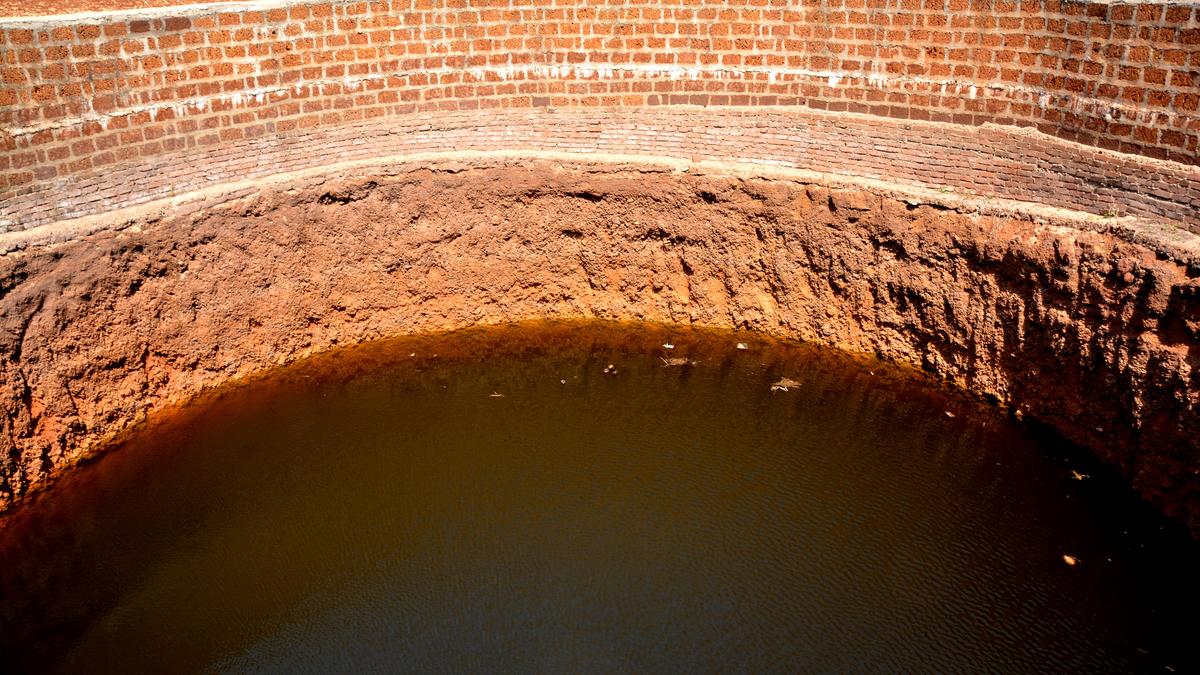
- 31 Jul 2025
In News:
The Government of India, through the Ministry of Environment, Forest and Climate Change (MoEFCC), has taken a landmark step toward formalising the management of chemically polluted land. The government notified the Environment Protection (Management of Contaminated Sites) Rules, 2025 under the Environment (Protection) Act, 1986, offering for the first time a legal framework to identify, assess, and remediate contaminated sites across the country.
Understanding Contaminated Sites
Contaminated sites refer to locations where hazardous chemicals or waste have been dumped historically, often prior to the existence of environmental regulation. These sites typically include:
- Abandoned industrial landfills
- Defunct chemical handling units
- Waste storage and spill zones
According to the Central Pollution Control Board (CPCB), 103 such sites have been identified across India, though remediation has been initiated in only 7. The lack of legal clarity and the inability to identify responsible parties have long hindered remediation efforts.
Salient Features of the 2025 Rules
The rules codify a five-step process that places the onus on local administrations and pollution control authorities to address environmental contamination:
- Identification & Reporting: District administrations must compile biannual reports of “suspected contaminated sites” and forward them to the State Pollution Control Boards (SPCBs) or a designated reference agency.
- Preliminary Assessment: Within 90 days, these agencies must assess the site for probable contamination.
- Detailed Site Survey: If contamination is suspected, a follow-up survey—within another 90 days—will test for any of the 189 hazardous chemicals notified under the Hazardous and Other Wastes Rules, 2016.
- Remediation Plan: A scientific reference organisation will draft a remediation strategy. The SPCB must identify the polluter within 90 days of confirming contamination.
- Cost Recovery & Liability: The principle of “polluter pays” is invoked. If the responsible party is untraceable or insolvent, costs will be shared equally by the Centre and State. Criminal liability for severe environmental damage will be addressed under the Bharatiya Nyaya Sanhita, 2023.
Exclusions and Scope Clarity
To prevent regulatory overlap, certain domains remain outside the ambit of these rules:
- Radioactive waste (Atomic Energy Act)
- Mining-related contamination
- Marine oil pollution
- Municipal solid waste landfills
These exclusions ensure that domain-specific legislation governs complex or hazardous waste streams more effectively.
Significance of the Notification
This is the first national-level regulatory framework to manage contaminated land in India. It provides:
- A time-bound process for site assessment and clean-up
- Clear delineation of institutional roles
- Enforceable liability mechanisms
- Legal visibility for public health and ecological risks tied to contaminated land
Earlier, the lack of a structured response mechanism led to regulatory inertia, leaving vulnerable communities at risk.
Implementation Challenges
Despite its promise, implementation will depend on:
- Strengthening technical capacity at district and state levels
- Enhanced coordination among SPCBs, CPCB, and reference agencies
- Financial mechanisms for cases where the polluter is absent
- Public engagement in identifying contaminated areas
Conclusion
The 2025 rules mark a paradigm shift in environmental governance. By embedding scientific assessment, legal accountability, and institutional responsibility into one framework, India takes a decisive step toward sustainable land management and environmental justice. However, effective capacity-building and cooperative federalism will be essential to translate these legal provisions into on-ground success.
NISAR Mission: A Landmark in Indo-US Space Cooperation and Earth Observation

- 29 Jul 2025
In News:
The upcoming launch of the NASA-ISRO Synthetic Aperture Radar (NISAR) satellite represents a landmark in Indo-U.S. collaboration in space science. Scheduled for deployment from Sriharikota onboard a GSLV Mk-II rocket, NISAR is poised to become one of the most sophisticated Earth observation missions globally, with wide-ranging scientific, environmental, and developmental implications.
Background and Mission Overview
NISAR, developed jointly by NASA and ISRO over the past decade at a cost of approximately ?12,000 crore, is designed to provide high-resolution, all-weather, day-and-night radar imaging of the Earth’s surface. It is the first satellite globally to incorporate dual-frequency synthetic aperture radar (SAR)—combining NASA’s L-band radar (1.257 GHz) and ISRO’s S-band radar (3.2 GHz).
This dual-frequency capability enables it to penetrate forest canopies and surface layers, allowing comprehensive monitoring of dynamic Earth processes such as land deformation, biomass change, glacier dynamics, and infrastructure stability.
Technical Capabilities and Orbit
The satellite will operate from a sun-synchronous polar orbit at an altitude of 747 km. It features a 12-metre deployable mesh antenna and uses SweepSAR technology for electronically steering radar beams. With a 240 km swath width and spatial resolution between 3–10 meters, it can revisit every point on Earth every 12 days, facilitating consistent long-term monitoring.
Applications Across Critical Sectors
NISAR’s data will address six broad thematic areas:
- Solid Earth Processes: Detecting earthquakes, landslides, and urban subsidence.
- Ecosystem Dynamics: Estimating forest biomass, carbon stocks, and biodiversity changes.
- Cryosphere Studies: Tracking glacier movements and polar ice thickness.
- Coastal Monitoring: Observing shoreline erosion and marine hazards.
- Disaster Management: Generating damage proxy maps within five hours of events like floods or cyclones.
- Agriculture and Infrastructure: Supporting food security, yield estimation, and infrastructure health monitoring.
India-specific applications include real-time soil moisture analysis, crop forecasting, flood mapping, and disaster relief planning. The S-band will be operated more intensively over Indian territory, addressing national developmental priorities.
Collaborative Contributions
The mission reflects a balanced international partnership. ISRO has provided the spacecraft bus, S-band radar, telemetry systems, and launch services, while NASA has contributed the L-band radar, antenna system, onboard electronics, and global data infrastructure. Final integration and testing were conducted in Bengaluru, reinforcing India's growing capability in complex space missions.
Data Policy and Accessibility
Following an open data policy, NISAR will make its data freely accessible to scientists, governments, and the public. ISRO’s Shadnagar ground station and Antarctica node will handle domestic reception and processing, while NASA will manage global downlink via its Near Earth Network.
Significance for India and the World
NISAR enhances India’s Earth observation portfolio and strengthens climate resilience, agricultural sustainability, and disaster preparedness. It also elevates India’s profile in global space diplomacy, aligning with goals under climate action, SDGs, and science diplomacy.
In conclusion, NISAR is not just a technological achievement but a strategic asset for planetary monitoring and sustainable development, embodying the spirit of science for global good and showcasing India’s capacity to lead in international space cooperation.
PM Modi’s Visit to the Maldives: A Strategic Reset in India’s Indian Ocean Diplomacy
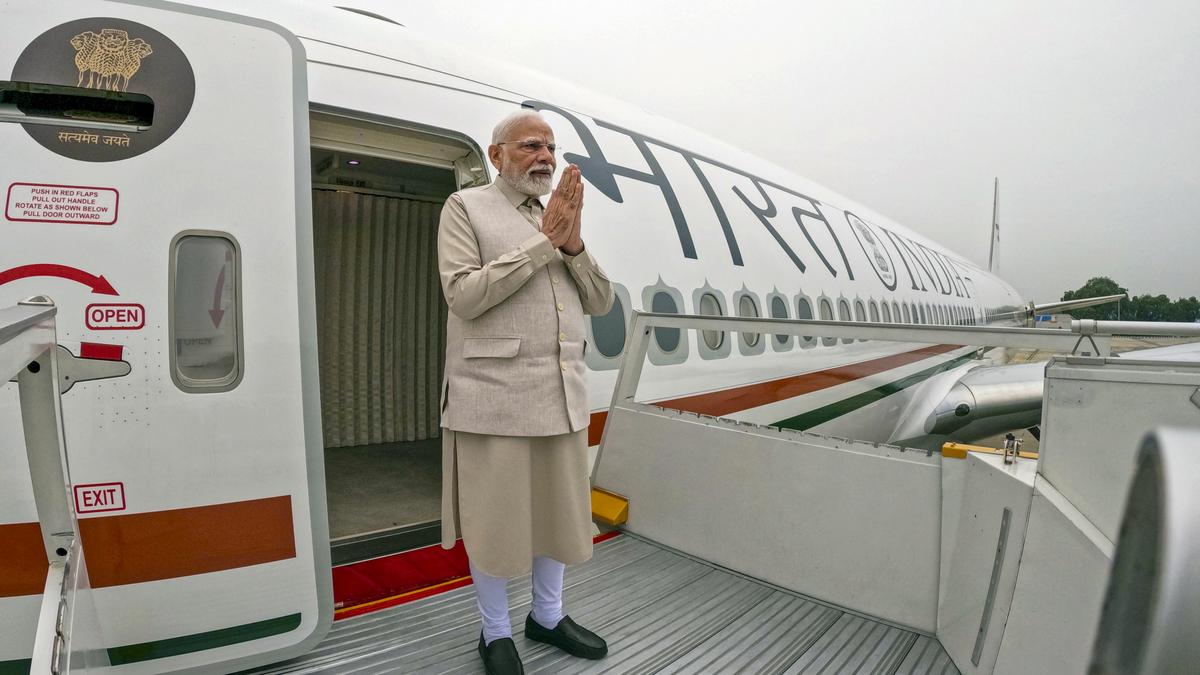
- 28 Jul 2025
In News:
Prime Minister Narendra Modi’s visit to the Maldives in July 2025 marked a significant diplomatic milestone, especially as it came amid shifting regional dynamics. Invited as the Guest of Honour for the 60th Independence Day celebrations, this was his third visit to the Maldives and the first by a foreign Head of Government under President Mohamed Muizzu's tenure. The event also symbolised a remarkable shift from the earlier phase of strained bilateral ties to renewed strategic alignment.
Diplomatic and Developmental Engagements
The visit featured a multifaceted agenda underscoring India’s "Neighbourhood First" and "Vision MAHASAGAR" policies. A commemorative stamp was released jointly by both leaders to mark 60 years of India-Maldives diplomatic relations, symbolised through traditional maritime vessels—India’s Uru boat and Maldives’ Vadhu Dhoni—highlighting shared Indian Ocean heritage.
India handed over two BHISHM Health Cubes—portable medical kits capable of treating 200 casualties and sustaining medical staff for 72 hours—demonstrating commitment to regional humanitarian support. PM Modi also inaugurated the new Ministry of Defence building in Malé, constructed with Indian assistance, enhancing Maldives’ institutional capacity.
A series of high-impact projects were launched, including:
- 3,300 social housing units in Hulhumale under Indian Buyer’s Credit,
- Road and drainage infrastructure in Addu City,
- Six community development initiatives, and
- 72 vehicles and utility equipment to support local governance.
Economic Assistance and Strategic Commitments
India extended a Line of Credit (LoC) worth ?4,850 crore, notably in Indian Rupees—marking the first such transaction for Maldives. This aims to address Maldives’ twin deficit crisis and reduce dependence on foreign currency. Additionally, an agreement was signed to reduce annual debt repayments from $51 million to $29 million, providing significant fiscal relief.
Other announcements included the launch of negotiations for an India-Maldives Free Trade Agreement (IMFTA) and joint climate action through synchronized tree-planting campaigns: India’s Ek Ped Maa Ke Naam and Maldives’ 5 Million Tree Pledge.
Diplomatic Turnaround: From 'India Out' to 'India In'
The symbolism of this visit lies in its contrast to recent tensions. After assuming office in 2023, President Muizzu’s administration aligned more closely with China and ran a vocally anti-India campaign. Early signals—including calls to remove Indian military personnel—suggested a possible strategic rupture. However, India opted for diplomatic engagement over confrontation, facilitating dialogue at COP28 and replacing its military presence with civilian HAL technicians in May 2024.
This calculated patience coincided with Maldives’ economic vulnerabilities, limited Chinese assistance, and the ruling PNC’s consolidation of power. The tide began to turn with high-level Maldivian visits to India and the announcement of a shared vision for maritime and economic cooperation in late 2024.
Conclusion
President Muizzu’s recent statement that "Maldives will not do anything to harm India's security interests" reflects a diplomatic recalibration driven by pragmatism and mutual necessity. The invitation extended to PM Modi for a ceremonial role in Maldives' Independence Day, once unthinkable amid the 'India Out' rhetoric, stands as a testament to the success of India’s calibrated diplomacy in the Indian Ocean region.
Draft National Telecom Policy 2025
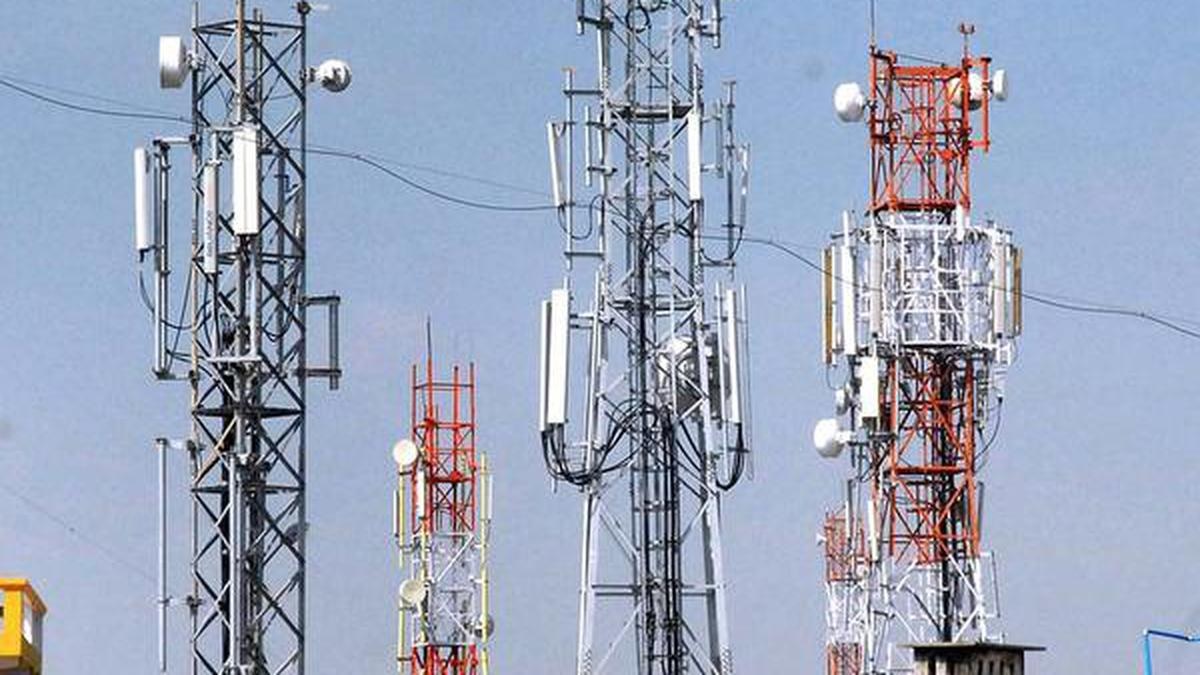
- 27 Jul 2025
In News:
- The Government of India has released the Draft National Telecom Policy 2025 through the Department of Telecommunications (DoT), marking a significant update after the 2018 National Digital Communications Policy (NDCP).
- The new draft aims to transform India into a “telecom product nation” through indigenous innovation, sustainable connectivity, and digital inclusion, aligning with broader national goals like Digital India, Make in India, and Atmanirbhar Bharat.
Vision and Strategic Objectives
- The policy envisions universal, meaningful, secure, and sustainable connectivity for all citizens while simultaneously boosting domestic innovation and employment.
- It reflects a shift from viewing telecom as a service enabler to treating it as a critical infrastructure sector capable of driving economic growth and strategic autonomy.
Key Focus Areas
- Universal Connectivity
- Target of 100% 4G coverage and 90% 5G coverage by 2030.
- Increase fiber-connected towers from 46% to 80% to enhance service quality.
- Establish 1 million new public Wi-Fi hotspots.
- Promote satellite internet to bridge digital divides in remote and border areas.
- Employment and Skilling
- Create 10 lakh new jobs in the telecom sector.
- Reskill another 10 lakh existing workers, addressing the evolving demands of the digital economy.
- Strengthening Domestic Manufacturing
- Target a 150% increase in domestic telecom manufacturing by 2030.
- Establish Telecom Manufacturing Zones (TMZs) with integrated infrastructure.
- Support R&D in next-generation technologies, including 6G.
- Include telecom R&D under Corporate Social Responsibility (CSR) activities to encourage private sector investment.
- Cybersecurity and Artificial Intelligence (AI)
- Deploy AI-based tools for proactive cyber threat detection and response.
- Counter generative AI-based attacks and enhance cross-border telecom signal surveillance.
- Use AI-powered chatbots for unified grievance redressal systems.
- Green Telecom and Circular Economy
- Reduce the sector’s carbon emissions by 30%.
- Promote recycling and reuse of telecom equipment to encourage circular economy practices.
- Technological Innovations
- Promote quantum-secure communications to strengthen network security.
- Enable mobile number-based identity verification for secure digital transactions.
- The removal of lawful interception provisions suggests a nuanced approach balancing security and privacy.
Comparative Outlook: 2018 NDCP vs. 2025 Draft Policy
- The 2018 policy had a broader digital communications focus; the 2025 draft is telecom-specific and more targeted.
- Job creation targets are more realistic (10 lakh vs. 40 lakh), reflecting the refined sectoral scope.
- AI, sustainability, and domestic manufacturing receive significantly enhanced attention in the 2025 draft.
- The shift from 10 million to 1 million Wi-Fi hotspot target indicates a pragmatic policy recalibration.
Conclusion
The Draft National Telecom Policy 2025 is a timely and ambitious framework aimed at ensuring digital sovereignty, innovation-driven growth, and inclusive access. By focusing on indigenous technology, sustainable infrastructure, and cybersecurity, it has the potential to position India as a global leader in next-generation telecommunications, including 6G and quantum tech. Effective implementation and coordination with state and private stakeholders will be key to translating this vision into ground reality.
Matter-Antimatter Asymmetry

- 24 Jul 2025
Context:
One of the most fundamental questions in cosmology and particle physics is: Why does the universe contain more matter than antimatter? The Big Bang, which occurred around 13.8 billion years ago, should have produced equal amounts of matter and antimatter. However, the observable universe today is overwhelmingly composed of matter, with antimatter being nearly absent except in trace amounts created in high-energy environments or particle accelerators. This puzzling imbalance—known as baryon asymmetry—continues to challenge scientists worldwide.
Recent breakthroughs, particularly a discovery made on July 16 at the Large Hadron Collider (LHC) in Europe, have added a significant piece to this puzzle. For the first time, scientists observed CP violation in baryons—heavy subatomic particles such as protons and neutrons made of three quarks. CP stands for Charge Conjugation (C) and Parity (P), which together form a symmetry principle stating that the laws of physics should be the same if a particle is replaced with its antiparticle and viewed in a mirror. A violation of this symmetry implies that matter and antimatter behave slightly differently—a necessary condition for the observed dominance of matter.
The experiment focused on a baryon called Λb0 (lambda-b-zero), which contains one up quark, one down quark, and one bottom quark. Scientists at LHCb measured the decay rates of Λb0 and its antimatter counterpart (Λb0-bar) into a proton, kaon, and two pions. The results showed a CP asymmetry of about 2.45%, with a statistical significance of over 5 sigma, a threshold used in particle physics to confirm a discovery. This historic observation is the first evidence of CP violation in baryons and expands our understanding beyond earlier CP violation detected in mesons (quark-antiquark pairs).
While this asymmetry is still insufficient to fully explain the matter-antimatter imbalance, it marks a critical advancement. It suggests that there could be undiscovered sources of CP violation in other particles or interactions that the Standard Model of particle physics does not yet account for. Theoretical and experimental physicists are now exploring whether other decays exhibit similar asymmetries and whether new physics—beyond the Standard Model—might be at play.
Parallel efforts are also underway deep underground. In Italy, physicists are assembling detectors 1.4 km below the mountains to observe neutrinoless double beta decay, a hypothetical nuclear process that, if confirmed, would indicate that neutrinos are Majorana particles—particles that are their own antiparticles. This would offer a different mechanism for matter creation without equivalent antimatter, further contributing to the asymmetry.
Moreover, U.S. institutions such as the Department of Energy (DOE) support advanced antimatter research through projects like the Deep Underground Neutrino Experiment (DUNE) and experiments at Brookhaven’s Relativistic Heavy Ion Collider, which have created antimatter versions of elements such as helium.
In conclusion, the recent detection of CP violation in baryons and continued investigations into rare decays and neutrino properties are gradually illuminating the deep cosmic mystery of why something exists instead of nothing. This line of inquiry not only bridges particle physics and cosmology but also exemplifies human curiosity’s power in probing the origins of existence itself.
The Need to Protect India’s Linguistic Secularism
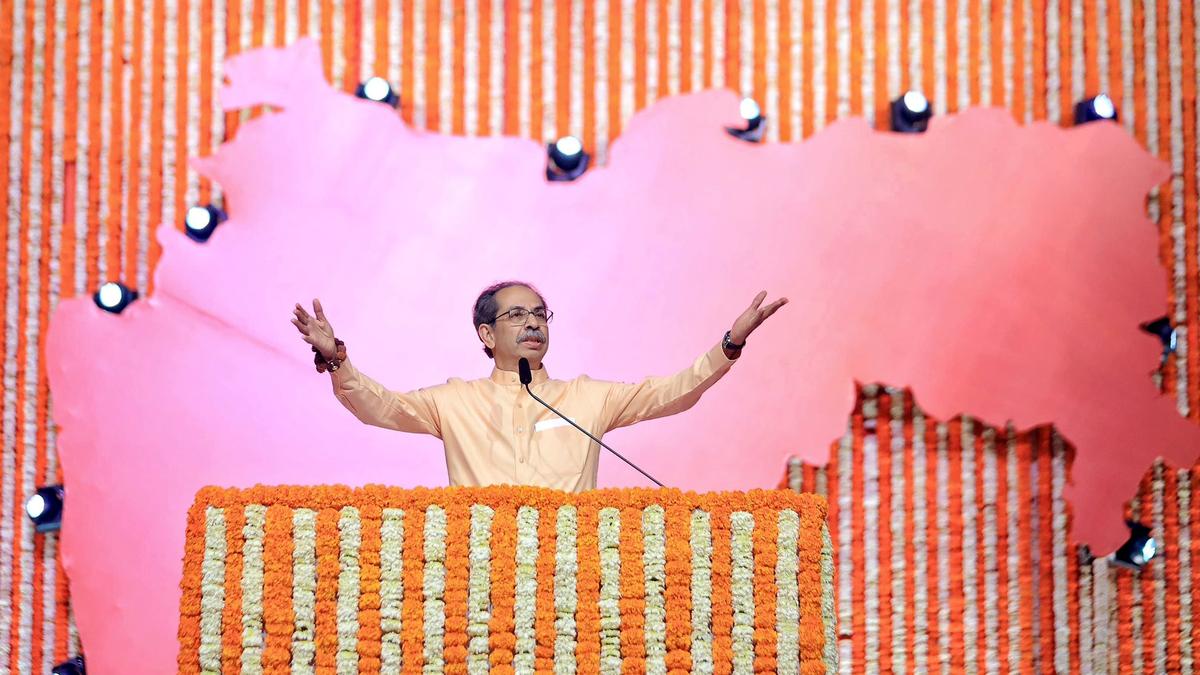
- 20 Jul 2025
In News:
India’s identity as a democratic and pluralistic society rests not only on its religious diversity but also on its remarkable linguistic heterogeneity. According to the 2011 Census, India is home to 121 languages and 270 mother tongues, with 22 languages recognized under the Eighth Schedule of the Constitution. This linguistic diversity forms a critical part of India’s secular ethos, often overshadowed by the more frequently discussed religious dimension of secularism.
Unlike the Western model of secularism, which advocates a strict separation between religion and state, India’s secularism is inclusive and interventionist. It allows the state to engage positively in ensuring equality among different religious and linguistic groups. The Indian state does not privilege any single religion or language but guarantees all communities the right to preserve their cultural and linguistic identity.
This commitment is constitutionally enshrined. Article 343 declares Hindi in Devanagari script as the official language of the Union, but also provides space for states to choose their own official languages. Article 29 guarantees every section of citizens the right to conserve their distinct language, script, or culture. The Eighth Schedule ensures recognition and development support for 22 scheduled languages, while allowing the space for inclusion of others over time. This decentralized and accommodating approach prevents linguistic hegemony while nurturing India’s cultural mosaic.
However, recent incidents of language-based violence and exclusion — such as attacks on non-Marathi speakers in Maharashtra — signal growing tensions rooted in identity politics. While movements to preserve linguistic heritage are legitimate, they must not mutate into exclusionary practices. Historical resistance to Hindi imposition in Tamil Nadu and similar sentiments in Northeastern states stem from real concerns over cultural erasure and centralisation of linguistic power.
Such developments point to the misuse of linguistic identity as a political mobilization tool, undermining the foundational values of unity in diversity. The imposition of one language, directly or indirectly, poses a threat not just to federalism but also to the democratic fabric of the country. Language cannot be a tool for dominance; it must be a bridge for mutual respect and integration.
It is crucial to note that India does not have a national language, only an official language at the Union level. The Constitution deliberately avoids conferring national status to any language to prevent alienation and protect linguistic plurality. The respect for all languages, including non-scheduled ones and dialects, is central to India’s linguistic secularism.
Therefore, the responsibility lies with political parties, civil society, media, and educational institutions to nurture this ethos. The political class, in particular, must refrain from exploiting linguistic emotions for electoral gains. Instead, they should promote policies that encourage multilingual education, cultural exchange, and preservation of regional languages.
In an increasingly globalized and polarized world, India’s linguistic secularism must be viewed not as a passive principle but as an active commitment — essential for national unity, inclusive development, and constitutional morality. Only by valuing each language equally can India uphold the promise of democratic citizenship and cultural dignity for all.
Trump’s Tariff Threats and BRICS

- 17 Jul 2025
In News:
The recent 17th BRICS Summit in Rio de Janeiro (2025) has reignited tensions between the United States and the expanding BRICS grouping. Former U.S. President Donald Trump, who remains a dominant figure in Republican politics, has threatened to impose 10% tariffs on all BRICS nations, framing the bloc as a challenge to American economic hegemony. These threats signal a continuation of Trump's confrontational approach to global trade and reflect deeper anxieties about de-dollarisation efforts emerging from the Global South.
Trump’s concerns stem from what he perceives as an "anti-American" orientation of BRICS. The group's discussions around a common currency, increased use of national currencies, and the development of alternative cross-border payment systems have been interpreted by Trump as an attempt to weaken the U.S. dollar’s central role in international finance. This fear has been intensified post the Russia-Ukraine conflict, which saw several countries reconsider their reliance on dollar-based systems like SWIFT, particularly after Russia’s exclusion from them due to Western sanctions.
In response, Trump has floated punitive trade measures: a 10% tariff on BRICS-aligned nations, 50% on Brazil for its domestic political stance, and 30% on South Africa citing trade disputes and minority rights issues. He is also advocating for the Sanctioning Russia Act, 2025, which proposes an astronomical 500% tariff on Russian oil and related products. Such a move could disrupt oil-importing economies like India and China, both of which have deepened energy ties with Moscow in recent years.
However, BRICS leaders have clarified that de-dollarisation is not about dismantling the dollar-based order but about financial diversification and resilience. The Rio Declaration 2025 stopped short of any anti-U.S. language, instead emphasizing interoperability of payment systems and equitable reform of global institutions. This demonstrates a cautious diplomatic approach aimed at asserting economic agency without triggering direct confrontation.
India, in particular, has taken a measured stance. In Parliament, the Indian government distanced itself from suggestions that BRICS was pursuing an aggressive de-dollarisation agenda. External Affairs Minister S. Jaishankar reiterated that India has no official policy to replace the U.S. dollar, and that BRICS decisions are not monolithic but reflect the diversity of its member states. This is crucial, given India’s strategic balancing between the West and the Global South.
Founded in 2009 amid discontent with Western-dominated financial structures, BRICS has expanded to include 10 members, with new entrants like Iran, Egypt, Ethiopia, UAE, and Indonesia. While united by frustration over Western dominance, internal diversity—economic, political, and strategic—ensures that BRICS does not function as a rigid anti-West alliance.
At the Rio summit, BRICS condemned unilateral tariff practices and expressed concern over attacks on Iranian civilian infrastructure, showcasing solidarity without directly naming the U.S. or its allies. This signals a shift toward multilateral diplomacy grounded in soft balancing rather than confrontation.
In conclusion, while Trump’s tariff threats underline U.S. anxiety over shifting global power structures, BRICS’ response suggests a nuanced recalibration of the international order—not a radical overhaul. For India, the challenge remains to harness BRICS for strategic autonomy without undermining its multi-aligned foreign policy posture.
Tamil Nadu’s TB Death Prediction Model

- 12 Jul 2025
In News:
Tamil Nadu has become the first Indian state to integrate a predictive model for tuberculosis (TB) deaths into its State TB Elimination Programme. This initiative, in partnership with the Indian Council of Medical Research’s National Institute of Epidemiology (ICMR-NIE), marks a significant step in India’s public health innovation, aimed at reducing TB-related mortality through data-driven, early intervention strategies.
The model has been embedded within the existing TB SeWA (Severe TB Web Application) platform, launched under the state’s Tamil Nadu Kasanoi Erappila Thittam (TN-KET), a differentiated care initiative operational since 2022. It enables real-time triaging and prioritisation of severely ill patients at the time of diagnosis, improving early access to hospital care—a crucial step, as over 70% of TB deaths occur within the first two months of treatment.
How the Predictive Model Works
The model is based on five triage indicators:
- Body Mass Index (BMI)
- Pedal oedema (foot/ankle swelling)
- Respiratory rate
- Oxygen saturation
- Ability to stand without support
Healthcare workers input these variables into the TB SeWA app, which calculates a predicted probability of death, ranging from 10% to 50% for severely ill patients. For those not flagged, the risk ranges between 1% and 4%. This objective risk estimate empowers frontline health workers to make urgent and informed decisions about hospital admission and care.
Data used for model development included nearly 56,000 TB patients diagnosed in Tamil Nadu’s public health facilities between July 2022 and June 2023. Notably, 10–15% of adults with TB in the state were found to be severely ill at diagnosis. The model's predictive accuracy has been validated as equivalent to the national Ni-kshay portal, which captures a broader range of data but with a delay of up to three weeks—often too late for timely intervention.
Implementation and Impact
The model is now functional across all 2,800 public health facilities in Tamil Nadu, from Primary Health Centres to Medical Colleges. The average time from diagnosis to hospital admission is already around one day, but delays of 3–6 days still occur in about 25% of cases. By introducing objective, real-time risk assessment, the model aims to eliminate such delays and further reduce early TB deaths.
The TN-KET initiative has shown promising results: nearly two-thirds of districts have documented reduced mortality and losses in the TB care cascade. Tamil Nadu remains the only Indian state to systematically record and act upon these five triage variables at the point of diagnosis.
National and Global Relevance
India carries the highest TB burden globally, with two TB-related deaths every three minutes, according to the WHO. Tamil Nadu’s model aligns with global findings, such as those from Ethiopia, identifying low body weight, age, and TB/HIV co-infection as key mortality predictors. Addressing these early improves outcomes significantly.
This innovation presents a scalable, replicable model for other Indian states and developing nations striving to eliminate TB by 2030, in line with WHO’s End TB Strategy and India’s National Strategic Plan.
Employment-Linked Incentive (ELI) Scheme
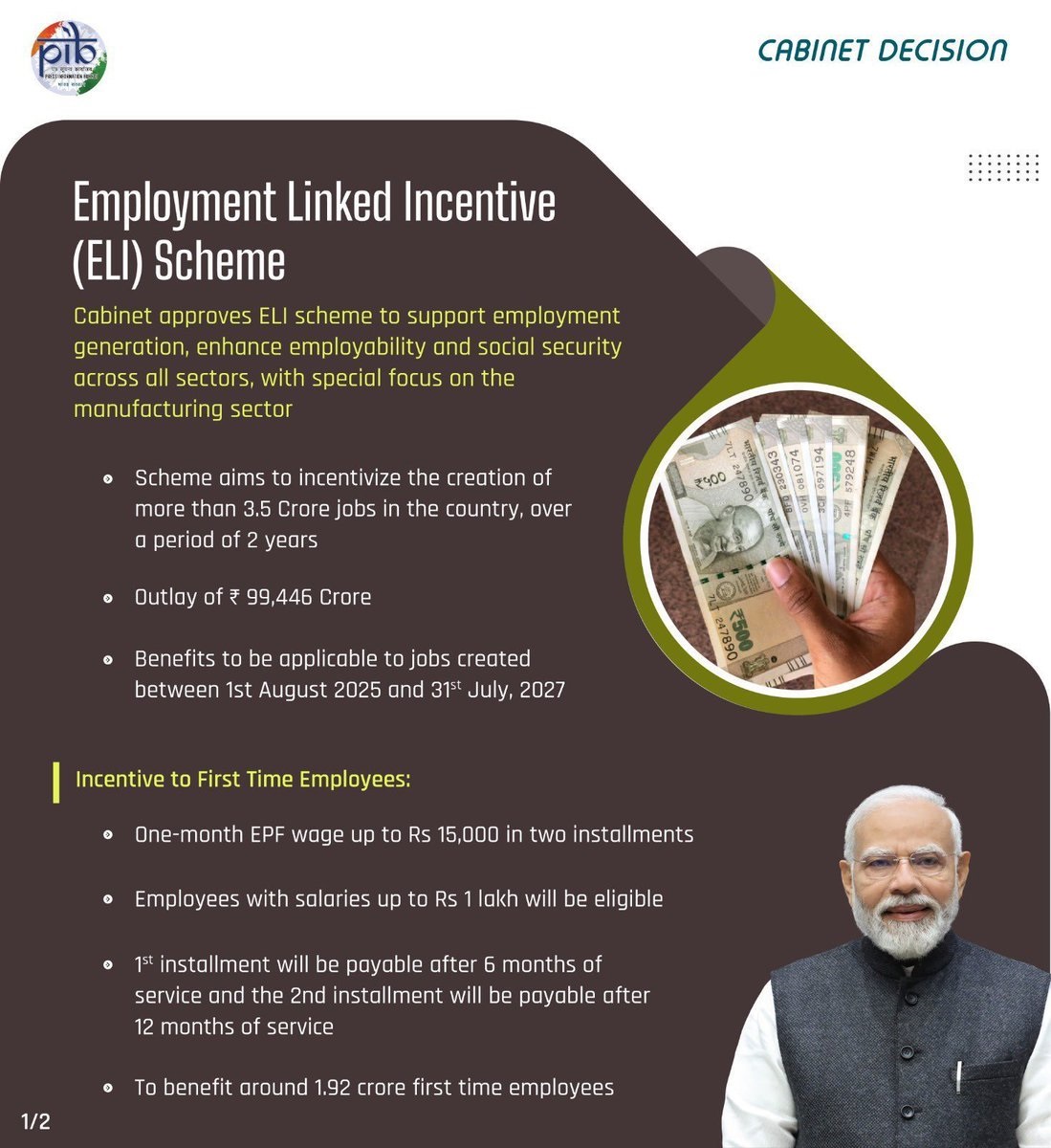
- 07 Jul 2025
In News:
The Government of India has approved the Employment-Linked Incentive (ELI) Scheme with an outlay of ?99,446 crore, aimed at promoting formal employment generation, particularly in the manufacturing sector. Announced in the 2024–25 Union Budget, the scheme is part of a broader employment strategy that includes internships, skill development, and youth engagement initiatives.
Key Features of the Scheme
The ELI scheme, operational from August 1, 2025 to July 31, 2027, targets the creation of over 3.5 crore jobs. Of these, 1.92 crore newly employed individuals are expected to benefit directly. It is being implemented through the Employees Provident Fund Organisation (EPFO).
For eligible new recruits earning up to ?1 lakh/month:
- EPFO will transfer one month’s EPF wage (up to ?15,000) in two instalments—after 6 and 12 months of continuous service.
- Part of the incentive will be deposited in a fixed savings instrument, withdrawable later by the employee.
Incentives for employers include:
- ?3,000 per employee/month for two years for each new employee retained for at least six months.
- For the manufacturing sector, this benefit may extend into the third and fourth years.
Who Benefits?
The scheme primarily benefits:
- New entrants into the formal labour market.
- Labour-intensive sectors, especially manufacturing.
- Employers incentivized to sustain job creation.
- Small businesses, if implementation is expanded inclusively.
Industry Response
The industry has largely welcomed the initiative. According to FICCI’s former president, it is an “innovative” step that rewards both employees and employers. The Confederation of Indian Industry (CII) noted its potential to reshape India’s employment architecture.
However, Laghu Udyog Bharati, representing micro and small businesses, emphasized the need to include units with less than 20 employees, which dominate India’s enterprise landscape. Entrepreneurs’ associations also called for simplified and direct reimbursement models linked to verified payroll data, particularly under the MSME Ministry.
Trade Union Perspectives
While the Bharatiya Mazdoor Sangh (BMS) cautiously endorsed the scheme, other central trade unions criticized it for allegedly favoring corporates. They compared it to the Production-Linked Incentive (PLI) Scheme of 2020, where funds reportedly failed to create jobs and ended up benefiting large firms. Unions have demanded expansion of social security coverage and improved quality of employment, rather than subsidizing private sector wage bills.
Concerns and Challenges
Key concerns include:
- The role of EPFO, traditionally a custodian of worker savings, now being tasked with implementing a government-funded job creation scheme.
- Lack of clarity on fund disbursement responsibilities, raising doubts over accountability and oversight.
- Fear of misuse, given past precedents of incentive leakage.
- The structural issue of economic slowdown and stagnant worker incomes, which the scheme doesn’t directly address.
Conclusion
The ELI Scheme is a bold intervention in India’s formal employment landscape, combining wage subsidies with retention incentives. However, for it to be truly transformative, it must ensure inclusive coverage, maintain transparency, and be integrated into a broader strategy that enhances domestic demand and quality of employment. As India aims for equitable economic growth, effective implementation and stakeholder trust will be critical to its success.
PM-POSHAN
- 06 Jul 2025
In News:
The midday meal scheme, introduced a century ago by the Madras Municipal Corporation in 1925, has evolved into a cornerstone of India’s social welfare and education policy. Now known as PM-POSHAN (Pradhan Mantri Poshan Shakti Nirman), the scheme provides cooked meals to students up to Class 8 in government and aided schools. However, despite its proven benefits in enhancing enrolment, retention, and learning outcomes, the scheme continues to face serious implementation challenges across Indian states.
Originally launched nationwide in 1995 as the National Programme of Nutritional Support to Primary Education, the scheme was rebranded as PM-POSHAN for 2021–2026, with shared funding between the Centre and States. Yet, funding shortfalls, delayed disbursements, and logistical bottlenecks have undermined its effectiveness. In states like Kerala and Uttar Pradesh, headteachers report borrowing funds and delaying salaries to cover rising food and fuel costs. Teachers are forced to juggle between administrative duties and managing meals, often without adequate staff or infrastructure.
Tamil Nadu has emerged as a success story with the Chief Minister’s Breakfast Scheme launched in 2022, now reaching over 17.5 lakh students. The state also assesses students’ Body Mass Index (BMI), integrates Anganwadis for early nutrition, and prioritizes public investment in health and education, reflecting the Dravidian model. This has led to a measurable decline in malnutrition and school dropout rates, especially among girls.
In contrast, states like Bihar lag behind, with widespread complaints of mismanagement and food safety lapses. Caste-based discrimination further mars the scheme’s inclusive vision, with reports from both north and south India highlighting segregated seating and removal of cooks from marginalized communities due to social prejudice.
Despite PM-POSHAN’s intended goals, its design often reflects a one-size-fits-all approach, neglecting state-specific challenges. For example, nutrition gardens or IT-based monitoring systems remain tokenistic in under-resourced regions. The uniform allocation norms do not account for price inflation, regional dietary needs, or additional requirements like eggs or milk, leading to nutritional gaps.
Experts argue for a context-sensitive redesign. Dipa Sinha, a development economist, emphasizes that centrally sponsored schemes must account for states’ limited fiscal capacity, especially as most taxes are collected by the Union government. There is a need for increased central assistance and flexibility in fund allocation to match ground realities.
Moving forward, replicating best practices from Tamil Nadu, Kerala, and Odisha, promoting community-level engagement, and allowing NGOs to address psychosocial gaps can help strengthen the programme. Customizing menus based on local needs, ensuring timely fund flow, recruiting adequate staff, and addressing social discrimination are essential to achieve the dual goals of universal education and child nutrition.
Conclusion
PM-POSHAN, though visionary, struggles in its current form. To fulfill its true potential as a tool for social justice and inclusive development, it must shift from being a centrally driven subsidy programme to a locally empowered, child-centric nutrition model embedded within the education system.
A New BHARAT: Establishing India-Specific Parameters for Healthy Ageing
- 05 Jul 2025
Introduction
As India advances toward becoming a super-aged society by the middle of this century, the focus must shift from merely increasing lifespan to enhancing healthspan—the period of life spent in good health. Recognising this, the Indian Institute of Science (IISc), Bengaluru, launched a pioneering research initiative titled BHARAT (Biomarkers of Healthy Aging, Resilience, Adversity, and Transitions). It aims to map physiological, genetic, environmental, and socio-economic indicators that define healthy ageing in the Indian context.
The Need for India-Specific Healthy Ageing Parameters
Global research in ageing has largely been Western-centric, leading to the development of diagnostic thresholds, biomarkers, and treatment regimes based on non-Indian populations. This lack of contextual relevance often results in misdiagnosis and inappropriate treatments in countries like India. For instance, biomarkers such as cholesterol, vitamin D, or C-reactive protein (CRP) may exhibit different baseline levels among Indians due to genetic, nutritional, and environmental factors, but are often interpreted using Western standards.
Furthermore, while life expectancy has increased globally, the incidence of age-related disorders like Parkinson’s and dementia is projected to rise sharply in India—by 168% and 200%, respectively, by 2050. Thus, there is an urgent need to identify early biomarkers that can predict organ deterioration before the onset of overt disease.
BHARAT Study: Objectives and Methodology
BHARAT is part of IISc’s Longevity India Programme, and seeks to establish a Bharat Baseline—a reference for what is physiologically normal for the Indian population across age groups. It will build a comprehensive, multidimensional database that includes:
- Genomic biomarkers (genetic predisposition to diseases)
- Proteomic and metabolic profiles (pathway-level health indicators)
- Environmental and lifestyle factors (pollution exposure, dietary habits)
Crucially, it acknowledges that chronological age does not always match biological age, and seeks to develop more nuanced, organ-specific age markers that could enable preventive and personalised interventions.
Role of Artificial Intelligence
Given the complexity and volume of biological and lifestyle data, artificial intelligence (AI) and machine learning models are essential tools in this initiative. These technologies will aid in pattern recognition, risk prediction, and simulation of intervention outcomes, ultimately helping researchers select the most effective strategies before launching costly human trials.
Challenges and the Way Ahead
India’s vast genetic, geographic, and socio-economic diversity presents both opportunities and challenges. The BHARAT team faces hurdles such as:
- Difficulty in recruiting healthy adult volunteers
- Securing long-term public and private funding
- Scaling the study to ensure pan-India representation
However, the potential impact is profound. By building an India-specific ageing dataset, BHARAT can influence the development of better diagnostics, public health policies, and preventive healthcare systems for an ageing population.
Conclusion
The BHARAT study marks a critical shift in India’s biomedical research priorities, focusing not only on longevity but on quality of life during ageing. As India prepares to navigate the challenges of demographic transition, initiatives like BHARAT will be instrumental in creating a resilient, inclusive, and health-aware society, rooted in evidence that reflects its own people.
China-Led Trilateral Nexus: A Strategic Challenge for India

- 01 Jul 2025
Context:
In a significant development, China recently hosted the first China-Pakistan-Bangladesh trilateral dialogue in Kunming, following a similar China-Pakistan-Afghanistan meeting. These efforts signal Beijing’s strategic push to consolidate its influence in South Asia, creating new geopolitical challenges for India.
Understanding the Emerging Nexus
The trilateral arrangements—China-Pakistan-Bangladesh and China-Pakistan-Afghanistan—are part of China’s broader strategic framework to establish deeper regional roots. China drives the agenda, with Pakistan gaining strategic relevance, while Bangladesh and Afghanistan are drawn in for economic, political, and connectivity incentives.
Motivations Behind the Trilateralism
- China aims to dilute India’s regional influence, expand the Belt and Road Initiative (BRI), and leverage Pakistan to complicate India's neighbourhood strategy.
- Pakistan seeks Chinese economic and strategic backing to offset India, especially after facing diplomatic isolation globally.
- Bangladesh and Afghanistan are attracted by Chinese infrastructure investment, diplomatic weight, and development assurances in a multipolar Asia.
Historical Context
- 1962 Indo-China War: Set the foundation for Sino-Pakistan convergence as a counterweight to India.
- 1965 Siliguri Strategy: Pakistan attempted to encircle India with support from China, Nepal, and East Pakistan, a strategy echoing today.
- China’s Shielding at UNSC: Regular blocking of India’s attempts to designate Pakistan-based terrorists, such as Lashkar-e-Taiba operatives, at the United Nations.
- Operation Sindoor, 2025: Pakistan deployed Chinese drones and radars; Beijing criticized India’s counterstrike, reaffirming its alliance.
Implications for India
- Security Threats: China-Pakistan cooperation now gains a regional sheen, legitimizing their cross-border strategies, e.g., the Pahalgam attack (2025).
- Diplomatic Setbacks: China’s increasing footprint in Dhaka and Kabul limits India’s traditional influence.
- Strategic Encroachment: Enhanced trilateralism boosts BRI's presence in South Asia, undercutting India-led alternatives like BBIN or the Chabahar corridor.
Impact on South Asian Stability
- Regional Polarization: Smaller nations are forced to balance between India and China, causing strategic fragmentation.
- Risk of Proxy Conflicts: Chinese cover may embolden Pakistan’s use of cross-border terrorism.
- Dilution of Regional Forums: SAARC and other platforms may become ineffective under Chinese influence.
Way Forward for India
- Assert Strategic Redlines: India must clearly articulate consequences for neighbours compromising its sovereignty.
- Deepen Regional Cooperation: Utilize BIMSTEC, IORA, and the Indo-Pacific frameworks to counterbalance Chinese presence.
- Economic Diplomacy: Increase targeted investments, credit lines, and market access to offer credible alternatives to BRI.
- Defence Engagement: Expand military and strategic ties with Bangladesh, Maldives, and Afghanistan.
- Narrative Building: Promote India as a cooperative, non-hegemonic regional partner to counter Chinese narratives.
Conclusion
The China-led trilateral dialogues mark a recalibration in South Asia’s geopolitical landscape aimed at constraining India’s rise. India’s response must be multifaceted—merging strategic assertiveness with regional diplomacy and economic outreach. A confident and inclusive India can safeguard its interests and lead a stable, multipolar South Asian order.
Foreign Universities in India: A New Era in Higher Education
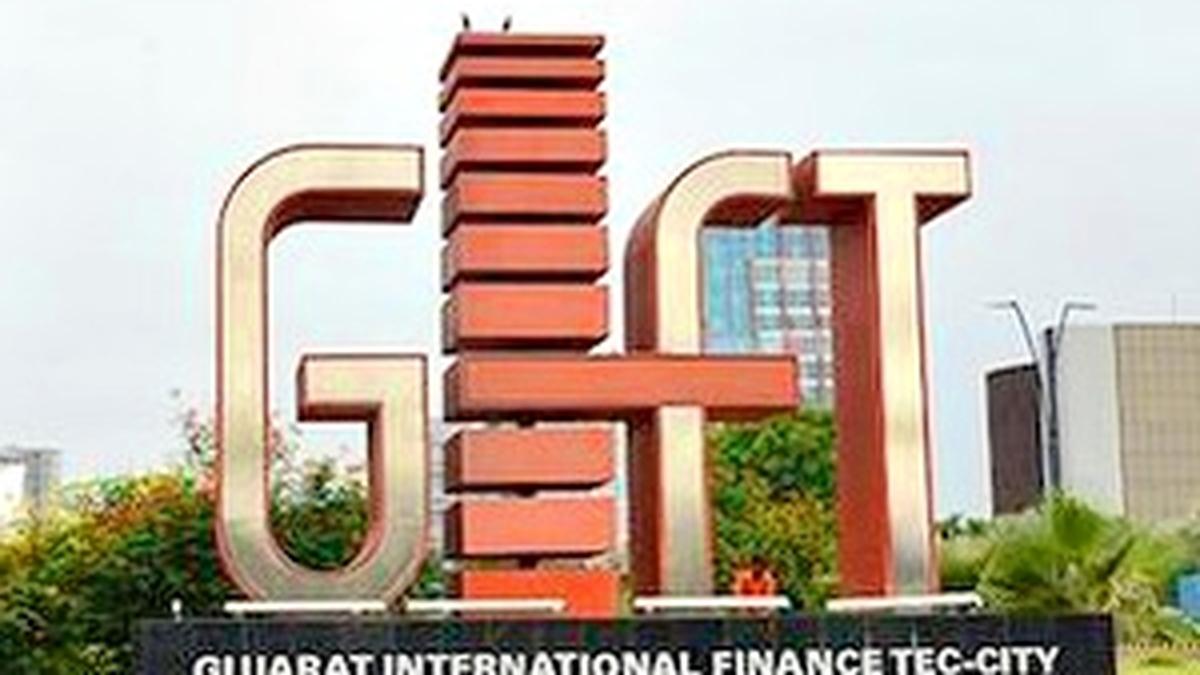
- 30 Jun 2025
Context:
India is witnessing a transformative moment in its higher education sector with globally reputed foreign universities preparing to set up campuses within the country. Enabled by the UGC (Setting up and Operation of Campuses of Foreign Higher Educational Institutions in India) Regulations, 2023, and inspired by the vision of the National Education Policy (NEP) 2020, this move could reshape the academic landscape. Locations such as GIFT City (Gujarat) and Navi Mumbai have been identified as early sites for these institutions. As of mid-2025, seven universities from the UK, five from Australia, and one each from the US, Canada, and Italy have initiated or secured regulatory approvals.
Drivers of Foreign University Interest in India
- Demographic and Economic Potential:India hosts over 40 million students in higher education, with a Gross Enrolment Ratio (GER) below 30% (AISHE 2021–22), indicating untapped potential. A growing urban middle class, rising aspirations, and the need for globally competitive education have made India an attractive destination.
- Global Decline in Student Numbers:Countries in the Global North face declining domestic enrolments due to falling birth rates. In 2023, international students accounted for 22% in the UK, 24% in Australia, and 30% in Canada. Top U.S. universities reported up to 27% international enrolments, underscoring their reliance on overseas students for revenue.
- Policy Tightening in Host Nations:Visa caps and policy restrictions in Australia, the UK, and Canada have constrained student inflows. Consequently, foreign institutions are exploring in-country campuses in emerging markets like India to maintain their global reach and financial sustainability.
Opportunities and Advantages
- Academic Diversification: Indian students will gain access to internationally benchmarked curricula, faculty, and research ecosystems without the need to go abroad.
- Cost-Effective Alternative: For students unable to afford international education, foreign campuses in India provide a more affordable and accessible option.
- Quality Enhancement: The presence of foreign institutions could push Indian universities to raise academic standards through competition and collaboration.
- Regional Education Hub: India may also attract students from South Asia and Africa, enhancing its regional soft power.
Challenges Ahead
- Affordability: Tuition fees at foreign university campuses may still be beyond the reach of average Indian households, potentially limiting their impact to elite segments unless subsidized.
- Mixed Global Precedents: Similar ventures in China and Southeast Asia have seen varied success, with some facing regulatory and financial hurdles.
- Regulatory and Cultural Complexities: India’s bureaucratic processes, socio-cultural diversity, and policy uncertainties could pose operational challenges.
- Modest Initial Scale: In the short term, student intake and institutional presence are expected to be limited, with success depending on market response and adaptability.
Regulatory Framework and Future Outlook
The UGC’s FHEI Regulations, 2023, provide foreign institutions with autonomy in curriculum design, faculty recruitment, admissions, and repatriation of surplus funds. Only top 500 globally ranked universities, or those with exceptional expertise in niche domains, are eligible. These reforms reflect India’s commitment to making higher education globally competitive.
If effectively implemented, foreign campuses can act as catalysts for academic reform, foster global partnerships, and elevate India’s position as an education hub. However, ensuring affordability, equitable access, and academic integrity will be key to long-term success.
Rising Participation and Casualties of Women in Left-Wing Extremism
- 27 Jun 2025
Context:
There has been a sharp surge in the number of women Maoist cadres killed in anti-Naxal operations in Chhattisgarh since 2024. This rise has coincided with the intensification of counter-insurgency efforts under the Ministry of Home Affairs’ (MHA’s) renewed push to eliminate Left-Wing Extremism (LWE) by March 2026.
Behind these numbers lies a disturbing narrative of coercion, indoctrination, gender-based exploitation, and the systemic use of women and children as tools in extremist strategies.
Trends in Women Maoist Casualties (2024–2025)
- 2024: Out of 217 Maoists killed, 74 were women (~34%)
- 2025 (till June 20): Out of 195 killed, 82 were women (~42%)
- Comparison with previous years:
- 2019: 65 total killed | 17 women
- 2020: 40 total | 7 women
- 2021: 51 total | 13 women
- 2022: 30 total | 9 women
- 2023: 20 total | 5 women
This data indicates a doubling of women fatalities as a proportion of total casualties in Maoist operations since the launch of targeted operations.
Recruitment Through Coercion: Bal Dastas and Gendered Exploitation
According to the MHA, Maoists have been increasingly recruiting young Adivasi girls and forming “Bal Dastas” (child squads) in Chhattisgarh and Jharkhand. Key observations include:
- Parental coercion: Many impoverished tribal families are forced to give up their girl children under threats and pressure.
- Ideological indoctrination: Children are brainwashed to adopt Maoist ideology from an early age.
- Gendered exploitation: Although the Maoists outwardly reject patriarchy, the representation of women in leadership roles such as the Polit Bureau and Central Committee remains negligible.
- Use of women as foot soldiers and human shields, exposing them disproportionately to fatal encounters with security forces.
Underlying Issues: Security, Society, and Maoist Strategy
- Deliberate Alienation Strategy:
- Maoists systematically attack schools and educational infrastructure.
- As per MHA, education fosters critical thinking and alternate livelihoods, which are seen as a threat to Maoist influence.
- Civilian and Infrastructure Loss:
- Since 2019:
- 725 civilians killed in LWE violence.
- 263 incidents of attacks on economic infrastructure recorded.
- Since 2019:
- Socio-Economic Backdrop:
- Lack of education, healthcare, livelihood options, and state presence in remote tribal areas fuel Maoist recruitment.
- Women and children from these regions become the most vulnerable and easily exploited demographic.
Security Forces' Perspective and Response
- Initial recruitment of women was largely based on coercion and misinformation.
- Once inside the Maoist ranks, women face physical, mental, and emotional exploitation.
- Maoists use women primarily as human shields and expendable foot soldiers.
However, the security forces are increasingly pursuing a sensitive, gender-aware approach, prioritizing:
- Voluntary surrender schemes
- Gender-sensitive rehabilitation policies offering:
- Education
- Vocational training
- Healthcare access
- Social reintegration pathways
Way Forward: A Multi-Pronged Strategy
- Strengthen Surrender and Rehabilitation Frameworks:
- Expand socio-economic reintegration schemes tailored for women ex-cadres.
- Ensure psycho-social counselling, particularly for minors and survivors of exploitation.
- Enhance State Presence and Welfare Delivery:
- Accelerate development of infrastructure, education, and healthcare in LWE-affected districts.
- Promote community policing and tribal leadership in governance processes.
- Child Protection Measures:
- Strengthen child protection systems, including monitoring of Bal Dastas.
- Empower and engage Anganwadi workers, school teachers, and local NGOs in vulnerable zones.
- Gender-Sensitive Counter-Insurgency Doctrine:Train forces in humane engagement, protection of rights, and de-escalation tactics when dealing with women and child cadres.
Centre’s Push for Forest Rights Act Implementation
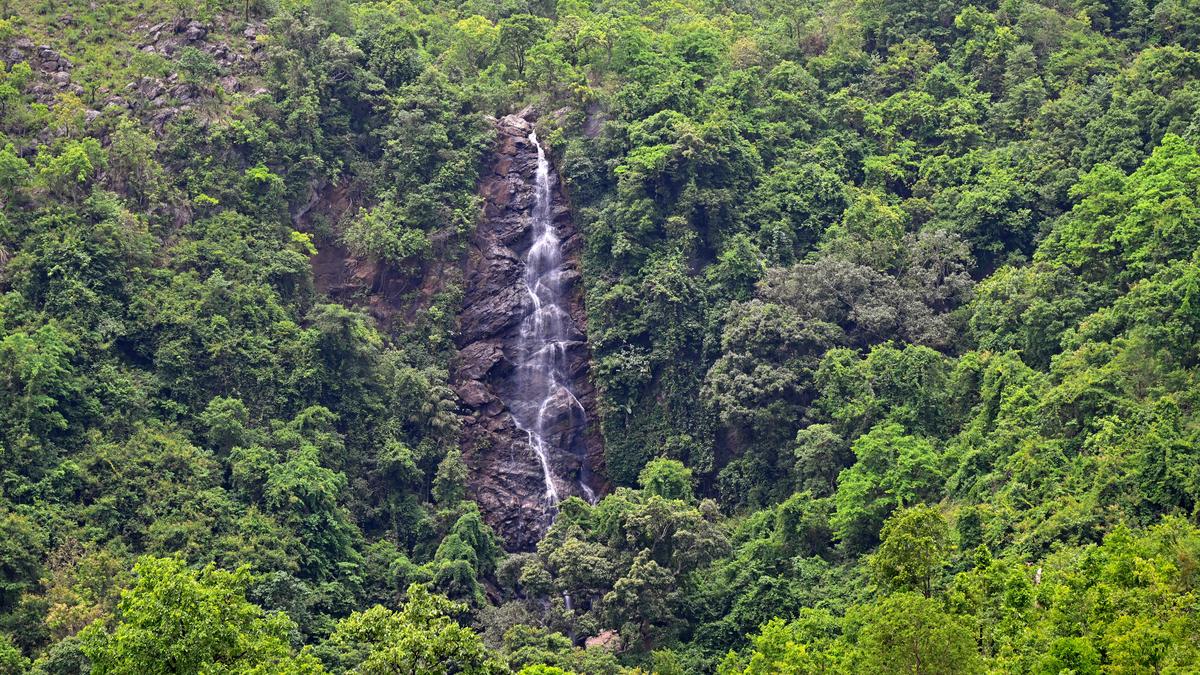
- 17 Jun 2025
In News:
The Forest Rights Act (FRA), 2006, was enacted to address the historical injustice faced by Scheduled Tribes (STs) and Other Traditional Forest Dwellers (OTFDs) by recognising their rights over forest land and resources. Its implementation, for nearly two decades, has been the sole responsibility of State governments. However, in a major policy shift, the Union government has begun funding support structures to aid its implementation through the Dharti Aaba Janjatiya Gram Utkarsh Abhiyaan (DAJGUA), launched in October 2024.
DAJGUA and Structural Support for FRA
For the first time, the Ministry of Tribal Affairs has sanctioned 324 district-level and 17 State-level Forest Rights Act (FRA) cells across 18 States and Union Territories. These cells aim to facilitate, not replace, the statutory process mandated under the FRA. The funding is routed through Grants-in-Aid General, with a budget allocation of ?8.67 lakh per district cell and ?25.85 lakh per State-level cell. Operational control rests with State Tribal Welfare Departments.
States like Madhya Pradesh (55 cells), Chhattisgarh (30), Telangana (29), Maharashtra (26), Assam (25), and Jharkhand (24) have received the highest number of sanctioned FRA cells. Notably, while Madhya Pradesh and Chhattisgarh report low pendency, States like Assam and Telangana have pending claim rates exceeding 60% and 50% respectively.
Mandate and Function of FRA Cells
These FRA cells are designed to support claimants and Gram Sabhas in the technical and administrative aspects of filing claims. Their responsibilities include:
- Preparing documentation and gathering supporting evidence;
- Assisting in Gram Sabha resolutions;
- Digitising land records and maintaining claim status;
- Facilitating the conversion of forest habitations into revenue villages;
- Supporting demarcation and record updates.
Importantly, these cells are not empowered to influence the decisions of statutory committees such as Forest Rights Committees (FRCs), Sub-Divisional Level Committees (SDLCs), or District Level Committees (DLCs), which are central to the FRA’s decentralised decision-making framework.
Concerns of a Parallel Mechanism
Despite their limited mandate, forest rights activists and experts express concerns that these cells may create a parallel mechanism outside the FRA’s statutory framework. Critics argue that the responsibilities assigned to the FRA cells—documentation, verification, facilitation—already fall under the statutory roles of the FRCs and other committees. This overlap risks creating confusion at the grassroots level and may dilute the authority of legally mandated bodies.
Furthermore, structural challenges—such as infrequent SDLC/DLC meetings and delays by Forest Departments even after DLC approval—are cited as key reasons for pending claims, which currently stand at 14.45% of the total 51.11 lakh claims filed across 21 States/UTs. Over 42% of the 43 lakh claims disposed of have been rejected, highlighting systemic inefficiencies.
A Cautious Step Forward
While DAJGUA represents a broader tribal welfare initiative involving 25 schemes across 17 ministries, the FRA facilitation component must tread carefully to respect the legal sanctity of the FRA. If implemented transparently and collaboratively, the FRA cells can bridge capacity gaps and support timely disposal of claims.
However, the success of this intervention hinges on maintaining the balance between administrative innovation and legal integrity—ensuring that support structures complement, rather than compete with, the FRA’s decentralised governance.
Childhood Obesity in India: A Growing Public Health Challenge

- 14 Jun 2025
Introduction
Childhood obesity has emerged as a serious public health concern in India, mirroring global trends. A recent study places India among the top countries grappling with rising obesity among children. This phenomenon, once limited to affluent sections, is now widespread across urban and semi-urban regions, driven by a complex interplay of dietary, behavioural, genetic, and socio-economic factors.
Understanding the Causes
- Dietary Shifts and Unhealthy Eating Habits: The increasing consumption of calorie-dense, ultra-processed foods, sugary beverages, and fast food is one of the primary contributors to childhood obesity. Traditional, balanced home-cooked meals are being replaced due to changing family dynamics and time constraints, leading to poor nutritional choices among children.
- Sedentary Lifestyle and Screen Time: The decline in physical activity among children is alarming. Excessive screen exposure through television, mobile phones, and video games, coupled with a lack of safe outdoor spaces and diminishing emphasis on physical education in schools, has led to a largely sedentary routine among adolescents.
- Genetic and Medical Predispositions: Genetic predisposition plays a significant role. Children with a family history of obesity are more susceptible. Medical conditions like hypothyroidism and insulin resistance further increase vulnerability.
Consequences of Childhood Obesity
- Physical Health Risks: Obese children are at an elevated risk of early-onset non-communicable diseases (NCDs) such as Type 2 diabetes, cardiovascular ailments, hypertension, and musculoskeletal disorders. They may also experience early puberty and related hormonal imbalances.
- Psychosocial Impact: Beyond physical health, obesity in children is linked to psychological distress. Affected children often face bullying, social exclusion, low self-esteem, and are more prone to depression and anxiety. These challenges can persist into adulthood, impacting mental well-being and social functioning.
Preventive Strategies: The Role of Family, Schools, and Policy
- Parental Involvement and Home Environment
- Promoting home-cooked nutritious meals over packaged or junk food.
- Integrating physical activities like walking, yoga, or family sports into daily routines.
- Educating children on food labels, nutrition, and healthy choices.
- Involving children in meal preparation and encouraging mindful eating practices.
- School-based Interventions
- Making physical education compulsory and structured in the school curriculum.
- Conducting regular health screenings and awareness campaigns.
- Promoting healthy food environments in school canteens and classrooms.
- Organizing workshops on nutrition, mental health, and lifestyle habits.
- Health Monitoring and Medical Intervention
- Periodic health check-ups to identify early signs of obesity and related conditions.
- Early medical and nutritional interventions to prevent progression to severe obesity or associated NCDs.
Policy Imperatives and Way Forward
Given its long-term implications on public health and healthcare burden, childhood obesity must be addressed through a multi-sectoral approach involving:
- Policy frameworks that regulate food marketing targeted at children, particularly unhealthy snacks and beverages.
- Urban planning that ensures safe public spaces for physical activity and sports infrastructure in schools.
- Integration with national health programmes like the Rashtriya Bal Swasthya Karyakram (RBSK) and POSHAN Abhiyan to monitor and support child nutrition holistically.
- Mass awareness campaigns to de-stigmatize obesity and promote healthy behaviours.
Conclusion
Childhood obesity is no longer a concern confined to individuals—it is a looming public health challenge with intergenerational consequences. If not addressed early, it risks leading to a population burdened by NCDs and compromised productivity. Collaborative action by parents, educational institutions, healthcare providers, and government agencies is critical to reversing this trend and ensuring a healthier future for India’s children.
Mental Healthcare in India
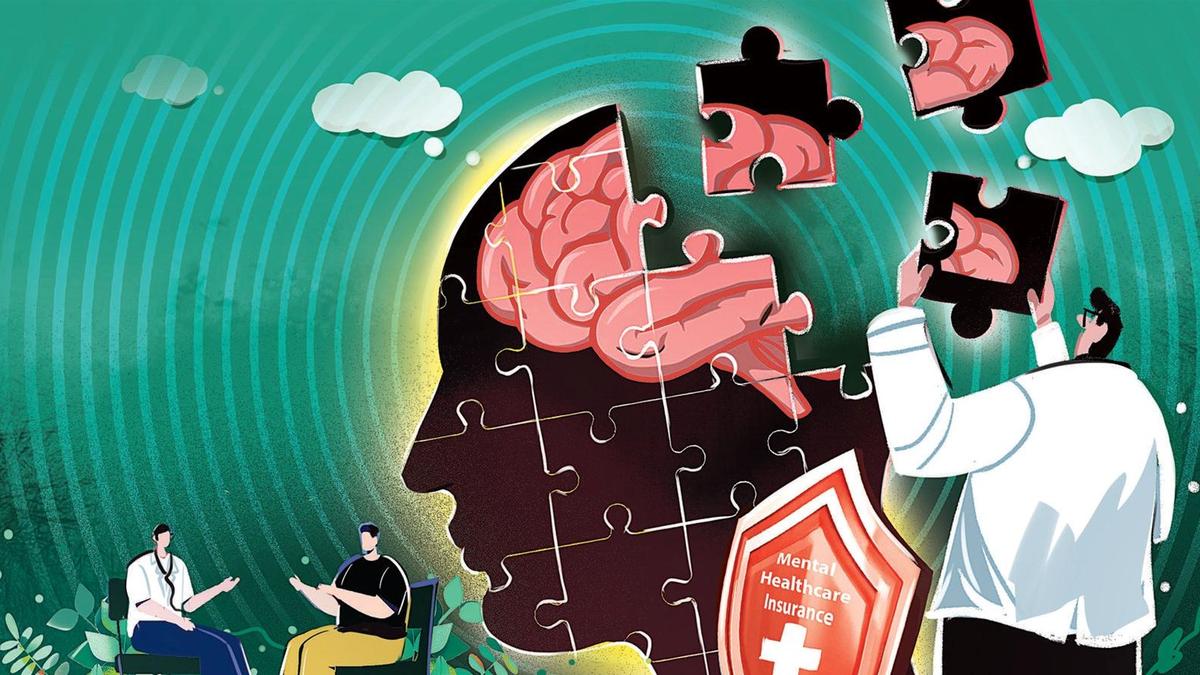
- 13 Jun 2025
Introduction
Mental health has long been neglected in mainstream healthcare discourse. However, recent developments, especially in the post-pandemic era, have sparked a paradigm shift in both public perception and policy priorities. With the Mental Healthcare Act, 2017 and subsequent directives from the Insurance Regulatory and Development Authority of India (IRDAI), mental health is now legally and practically on par with physical health in India’s insurance ecosystem.
Global and National Context
- According to the World Health Organization (WHO), mental health conditions affect 1 in 5 adults globally, resulting in over $1 trillion in productivity loss annually.
- In India, increased awareness and policy changes have led to mental health coverage being integrated into mainstream health insurance.
Policy Milestones and Insurance Evolution
- Mental Healthcare Act, 2017: A landmark legislation mandating equal treatment of mental and physical illnesses.
- IRDAI Directives: Instructed insurers to include mental illness in their policy coverage.
- Health Insurance Trends:
- Mental health–related claims (for therapy, stress, anxiety medication) have risen by 30–50% over the past 2–3 years.
- Outpatient Department (OPD) benefits now cover therapy, counselling, and psychiatric consultations.
Demographic and Behavioural Trends
1. Young Adults (25–35 years)
- Major drivers of insurance adoption for mental health.
- Key stressors include work-life imbalance, digital overload, and financial pressures.
- Show preference for app-based therapy and digital mental health platforms.
2. Women
- Higher uptake of mental health-inclusive policies.
- Insurance aligned with life-stage challenges (e.g., pregnancy, menopause, caregiving).
- Reflects increased cultural recognition of women’s emotional well-being needs.
3. Urban-Rural Divide
- Tier-1 cities account for over 50% of mental health insurance uptake.
- Better therapy networks, progressive employers, and higher digital literacy.
- Tier-2 cities showing promising growth in awareness and access.
Workplace Shifts
- Growing emphasis on mental wellness programs.
- Initiatives include:
- Stress management workshops
- In-house counsellor access
- Flexible work arrangements
- Indicates an evolving perception of mental health as integral to employee well-being.
Challenges Ahead
- Despite broader coverage, utilisation remains low due to:
- Lack of awareness about existing benefits (e.g., OPD coverage, cashless therapy).
- Social stigma and low mental health literacy.
- Accessibility gaps in rural and semi-urban areas.
Way Forward
- Awareness Campaigns: Promote knowledge of insurance entitlements and available services.
- Capacity Building: Increase mental health professionals and digital outreach platforms.
- School and Workplace Integration: Embed emotional literacy and psychological support in institutions.
- Insurance Product Innovation: Develop simplified, accessible plans tailored to diverse demographic needs.
- Data Collection and Monitoring: Use claim trends to shape targeted mental health interventions.
Conclusion
Mental healthcare in India is at a pivotal moment. The convergence of legal reform, insurance innovation, and shifting public attitudes is laying the foundation for a more inclusive and responsive mental health system. However, inclusion on paper must translate to accessibility in practice. Bridging this gap requires sustained efforts in awareness, education, and empathetic policy implementation.
Mental health is no longer an afterthought — it is an essential pillar of human well-being and economic productivity.
Reforming Research Procurement in India

- 09 Jun 2025
In News:
In a landmark move to boost scientific research and innovation, the Finance Ministry of India recently announced a series of reforms easing the procurement norms for scientific equipment. This policy shift addresses long-standing grievances from the research community about sub-standard materials, procedural delays, and restricted autonomy due to rigid procurement rules under the Government e-Marketplace (GEM).
Background: Challenges with GEM Procurement
The GEM portal, launched to promote “Make in India” procurement, mandated government institutions to source all goods through it. However, scientists highlighted serious concerns about its inefficiency, especially the inability to procure high-quality, customised scientific instruments required for cutting-edge research. Delays in procurement approvals and the necessity to first prove non-availability on GEM further hindered project timelines and research output.
Key Policy Reforms and Amendments
To rectify these issues, the government amended the General Financial Rules (GFR), introducing the following major changes:
- Exemption from GEM Mandate:
- Select scientific institutions and universities are now allowed to procure equipment and consumables outside the GEM portal.
- This restores procurement autonomy to Directors, Vice-Chancellors, and Chancellors—similar to the pre-GEM era—enabling timely purchases from specialised, quality vendors.
- Enhanced Financial Autonomy:
- Without Quotation: Procurement limit increased from ?1 lakh to ?2 lakh for direct purchases.
- Purchase Committee Limit: Raised from ?10 lakh to ?25 lakh, enabling quicker institutional decision-making.
- Tender Enquiry Ceiling: Enhanced from ?50 lakh to ?1 crore, facilitating mid-level procurements efficiently.
- These changes reflect inflation adjustments and reduce the administrative burden on research institutions.
- Global Tender Enquiry (GTE):
- Directors and Vice-Chancellors are now authorised to approve GTEs up to ?200 crore, a responsibility earlier restricted to departmental Secretaries.
- This decentralisation helps avoid bottlenecks and streamlines large-scale procurements critical for advanced R&D.
Strategic Relevance and Broader Objectives
These reforms are strategically aligned with India’s aspirations under Atmanirbhar Bharat and its goal to emerge as a global science and technology leader. By reducing bureaucratic hurdles, enhancing institutional autonomy, and ensuring timely access to world-class research tools, the reforms empower innovation across sectors like health, defence, space, and agriculture.
Institutions benefitting from these measures include:
- Department of Science and Technology (DST)
- Department of Biotechnology (DBT)
- Council of Scientific and Industrial Research (CSIR)
- Department of Atomic Energy (DAE)
- Indian Council of Medical Research (ICMR)
- Indian Council of Agricultural Research (ICAR)
- Defence Research and Development Organisation (DRDO)
- Postgraduate research institutions under central and state universities
Conclusion
The revised GFR norms signify a progressive policy intervention aimed at creating a facilitative research ecosystem in India. By streamlining procurement, restoring institutional trust, and removing operational roadblocks, the government has responded positively to the scientific community's demands. As acknowledged by Science Minister Jitendra Singh, this reform is not just administrative; it is transformative—unlocking India's potential for innovation and scientific excellence.
Empowering India’s Elderly through Age-Tech

- 14 Apr 2025
In News:
India is undergoing a demographic transition, with its senior citizen population (aged 60+) currently at 15 crore, projected to rise to 32 crore by 2050. This unprecedented ageing poses socio-economic challenges, especially in urban areas like Bengaluru, where shrinking family structures leave many elderly citizens isolated and purposeless. To address these concerns, a new sector—age-tech—is emerging, leveraging technology to support the physical, emotional, and cognitive well-being of the elderly.
Understanding Age-Tech and its Role
Age-tech refers to technology-driven solutions tailored to the elderly’s needs. Bengaluru has emerged as a hub of innovation in this domain. Platforms like Sukoon Unlimited, founded in 2024, create communities where seniors engage in emotional counselling, volunteering, group therapies, and concierge services. Notably, both service providers and receivers are senior citizens, fostering peer support and a sense of purpose. Sukoon’s community has grown from 200 to 6,000 members across 400 towns in a year.
Technology is also being used to combat loneliness. WHO in 2022 highlighted that one in four older adults suffers from social isolation, increasing mortality risk. AI-powered conversational tools are being employed by platforms like Sukoon to provide companionship in over 100 languages.
Employment and Purpose in Silver Years
Age-tech also facilitates post-retirement employment. Wisdom Circle, for instance, connects retired professionals with employers seeking experienced talent. With 95,000 users and 1,500 companies onboard, it promotes hybrid and part-time roles. Beyond financial gain, seniors are driven by the need for relevance and contribution to society—many even apply for lower-paid or non-profit roles.
Addressing Cognitive and Physical Health
The cognitive health of seniors is another pressing concern. Over 80 lakh Indians currently suffer from dementia. Ivory, a cognitive health start-up, offers neuroscience-backed assessments to detect risks early and recommends personalized brain training. It has over 30,000 users, predominantly women from urban areas.
Orthopaedic health is also crucial. Around 50% of seniors need assistance with basic mobility. TransleadMedtech, an IISc-incubated start-up, has developed assistive chairs and commodes to aid mobility without power sources. With rising knee replacements, such innovations are critical for safety and dignity in ageing.
Challenges and the Digital Divide
Despite potential, age-tech faces hurdles. Experts warn that over-engineering tech can alienate elderly users. Solutions must be designed with the user’s needs, not just tech potential, in mind. The urban-rural divide is stark—most services target urban, financially independent seniors, excluding rural and low-income populations.
Additionally, rapid digitisation has excluded many elderly from essential services like transport and e-commerce. Digital illiteracy also exposes them to scams. Startups like Elderra work to bridge this gap by training seniors in basic digital tools.
Way Forward
For age-tech to become inclusive, the government must play an enabling role. Public-private partnerships can make these services affordable and accessible. Ageing with dignity should be a national priority, combining technology, policy, and empathy to ensure India’s elderly are not left behind in the digital era.
Jyotiba Phule: Pioneer of Social Justice and Emancipation
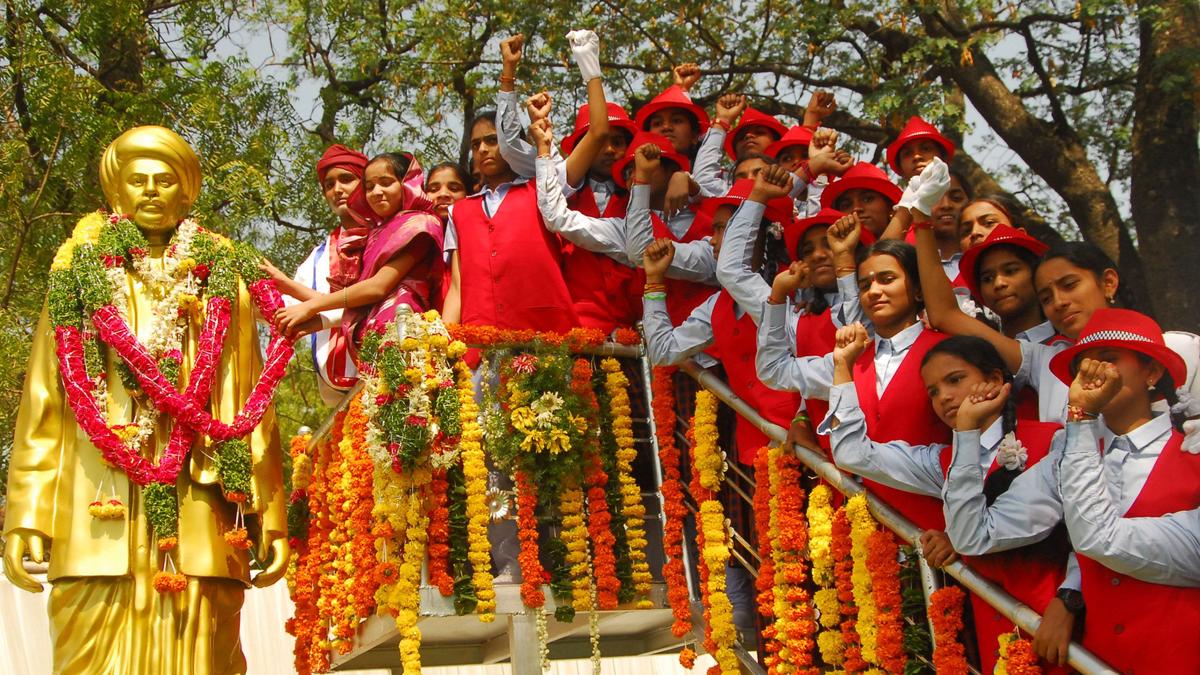
- 13 Apr 2025
Introduction:
Jyotiba Phule (1827–1890) stands out as one of the foremost social reformers of 19th-century India, whose contributions to education, caste reform, women's rights, and rationalist thought continue to influence contemporary debates on social justice.
Born into the Mali casteinMaharashtra, Phule’s awakening began in 1848 after facing caste-based humiliation at a Brahmin wedding. That same year, inspired by Cynthia Farrar (a Christian missionary) and rationalist Thomas Paine, he and his wife Savitribai Phule established India’s first school for girls. By 1851, they had opened 18 schools, and later, night schools for workers and women—challenging both gender and caste hierarchies in education.
Phule’s activism extended beyond education. In 1873, he founded the SatyashodhakSamaj (Society of Truth Seekers), an organization aimed at eradicating caste-based oppression and challenging Brahminical dominance. His work Gulamgiri (Slavery) (published in 1873) likened the condition of Dalits and Shudras to that of African-American slaves, emphasizing systemic subjugation through religious orthodoxy.
Phule argued for compulsory primary education, particularly for the rural poor. In his Statement to the Education Commission, he recommended scholarships, annual prizes, and mandatory schooling up to age 12, noting that agricultural poverty kept children away from education.
In his agrarian treatise ShetkaryancheAsud (Farmer’s Whip), Phule proposed:
- Employing army personnel in public works like dams and bunds.
- Returning village pasture lands from the Forest Department.
- Importing cattle for meat to preserve draught animals crucial to agriculture.
These proposals reflected his commitment to economic upliftment of farmers and sustainable agricultural practices.
Phule’s spiritual views evolved toward rational humanism. Though he respected the equality-based ethics in Islam and Christianity, his final philosophical work, Sarvajanik Satya Dharma Pustak, rejected all sectarian religious texts and called for a universal spiritual order. He questioned caste sanctity, ridiculed the notion of sacred superiority, and criticized the irrationalities in scriptural justifications.
He strongly supported women’s rights, defended PanditaRamabai’s conversion, and denounced polygamy, arguing for gender parity in both religious and social spheres. He wrote, “How would men feel if women married more than one man?”
Despite opposition from Bal Gangadhar Tilak and orthodox Hindu nationalists, Phule remained focused on uplifting the oppressed, even bailing Tilak out of jail at one point—illustrating his commitment to justice over personal differences.
Phule’s legacy remains crucial in modern India’s quest for social equity. His efforts to democratize education, dismantle caste, and promote inclusive governance laid the groundwork for India's later constitutional and social reforms.
Technology Industry and Climate Goals
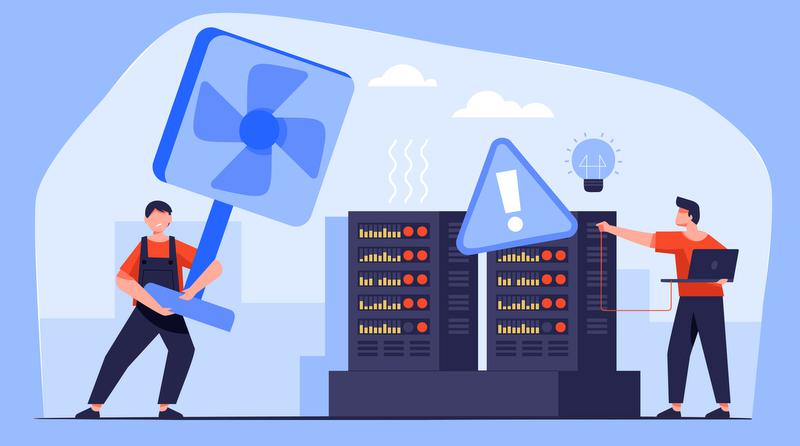
- 03 Jun 2025
Introduction
The global technology sector, while being a driver of economic growth and innovation, is also a significant contributor to greenhouse gas (GHG) emissions. With the rapid expansion of cloud computing and digital services, data centres—the backbone of the digital economy—consume massive amounts of energy, primarily for cooling.
A recent landmark study by Microsoft and WSP Global, published in Nature, highlights the potential of advanced cooling technologies to significantly reduce the environmental footprint of data centres.
The Problem: Heat and Emissions from Data Centres
- Energy Consumption: In modern data centres, cooling systems consume nearly as much electricity as computing itself.
- Heat Management: As chips become smaller and faster, they generate more heat. Without effective cooling, systems overheat, leading to failure and reduced efficiency.
- Climate Targets: The Information and Communications Technology (ICT) sector aims to reduce emissions by 42% by 2030 (from 2015 levels) and achieve net-zero by mid-century.
Cooling Innovations: The Game-Changers
1. Cold Plate Cooling (Direct-to-Chip Cooling)
- Coolant flows through microchannels on a plate attached directly to the chip.
- Reduces the need for energy-intensive air conditioning.
- Heat is transferred away efficiently and silently.
2. Immersion Cooling
- Entire hardware systems are submerged in thermally conductive, non-conductive liquid.
- Uses one-phase (liquid remains stable) or two-phase (liquid vaporises and condenses) systems.
- Ensures near-total heat dissipation and longer component life.
Environmental Impact (Study Findings):
Compared to traditional air cooling:
- GHG Emissions ↓ by 15–21%
- Energy Use ↓ by 15–20%
- Water Consumption ↓ by 31–52%
With 100% renewable energy:
- Emissions ↓ by 85–90%
- Water use ↓ by 55–85%
Tech Industry’s Broader Climate Actions
- Carbon Credits: Google, Netflix, and others invest in verified carbon offsets.
- Blockchain for Carbon Markets: Ensures transparency; used by Indian IT firms for ESG compliance.
- Renewable Energy: Tech giants like Apple, Meta, and Amazon power operations with green energy.
- Indian Leadership: Infosys, Reliance, and Tech Mahindra lead in green operations using AI and energy-efficient systems.
Challenges and Limitations
- Lifecycle Trade-offs: Coolant production and disposal can offset benefits.
- Capital Cost: Retrofitting old data centres is expensive.
- Regulatory Issues: Lack of global standards for coolants and fragmented carbon credit policies.
- Dependence on Grid: Benefits are reduced if electricity is still coal-based.
- Slow Deployment: Complex designs and supply chain delays hinder implementation.
Way Forward
- Life Cycle Assessments (LCAs): Evaluate true environmental costs over the product lifecycle.
- Unified Carbon Standards: Develop global frameworks for carbon credit verification and climate disclosures.
- Government Support: Provide tax incentives, green finance, and subsidies for early adopters.
- Strengthen R&D: Focus on low-impact coolants and AI-driven cooling systems.
- Public-Private Partnerships: Encourage innovation through collaboration among tech firms, startups, and governments.
Conclusion
The technology industry stands at a crossroads where sustainable innovation is essential. Cooling technologies like cold plates and immersion cooling, coupled with renewable energy adoption and carbon offset mechanisms, can enable the ICT sector to significantly reduce its environmental footprint. With effective policy support and strategic innovation, the tech sector can become a pillar of global climate action.
Deputy Speaker of Lok Sabha
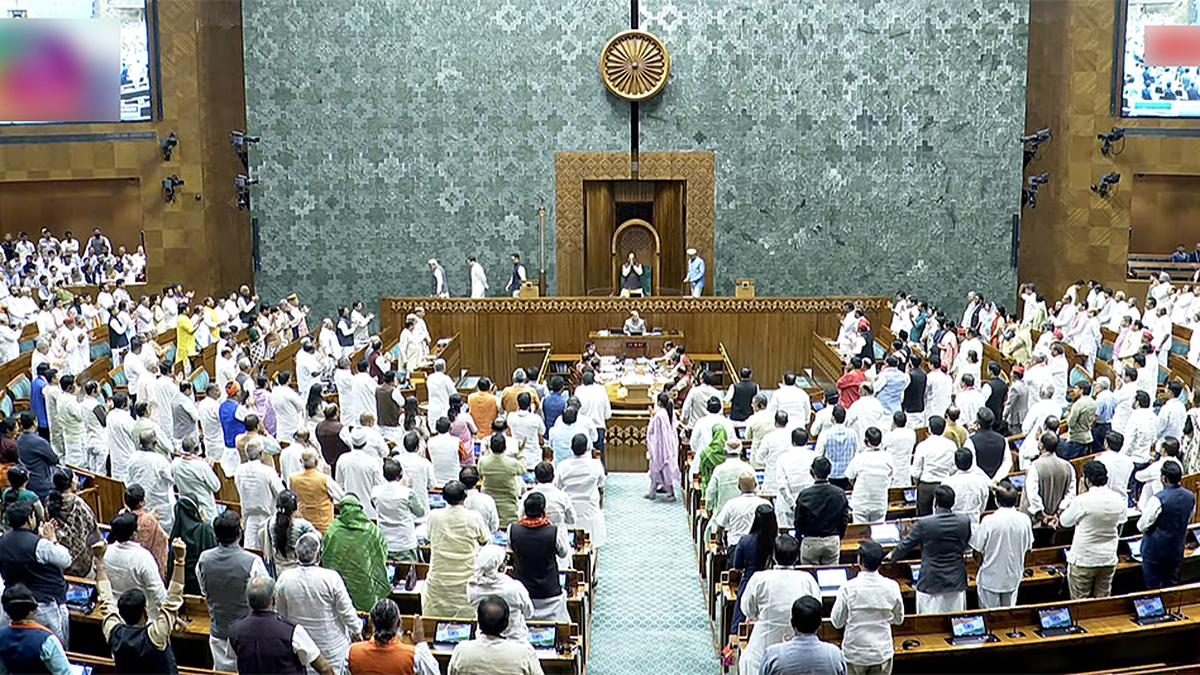
- 30 May 2025
In News:
The office of the Deputy Speaker of the Lok Sabha, though not explicitly bound by rigid timelines, holds constitutional and democratic significance in India's parliamentary democracy. Under Article 93 of the Constitution, the Lok Sabha must elect a Speaker and Deputy Speaker from among its members "as soon as may be." Despite this mandate, the Deputy Speaker’s post has remained vacant since June 2019, reflecting a deepening divergence from constitutional propriety and democratic convention.
Constitutional Framework and Election Process
The Deputy Speaker is elected by Lok Sabha members, with the election date fixed by the Speaker and communicated through a parliamentary bulletin. As per Article 94, the Deputy Speaker remains in office until resignation, disqualification, or removal by a resolution supported by a majority. If the seat falls vacant, the House must elect a replacement. Constitutionally, under Article 95, the Deputy Speaker exercises all powers of the Speaker in their absence, including presiding over sessions, maintaining order, and ensuring legislative discipline.
While the Constitution does not mandate a time frame for this election, the phrase “as soon as may be” is intended to ensure prompt appointment to avoid any constitutional vacuum. However, the absence of legal compulsion has been misinterpreted, leading to prolonged delays.
Functions and Powers
The Deputy Speaker assists the Speaker in running the House and steps in as presiding officer when the Speaker is absent. In legislative committees, if nominated, the Deputy Speaker automatically assumes chairmanship. Distinctively, unlike the Speaker, the Deputy Speaker may participate in debates and vote on all matters when not presiding. When chairing, however, the Deputy Speaker can only vote in case of a tie. The salary of the Deputy Speaker is charged on the Consolidated Fund of India, ensuring financial independence from executive discretion.
Parliamentary Convention and Historical Practice
India's parliamentary practice, inspired by the Westminster model, has traditionally ensured balance by allocating the Deputy Speaker’s post to the Opposition, especially since the post-Emergency era. Notable examples include G.G. Swell (1969–77) and Godey Murahari (1977–79), both from Opposition parties. The intent has been to uphold a power-sharing mechanism and offer space for dissent within the House's functioning.
Democratic Concerns Arising from Prolonged Vacancy
The continued absence of a Deputy Speaker through the 17th and now 18th Lok Sabha raises serious concerns. It undermines Articles 93–95, and violates Rule 8 of the Lok Sabha Rules (1952), which mandates timely election post a formal motion. The delay centralizes authority in the Speaker—typically from the ruling party—and distorts the democratic balance between treasury and Opposition benches.
Moreover, the non-appointment sidelines the principles of consensus-based governance and institutional checks and balances, weakening parliamentary accountability. It also poses risks during any potential Speaker vacancy, potentially triggering a constitutional crisis.
Conclusion
The Deputy Speaker's post is not a ceremonial redundancy but a constitutional necessity for balanced legislative functioning. Upholding this institution is critical for the health of India’s democracy. The ongoing vacancy reflects not just administrative inaction but a gradual erosion of parliamentary conventions, warranting urgent political consensus and constitutional fidelity.
Waqf (Amendment) Bill, 2025
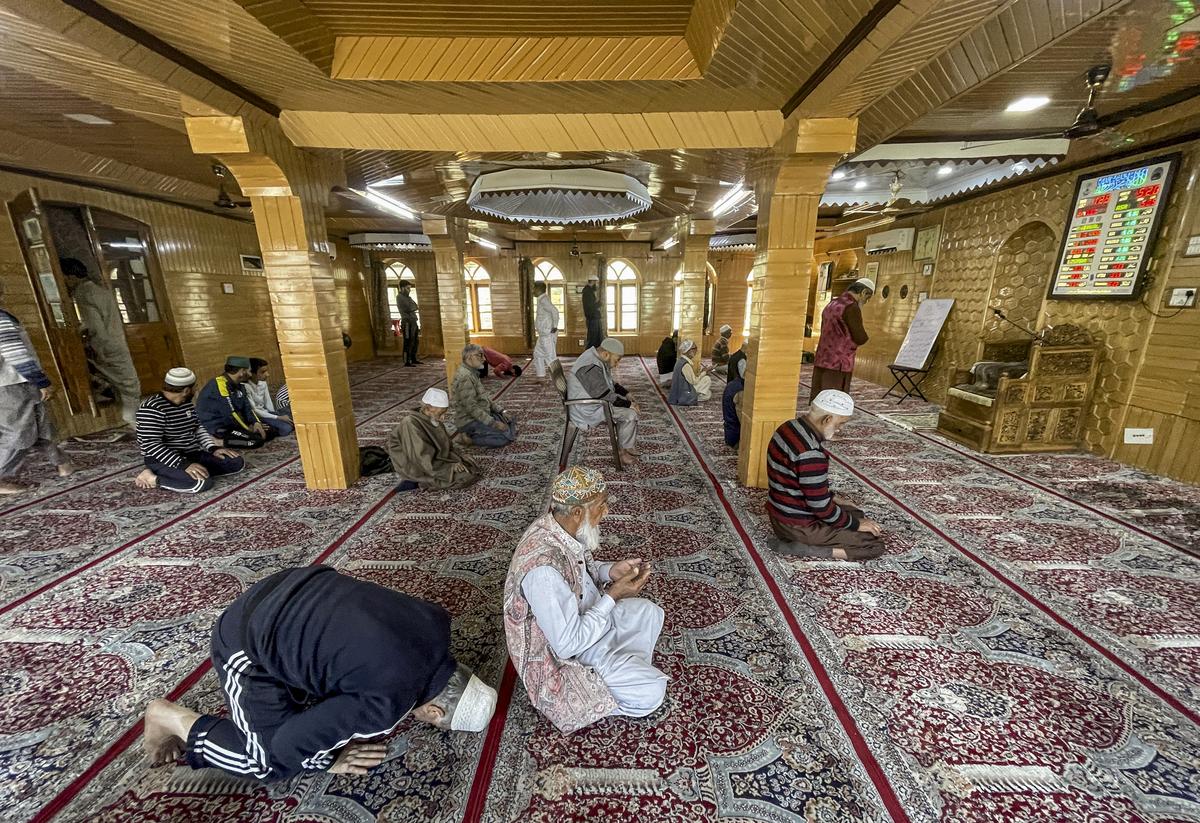
- 05 Apr 2025
In News:
The Waqf (Amendment) Bill, 2025, tabled in the Lok Sabha on April 2, 2025, seeks to amend the Waqf Act, 1995, which governs the administration of waqf properties in India. The revised Bill incorporates the recommendations of a Joint Parliamentary Committee (JPC) and has sparked significant political and community debate due to its proposed structural and procedural reforms.
1. Retention and Restriction of ‘Waqf by User’ Doctrine
- Background: The doctrine allows property to be treated as waqf based on uninterrupted communal usage, even without formal documentation.
- Revised Provision: Retains ‘waqf by user’ for properties registered before the enactment of the law but prohibits its use for future claims.
- Criticism: The introduction of a clause requiring individuals to prove Islamic practice for five years to establish waqf status is seen as exclusionary and arbitrary.
2. Inclusion of Non-Muslims in Waqf Institutions
- Provisions:
- Mandates the inclusion of at least two non-Muslims in the Central Waqf Council and State Waqf Boards.
- Removes the requirement that the CEO of a Waqf Board be Muslim.
- Redefines Waqf Tribunals to include a district judge, a Joint Secretary-level officer, and a Muslim law expert.
- Criticism: Raises questions about community autonomy in religious affairs under Article 26 of the Constitution.
- Government's Justification: Aims to enhance expertise, transparency, and administrative efficiency.
3. Enhanced Government Oversight in Waqf Property Surveys
- New Mechanism:
- Surveys to be conducted by senior officials above the rank of District Collector.
- Such officers will serve as the final authority in determining whether land is waqf or government-owned.
- Tribunal jurisdiction curtailed in such disputes.
- Implications:
- Centralizes decision-making within the state bureaucracy.
- Raises concerns about executive overreach and weakening of judicial oversight in waqf matters.
4. Centralised Registration and Digital Governance
- Digital Portal:
- Mandatory online registration of all waqf properties within six months.
- Extensions can be granted by waqf tribunals upon demonstration of "sufficient cause."
- Objective: To curb encroachment, enhance transparency, and create a uniform digital record of waqf assets.
5. Application of the Limitation Act, 1963
- Change Introduced: Repeals Section 107 of the Waqf Act, 1995, which exempted waqf properties from the statutory limitation period.
- Implication: Allows claims of adverse possession after 12 years; may legitimize longstanding illegal occupations of waqf land.
- Opposition View: Seen as a move that undermines waqf rights and aids encroachers.
6. Judicial Review and Appeals
- Revised Provision:
- Waqf tribunal decisions are no longer final.
- Appeals can be made to the High Court within 90 days.
- Courts can dismiss suits if properties are not registered within the stipulated time unless “sufficient cause” is shown.
- Impact: Enhances judicial scrutiny but also limits access to justice in certain cases through procedural conditions.
Critical Analysis
- Pros:
- Encourages transparency and formalisation of waqf governance.
- Introduces checks against misuse and encroachments.
- Provides a digital framework for property management.
- Cons:
- Risks state interference in religious institutions, impacting minority rights under Articles 25–28.
- Exclusion of oral traditions may erase significant community practices and histories.
- Implementation challenges due to administrative overburden and community mistrust.
Conclusion
The Waqf (Amendment) Bill, 2025, represents a significant shift in the governance of waqf properties by increasing state oversight, standardising processes, and promoting digital reforms. However, it raises serious questions about religious autonomy, federal balance, and minority rights. A careful balance between administrative efficiency and constitutional guarantees is essential to ensure inclusive and equitable governance.
India’s Air Pollution Crisis

- 03 Apr 2025
Context:
India’s air pollution crisis has evolved from a seasonal concern into a persistent public health emergency. Urban skylines disappearing under layers of smog, overflowing hospitals with respiratory cases, and frequent school closures point to the alarming scale of the issue. Indian cities consistently rank among the most polluted globally, and without a coordinated, inclusive, and locally-driven strategy, the situation may deteriorate further.
Institutional and Structural Complexities
Air pollution in India is not merely a technical issue; it is deeply embedded in structural and governance-related challenges. It reflects a mix of socio-economic disparities, weak municipal capacity, behavioral norms, and fragmented institutional mandates. Municipal bodies — key actors in controlling local pollution sources — often lack adequate funding, data access, and administrative autonomy. Their responsibilities are rarely aligned with national clean air targets.
India aims to reduce PM2.5 levels by 40% (from 2017 levels) by 2026 under the National Clean Air Programme (NCAP), but progress remains slow. This is due in part to a reliance on ambient air quality data, which can fluctuate based on meteorological factors and may not accurately reflect ground-level interventions. A shift toward activity-based metrics — such as the number of biomass stoves replaced or diesel vehicles retired — is needed to measure real impact.
Key Interventions and Their Gaps
India has introduced several programs to combat air pollution:
- National Clean Air Programme (NCAP): Targets 20–30% reduction in PM10 and PM2.5 by 2026 in 132 cities.
- Bharat Stage VI (BS-VI): Introduced in 2020 to enforce strict vehicular emission norms.
- Pradhan Mantri Ujjwala Yojana (PMUY): Promotes LPG usage to reduce dependence on biomass.
- FAME II: Incentivizes electric vehicles.
- Swachh Bharat Mission (Urban): Addresses urban waste, a significant pollution source.
However, between 2019 and 2023, only about 60% of NCAP funds were utilized — not due to lack of intent, but due to institutional misalignment and poor coordination. Additionally, India’s clean air budget is dwarfed by global comparisons; China invested ?22 lakh crore over five years, while India’s NCAP allocation is less than 1% of that. Even when related programs (PMUY: ?18,128 crore; FAME II: ?10,795 crore; SBM-U: ?1.4 lakh crore) are included, the challenge lies in integrating these efforts meaningfully.
The Need for a Phased, Data-Driven Approach
A transformative clean air strategy should include:
- Phase I: Build high-resolution, local emissions inventories.
- Phase II: Link funding to data-driven, actionable plans.
- Phase III: Track reductions in emissions, not just pollution concentrations.
Governance reforms must empower local authorities, integrate air quality goals into urban planning, and ensure open access to real-time emissions data.
Guarding Against Technological Overdependence
India must avoid over-reliance on AI dashboards, smog towers, and other high-tech tools that may benefit elite urban areas while neglecting rural and informal sectors — major contributors to emissions. Instead of focusing on optics, efforts must prioritize structural reforms and equitable interventions.
Global Lessons, Local Adaptation
India can learn from other countries:
- China: Closed coal plants aggressively.
- Brazil: Enabled community-led waste management.
- California: Reinvested pollution revenue in vulnerable populations.
- London: Implemented bans before adopting high-tech monitoring.
India’s path must be rooted in federalism, tailored to its informal economy, and driven by behavioral and structural change. Clean air must be recognized as a universal right, not a privilege — and achieving it demands people-centric governance, consistent funding, and courageous implementation.
Why India needs stable urban forests
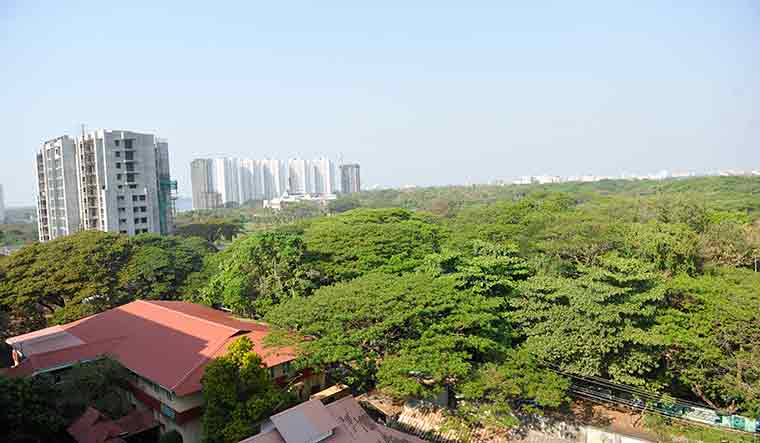
- 24 May 2025
In News:
Urban forests are increasingly emerging as critical ecological buffers amidst India’s rapidly expanding cities. The recent controversy over the Kancha Gachibowli forest in Hyderabad—where 400 acres of urban forest land were earmarked for industrial development—has reignited debates on sustainable urbanisation and environmental governance. The Supreme Court’s intervention to halt further deforestation underscores the urgent need to prioritise ecological assets in urban planning.
Importance of Urban Forests
Urban forests such as Kancha Gachibowli (Hyderabad), Aarey (Mumbai), Turahalli (Bengaluru), Neela Hauz and the Ridge (Delhi), and Dol Ka Baadh (Jaipur) play a vital role in maintaining ecological balance within metropolitan environments. Their multifaceted contributions include:
- Air Pollution Mitigation: Urban forests absorb pollutants such as PM2.5 and PM10, which are major contributors to urban air pollution from vehicular emissions and construction activity.
- A 2006 study by the USDA Forest Service found that one hectare of forest can remove approximately one ton of air pollutants annually.
- In November 2024, the Central Pollution Control Board (CPCB) recorded a hazardous AQI of 494 in Delhi, highlighting the urgent need for natural air purifiers.
- Climate Regulation: These forests help reduce the urban heat island effect, control stormwater runoff, and mitigate urban flooding and erosion.
- Carbon Sequestration: Trees in urban forests trap atmospheric carbon, contributing to climate change mitigation efforts.
- Biodiversity Preservation: They serve as urban habitats for endangered birds, insects, and other fauna, supporting biodiversity within city limits.
- Socio-Cultural Benefits: Urban forests offer green spaces for recreation, promote mental well-being, and enhance the overall livability of urban areas.
Threats and Challenges
Despite their importance, urban forests in India face increasing threats due to:
- Unregulated Urban Expansion: Urban planning often disregards ecological sustainability, prioritising infrastructure and industrial development over green spaces.
- Lack of Legal Clarity: State governments sometimes contest the status of forest lands, as seen in Telangana’s claim over Kancha Gachibowli, undermining forest protections.
- Real Estate Pressures: Encroachments and land-use changes for commercial gain are frequent, with environmental concerns often sidelined.
Judicial Interventions and Constitutional Provisions
Indian courts have played a pivotal role in safeguarding urban forests:
- T.N. GodavarmanThirumulpad Case (1996): Expanded the definition of "forest" to include areas recorded as forest in government records, irrespective of ownership or classification.
- Delhi High Court (2015): Directed the protection and notification of the Delhi Ridge forest.
- Supreme Court Stay on Aarey Tree Felling (2020): Responded to civil society petitions to preserve Mumbai’s Aarey forest.
- Rajasthan High Court Suo Motu Action (2024): Intervened against deforestation in biodiversity-rich Baran district.
Constitutional Backing:
- Article 21: Guarantees the Right to Life, interpreted by courts to include the right to a clean and healthy environment.
- Article 48A: Directs the State to protect and improve the environment.
- Article 51A(g): Makes it a fundamental duty of citizens to protect the natural environment.
Policy Interventions: Nagar Van Yojana
In response to growing ecological concerns, the Ministry of Environment, Forest and Climate Change (MoEF&CC) launched the Nagar Van Yojana in 2020 with the goal of developing 1,000 urban forests by 2027.
- As per the India State of Forest Report 2023, the initiative has already led to an increase of 1,445.81 sq km in tree and forest cover in urban areas.
- The scheme aligns with other policy frameworks such as the National Forest Policy (1988) and the National Mission for Green India (2014), which promote afforestation and ecological restoration.
Way Forward
To ensure sustainable urbanisation, India must:
- Integrate ecological planning into urban masterplans, with mandatory forest inventories and zoning protections.
- Strengthen legal protections for notified and unnotified forests within urban areas.
- Foster community participation and civil society engagement in urban environmental stewardship.
- Promote green infrastructure through Smart Cities and AMRUT missions.
Conclusion
Urban forests are not peripheral luxuries but ecological necessities. Their conservation is essential for ensuring environmental resilience, public health, and urban quality of life. As India continues its urbanisation journey, a harmonious balance between development and ecological preservation is indispensable.
Overfishing in India

- 23 May 2025
Context:
India, the second-largest fish-producing nation globally, contributes around 8% to world fish production. With an estimated marine fisheries potential of 5.31 million tonnes, India’s sector has reached its maximum sustainable yield, currently stabilizing at 3–4 million tonnes annually. However, this apparent success masks deep ecological and socio-economic distress, primarily due to overfishing.
Inequity and Overexploitation
Despite their 90% share in the fishing population, small-scale fishers harvest merely 10% of the total catch, while mechanised trawlers dominate volumes. This has left three-fourths of marine fisher families below the poverty line. Escalating the problem is the race to increase yields using more powerful engines and finer mesh nets—leading to marginal gains at steep ecological and financial costs.
Trawling operations, especially shrimp trawlers, demonstrate the magnitude of bycatch—where for every kilogram of shrimp, over 10 kg of juvenile and non-target species are discarded. Such practices degrade marine biodiversity, deplete spawning stocks, and destabilise food webs. Examples from Canada’s cod fishery (1992) and California’s sardine fishery collapse (1960s–80s) show the irreversible impacts of mismanaged stocks.
Policy Fragmentation and Regulatory Loopholes
Each coastal state in India governs its marine fisheries through its own Marine Fisheries Regulation Act (MFRA), resulting in a regulatory patchwork. Fishers exploit these inconsistencies—for example, landing juvenile fish legally in one state that are protected in another. This undermines conservation and facilitates laundering of protected species.
Moreover, the fish-meal and fish-oil (FMFO) industry fuels ecological damage by incentivising bycatch. Much of this low-value catch is processed into meal, mostly for export, depriving domestic consumers and aquaculture of vital nutritional inputs.
Government Initiatives
The Union Budget 2025–26 allocated a record ?2,703.67 crore to the fisheries sector, focusing on the sustainable harnessing of resources from the EEZ and high seas, especially around Lakshadweep and the Andaman & Nicobar Islands. Key schemes include:
- Pradhan Mantri MatsyaSampada Yojana (PMMSY): Focuses on inland fisheries and aquaculture for food security.
- Blue Revolution Scheme: Enhances productivity in marine and inland fisheries.
- Technological Interventions: Satellite-based vessel tracking, Oceansat for forecasting Potential Fishing Zones (PFZ), and GIS mapping are being deployed.
Path to Sustainability
India’s National Policy on Marine Fisheries (2017) embeds sustainability at its core, promoting measures like:
- 61-day uniform fishing bans during monsoons;
- Prohibitions on harmful methods like pair and bull trawling, and LED light usage;
- Promotion of mariculture, artificial reefs, and sea ranching.
Successful models abroad offer direction. New Zealand’s Quota Management System (QMS) aligns catch limits with stock assessments and uses transferable quotas to regulate fishing. India could pilot such a model for its mechanised fleet.
Domestically, Kerala’s enforcement of a Minimum Legal Size (MLS) for threadfin bream boosted catches by 41% in one season. Scaling such practices nationally can ensure ecological recovery and economic benefits.
Way Forward
India must urgently move towards a unified, science-based regulatory framework, including:
- National MLS norms,
- Gear restrictions to reduce juvenile catch,
- Scientific catch limits,
- Closed seasons aligned with spawning cycles.
Simultaneously, fisher cooperatives must be empowered, FMFO quotas capped, and consumer awareness campaigns launched to encourage demand for legally sized, sustainable seafood.
In conclusion, India stands at a critical juncture. Ignoring overfishing risks deepening poverty and ecological collapse. The solutions—rooted in science, equity, and sustainability—are within reach and must be swiftly implemented to safeguard marine wealth and livelihoods for future generations.
Road Safety in India
- 16 May 2025
Context:
India is at a critical juncture in its mobility transformation. With over 6.3 million km of road network, the second-largest globally, the nation faces a paradox: rapid urbanisation and vehicle growth have brought both economic momentum and a rising toll of road fatalities. In 2022, India recorded 1.68 lakh road deaths, translating to 12.2 deaths per 1 lakh population—substantially higher than countries like Japan (2.5) and the UK (2.6). These crashes cost India 3% of its GDP annually, eroding human capital and stalling development.
Road Safety as a Fundamental Right
The right to safe mobility stems from Article 21 of the Constitution, which guarantees the right to life. This makes road safety not merely a technical issue but a public good and a human right. With India’s urban population expected to reach 50% by 2047, ensuring the safety of all road users—particularly pedestrians, cyclists, elderly, and children—is essential for inclusive development.
Key Challenges in India’s Road Safety Landscape
- Human Error: About 78% of crashes are due to driver fault—overspeeding, drunk driving, and poor lane discipline.
- Infrastructure Gaps: Over 5,000 black spots, inadequate pedestrian zones, and unscientific road designs persist across urban and rural areas.
- Weak Enforcement: Despite the Motor Vehicles (Amendment) Act, 2019, enforcement is inconsistent, and deterrence is weak.
- Emergency Care Deficits: Rural areas suffer from delayed trauma response, poor ambulance coverage, and lack of cashless care.
- Fragmented Governance: Overlapping responsibilities between Centre and States lead to diluted accountability and suboptimal implementation.
Government Response: The Four Es Framework
- Engineering: Mandatory safety audits, black spot rectification, e-DAR digital accident recording, and vehicle safety mandates (airbags, ABS, Bharat NCAP ratings).
- Enforcement: e-Challans, CCTV-based monitoring, automated vehicle fitness testing, and stricter penalties under the MV Act.
- Education: Road Safety Advocacy Scheme, National Road Safety Month, driver training centres in every district.
- Emergency Care: Good Samaritan protections, ambulances with paramedics at toll plazas, and pilot cashless treatment schemes.
Strategic Roadmap:
- Safe System Approach: Design roads that are forgiving of human error—wider footpaths, dedicated cycling lanes, pedestrian islands, and speed calming measures.
- National Road Safety Authority: A unified central body to integrate policy, funding, and enforcement between Centre and States.
- Innovative Financing: Mandate auto manufacturers to channel CSR funds into road safety initiatives for 20–25 years, supporting infrastructure, trauma care, and R&D.
- Data-Driven Policies: Strengthen digital accident databases to enable evidence-based decision-making and real-time response.
- Capital Investment: Adopt the World Bank’s recommendation of $109 billion investment over a decade to halve road deaths by 2030.
Conclusion
Road safety is not an adjunct concern—it is integral to India’s Vision of Viksit Bharat 2047. Reducing road fatalities is essential for economic productivity, public health, and constitutional morality. A coordinated, inclusive, and adequately financed national strategy can transform India’s roads from death traps into pathways of safe, equitable mobility.
Judicial Remedies and Systemic Reforms for Effective Waste Management in India
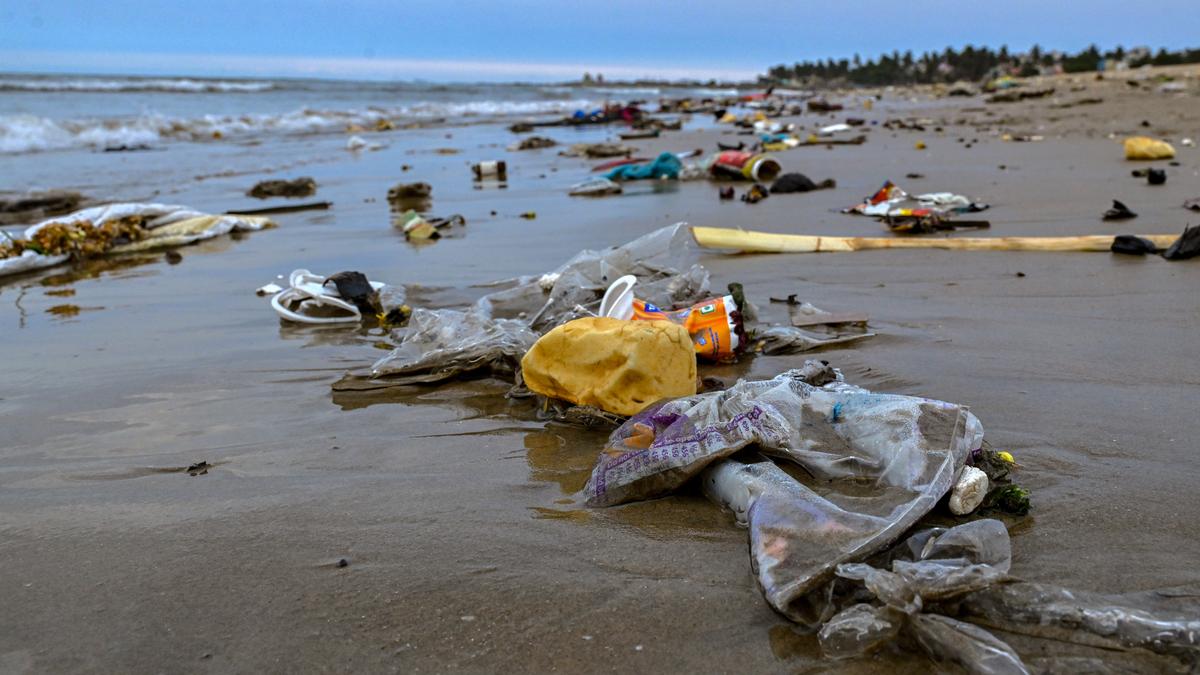
- 04 May 2025
Context:
India is currently facing an escalating waste management crisis, exacerbated by rising urbanization, inadequate infrastructure, and weak enforcement. According to a 2024 study published in Nature, India is the world’s largest plastic polluter, emitting 9.3 million tonnes (Mt) of plastic annually—nearly 20% of global plastic emissions. This is largely due to widespread mismanaged waste, including open dumping and burning.
Despite claims of 95% national waste collection coverage, the situation on the ground reveals stark contrasts. Dumpsites outnumber sanitary landfills by a ratio of 10:1, and rural areas along with the informal sector remain excluded from official data. The actual per capita plastic waste generation in India may be as high as 0.54 kg/day, much higher than the reported 0.12 kg/day.
The problem is particularly acute in ecologically sensitive areas like the Indian Himalayan Region, where data gaps, poor infrastructure, and lack of state capacity have led to severe plastic accumulation, threatening biodiversity and public health.
According to TheEnergy and Resources Institute (TERI), India generates 62 Mt of waste annually, including 5.6 Mt of plastic waste, 7.9 Mt of hazardous waste, and 1.5 Mt of e-waste. However, only 43 Mt is collected, with 12 Mt treated, and 31 Mt remains untreated in waste yards.
Institutional and Legal Framework
India has implemented several regulatory frameworks under the Environment (Protection) Act, 1986, such as the Solid Waste Management Rules (2016), Plastic Waste Management Rules (2016), and the E-Waste Management Rules (2022). The Extended Producer Responsibility (EPR) mechanism mandates producers to manage the entire lifecycle of products. As of 2022, EPR has been extended to plastic packaging, battery waste, and used oil.
Initiatives like Swachh Bharat Mission (SBM) and Waste to Wealth have promoted community engagement and technology use. SBM Urban 2.0 aims to create "Garbage Free Cities" by enhancing material recovery and waste-to-energy infrastructure. By 2024, 4.75 lakh villages had solid waste systems, and 5.14 lakh had liquid waste management systems.
Challenges
However, implementation gaps persist. Waste audits are inconsistent, especially in rural areas governed by Panchayati Raj institutions. Infrastructure for segregation, recycling, and recovery is insufficient. Establishing kiosks and MRFs in remote areas remains a logistical and financial challenge.
Way Forward: Judicial and Systemic Interventions
A promising approach is the use of continuing mandamus by the judiciary. In the 2025 Vellore District Environment Monitoring Committee vs. District Collector case, the Supreme Court emphasized remediation under the “polluter pays” principle. Judicial mandates for compliance, third-party audits, and public data transparency can significantly enhance accountability.
Technological tools like geotagging waste infrastructure on EPR portals can improve tracking and efficiency. Local bodies must be integrated with MRFs, recyclers, and EPR kiosks for seamless waste flow.
Additionally, product redesign for circularity, international cooperation through platforms like GACERE, and citizen engagement are critical to building a sustainable waste management ecosystem.
Bonded Labour in India
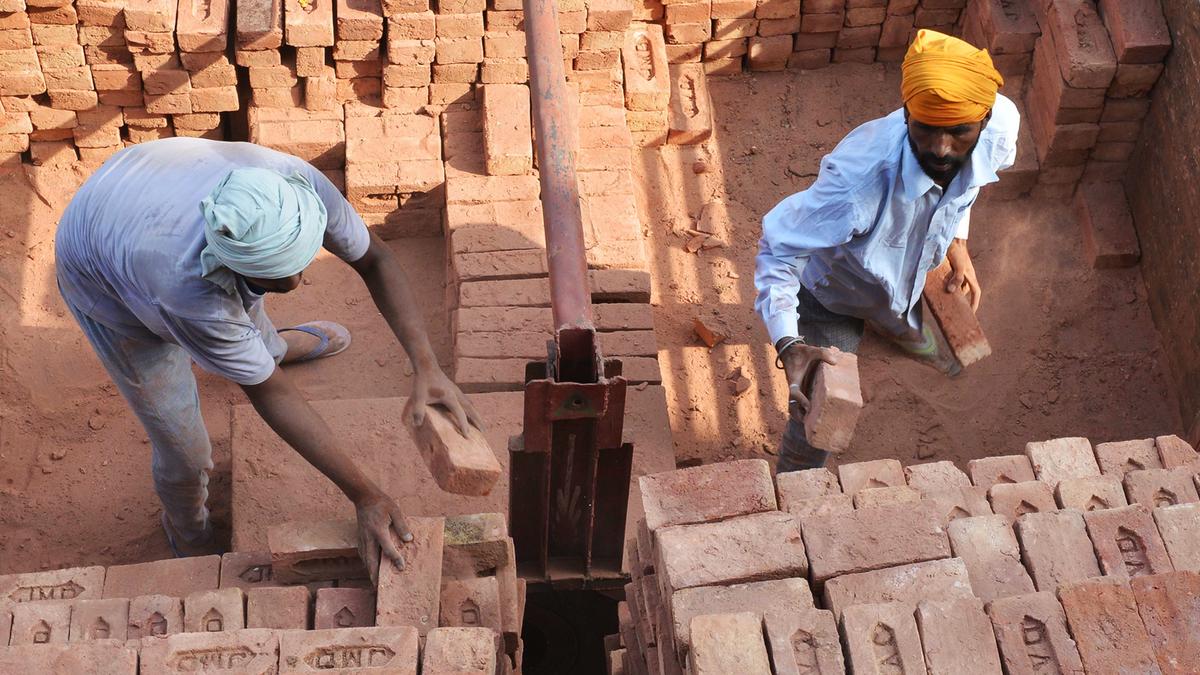
- 03 May 2025
Context:
Despite constitutional safeguards and decades-old abolition laws, bonded labour continues to haunt India’s informal economy. Marked by coercion, caste oppression, and systemic apathy, this form of modern slavery traps millions in exploitative work conditions under the guise of debt repayment or social obligation.
Ground Reality and Human Cost
The harrowing experiences of survivors like Mukesh Adivasi from Madhya Pradesh and K. Thenmozhi from Andhra Pradesh underscore the brutality of bonded labour. Lured by paltry advances (?500–?2,000), these individuals were trafficked across states, subjected to 14–16 hours of daily toil, and endured beatings, confinement, and psychological trauma. Their stories reflect the plight of an estimated 1.84 crore bonded labourers, as acknowledged by the Ministry of Labour and Employment (MoLE) in 2016.
However, between 2016 and 2021, only 12,760 individuals were officially rescued and rehabilitated — less than 1% of the total. Achieving the 2030 rehabilitation target would require rescuing over 11 lakh individuals annually, a goal far from the current trajectory.
Structural and Social Triggers
Bonded labour is not merely an economic issue but a complex interplay of poverty, caste discrimination, and weak governance. Immediate triggers include emergencies like illness, job loss, or dowries, pushing families to seek advances from exploitative employers. However, deeper systemic factors — such as caste-based exclusion (over 80% of bonded labourers belong to SC/ST/OBCs), illiteracy, and employer monopolies in rural credit and labour markets — perpetuate this cycle.
The Global Slavery Index lists India among the countries with the highest prevalence of modern slavery. Studies from states like Punjab reveal that 84% of bonded workers belong to backward castes, reinforcing the role of social stratification in this injustice.
Policy Gaps and Legal Shortcomings
Though bonded labour was abolished under the Bonded Labour System (Abolition) Act, 1976, enforcement remains weak. Many states deny its existence or fail to report cases, delaying rehabilitation. The Trafficking of Persons Bill, 2018, criticised for excluding bonded labour, further highlights legislative gaps.
Labour law reforms have exacerbated vulnerabilities. The Labour Codes (2019–2020) undermined unionisation and collective bargaining — vital tools once advocated by B.R. Ambedkar for worker empowerment.
Additionally, 90% of India’s workforce is in the informal sector (NSSO, 2023), lacking formal contracts, social security, or grievance redressal. This unregulated landscape fosters exploitation, especially among migrants fleeing climate distress and rural unemployment.
Way Forward
- Enforcement Reforms: Empower District Vigilance Committees with legal powers; digitise complaint tracking and link it with Aadhaar-based databases.
- Legal Overhaul: Amend labour codes to restore union rights and introduce caste-sensitive protections.
- Social Empowerment: Launch targeted rehabilitation schemes for SC/ST communities, offer skill training and land rights, and use vernacular media for rights education.
- Transparency and Data: Establish a national registry of rescued bonded labourers to monitor their reintegration and prevent re-trafficking.
Conclusion
Bonded labour in India represents a fundamental failure of justice, governance, and social equity. Real transformation requires a multi-pronged approach — strengthening laws, empowering vulnerable communities, and confronting the caste-class nexus of exploitation. Until then, India’s economic growth will remain morally compromised by the invisible chains of forced labour.
AI and Sustainability
- 02 May 2025
In News:
Artificial Intelligence (AI) is poised to transform India’s economy and governance landscape. A Google report estimates that AI adoption could add ?33.8 lakh crore to India’s economy by 2030, contributing 20% to GDP and supporting the USD 1 trillion digital economy target by 2028. However, this growth is accompanied by significant environmental costs, particularly from the energy-intensive AI infrastructure and data centres.
Environmental Costs of AI Expansion
Data centres—the backbone of AI—consume massive electricity, primarily from fossil fuels. In 2024, global data centres consumed 415 TWh, projected to reach 945 TWh by 2030, surpassing Japan’s electricity usage. A single AI query uses 10x the energy of a Google search. According to the IMF, AI expansion could raise electricity prices by up to 9% in the U.S.
In addition, training large AI models can consume up to 700,000 litres of water (equivalent to producing 320 Tesla cars). AI infrastructure may soon consume six times Denmark’s water needs. The mining of rare earths for AI hardware also contributes to deforestation and soil degradation, while increasing e-waste with hazardous components like lead and mercury.
Economic and Social Gains from AI
Despite these costs, AI offers transformative benefits. In agriculture, tools like Microsoft’s Project FarmVibes boost productivity by 40%, reduce water use by 50%, and lower fertilizer costs by 25%. In manufacturing, firms like Tata Steel employ AI for predictive maintenance and quality control under the ‘Make in India’ drive. Financial inclusion is advancing through AI platforms like OnFinanceAI, aiding the unbanked using mobile data. Public services are being enhanced via initiatives like Bhashini and AI-driven Digital Public Infrastructure.
AI also supports environmental monitoring. Tools like IBM’s Green Horizon track pollution, while Google’s GenCast improves extreme weather forecasting. AI-driven satellite imagery aids forest and ocean conservation, with initiatives like Fishial.AI monitoring marine biodiversity.
India’s Policy Response and Renewable Integration
Recognizing the challenges, India’s IndiaAI Mission and NITI Aayog’s AI strategy emphasize sustainable AI development. At the AI Action Summit in Paris, India reiterated the importance of aligning AI growth with renewable energy use. The country is exploring small modular reactors (SMRs) and promoting solar and wind to reduce the carbon footprint of data centres.
Currently, only 44.72% of India’s installed capacity is from non-fossil sources. Intermittent renewable supply, weak grid infrastructure, high upfront costs, and lack of integrated policies remain challenges.
Way Forward: Sustainable AI Growth
- Expand Renewable Energy: Scale solar and wind under National Solar Mission and Green Energy Corridors.
- Green Backup Power: Replace diesel generators in data centres with hydrogen fuel cells and batteries under the Green Hydrogen Mission.
- AI for Energy Optimization: Develop AI-powered smart grids and promote energy-efficient chips and cooling systems.
- Policy and Incentives: Establish unified AI–clean energy policy frameworks and incentivize 100% green data centres.
- Support Innovation: Fund pilot projects and promote green tech in over 1,000 AI and clean energy startups.
Conclusion
India’s journey to becoming a global AI powerhouse must be anchored in sustainability. Balancing technological ambitions with the 2070 net-zero goal is not just an environmental necessity but also a strategic imperative for resilient, inclusive growth.
India’s Coastal Crisis
- 31 Mar 2025
In News:
India’s vast coastline, stretching over 7,500 kilometres across nine states and four Union Territories, is a crucial ecological and economic asset. It supports diverse marine ecosystems, sustains the livelihoods of approximately 16 million fishers, and contributes around 4% to the national GDP through fisheries, tourism, and shipping activities. However, India’s coastal regions face a growing crisis from two interconnected challenges: rampant illegal light fishing and accelerating coastal erosion.
Illegal Light Fishing: Ecological and Socioeconomic Impacts
Light fishing, a method that employs high-powered artificial lights to attract fish and squid to the surface at night, is officially banned in India’s Exclusive Economic Zone (EEZ) since 2017. Despite this, enforcement remains weak and patchy, particularly within territorial waters of Maharashtra, Tamil Nadu, Andhra Pradesh, and Kerala. Mechanized boats equipped with powerful LED lights continue this practice, causing severe ecological disruption and threatening traditional fishing communities.
High-intensity lights lure not only adult fish but also juveniles and non-target species (bycatch), resulting in overfishing and depletion of juvenile stocks. This has been linked to coral reef degradation and altered marine food webs, especially impacting slow-moving species like squid, which are vital to the coastal ecosystem. Studies by institutions like the Central Marine Fisheries Research Institute have highlighted how light fishing disrupts spawning cycles and jeopardizes fish recruitment during critical periods.
Socially, light fishing disadvantages artisanal fishers who rely on traditional methods and smaller boats. The National Fishworkers Forum has documented declining catches and conflicts between small-scale fishers and mechanized operators. Moreover, the economic incentives for illegal light fishing are high, as single trips can yield profits exceeding ?1 lakh, whereas penalties, such as fines of ?16,000, are insufficient deterrents.
Coastal Erosion: Increasing Vulnerability and Habitat Loss
Alongside overfishing, India’s coastline is increasingly vulnerable to erosion, exacerbated by rising sea levels (currently about 3.2 mm per year), frequent cyclones, and human activities such as sand mining and unregulated coastal development. Recent government data indicates that 33.6% of India’s coastline is affected by erosion, with places like Dakshina Kannada in Karnataka losing nearly half of their shoreline over three decades.
Coastal ecosystems such as mangroves and coral reefs serve as natural buffers against wave action, reduce erosion, and play a critical role in carbon sequestration. For instance, the Bhitarkanika mangroves in Odisha absorb four times more carbon than terrestrial forests, helping mitigate climate change. However, urban expansion and infrastructure projects have led to significant mangrove loss—Mumbai has lost 40% since 1987—reducing the coastline’s resilience against natural disasters.
Pollution from plastic waste and industrial effluents further degrades marine habitats, while weak enforcement of Coastal Regulation Zone (CRZ) norms allows illegal constructions that exacerbate ecological damage.
Way Forward: Policy, Enforcement, and Community Engagement
Addressing India’s coastal crisis requires a multi-pronged approach:
- Strengthening Enforcement: There is an urgent need for uniform nationwide enforcement of the light fishing ban, enhanced patrolling using technologies like AI-enabled drones, and more stringent penalties to deter violations.
- Ecological Restoration: Initiatives such as artificial reefs, mangrove afforestation, and sand replenishment can restore natural coastal buffers. Programs like those in Puducherry and Odisha demonstrate the effectiveness of such measures.
- Community Participation: Empowering fisherfolk through capacity-building and involving local communities in surveillance and sustainable fishing practices is critical. Tamil Nadu’s fisher unions serve as a successful model of local stewardship.
- Climate Adaptation and Research: Relocating vulnerable settlements, investing in cyclone-resistant infrastructure, and expanding scientific research, such as satellite monitoring of erosion hotspots, are essential for long-term resilience.
Conclusion
India’s coastal regions are at a crossroads, balancing economic development, ecological sustainability, and social equity. Illegal light fishing and coastal erosion threaten marine biodiversity and the traditional livelihoods of millions. Effective governance, backed by technological innovation and community collaboration, is indispensable to safeguard India’s maritime heritage and ensure sustainable use of coastal resources in alignment with Sustainable Development Goal 14.
Universal and Equitable Tuberculosis Care in India
- 26 Mar 2025
In News:
India has made significant strides in tuberculosis (TB) care, exemplified by a 17.7% reduction in TB incidence from 237 to 195 per lakh population between 2015 and 2023. This progress reflects a comprehensive approach incorporating rapid molecular testing, new drug regimens, enhanced nutritional support, and community engagement. However, to achieve universal health coverage (UHC) and eliminate TB by 2025, as targeted by the National Tuberculosis Elimination Programme (NTEP), further integration and decentralization of services are crucial.
Key Developments in TB Care
India’s efforts to combat TB have included the roll-out of the BPaLM regimen (a combination of four drugs: Bedaquiline, Pretomanid, Linezolid, and Moxifloxacin), which shortens the treatment period for drug-resistant TB.
Additionally, the Ni-kshayPoshan Yojana (NPY), which provides nutritional support of ?1,000 per month to TB patients, addresses the need for holistic care. Community participation has also been enhanced through the inclusion of TB survivors as “TB champions,” promoting awareness and treatment adherence at the grassroots level.
Furthermore, TB care has been integrated into the Ayushman Bharat scheme, ensuring that TB services are available through the Pradhan Mantri Jan Arogya Yojana (PMJAY) and Ayushman Arogya Mandirs (AAMs), which offer comprehensive primary health care across India. These efforts aim to decentralize TB care, ensuring that treatment is accessible at the community level, reducing delays in diagnosis, and minimizing out-of-pocket expenses for patients.
Challenges to Achieving Equitable TB Care
Despite these advancements, challenges persist. Over 50% of TB patients seek treatment in the private sector, where standards are inconsistent, leading to delays and higher costs. The private sector’s underreporting further complicates the efforts to ensure complete coverage and comprehensive care. Additionally, barriers such as gender, caste, disability, and socio-economic status often affect TB diagnosis and treatment outcomes. These social determinants necessitate a targeted approach to ensure equitable access to care.
TB services in India have largely remained vertical, with distinct TB care pathways separate from general healthcare services. Integrating TB care into the broader public health system is critical for the country’s goal of achieving UHC. Another challenge is the lack of integrated care that combines TB treatment with screening for other diseases like chronic obstructive pulmonary disease (COPD), diabetes, and mental health conditions.
Recommendations
India must focus on five key strategies to enhance TB care and achieve UHC:
- Person-Centered Care: Model programs like Tamil Nadu’s KasanoiErappilaThittam, which identifies vulnerable populations and provides tailored care, should be scaled up nationwide.
- Intersectionality: Address the intersection of gender, caste, disability, and socio-economic status to ensure that marginalized groups are not left behind.
- Integrated Care: TB care should be integrated with the broader healthcare system, including screenings for non-communicable diseases (NCDs) and mental health issues, using tools like AI-enabled diagnostics.
- Financial Protection: Expanding social protection measures such as wage-loss schemes, livelihood support, and extended nutritional assistance will reduce financial barriers for TB patients.
- Awareness and Communication: A multi-platform public education campaign similar to the one used during the COVID-19 pandemic is essential to dispel myths, reduce stigma, and promote early detection and treatment.
Conclusion
India’s ambitious goal to eliminate TB by 2025, ahead of the global target, is a crucial step toward achieving UHC. By strengthening integrated, person-centered, and equitable care, addressing the social determinants of health, and promoting community-driven initiatives, India can lead the global fight against TB and set a benchmark for future health interventions.
India’s 5G Revolution

- 21 Mar 2025
Context:
India is undergoing a digital transformation powered by rapid expansion in mobile broadband. According to Nokia’s Mobile Broadband Index (MBiT) Report 2024, India’s average monthly data usage per user reached an all-time high of 27.5 GB. The exponential growth in 5G adoption, traffic, and device readiness reflects a critical shift in the country’s telecom and digital infrastructure landscape.
Key Trends in Data Consumption and 5G Expansion
The report highlights several key trends that underline India's accelerating digital momentum:
- Average Data Consumption: The average mobile user in India consumed 27.5 GB/month in 2024, underlining the growing demand for video streaming, social media, and real-time applications.
- Surge in 5G Traffic: 5G data traffic tripled over the past year, with projections indicating it will overtake 4G by Q1 2026. The shift is especially noticeable in urban areas.
- Metro-Centric 5G Usage: In India’s metro circles, 5G now accounts for 43% of total mobile broadband usage, up from 20% in 2023, suggesting early saturation and readiness in Tier 1 cities.
- Rural Uptake Rising: While metros lead the way, Category B and C circles are witnessing strong growth in 5G uptake, aided by affordable smartphones and increased network coverage.
- Device Readiness: There were 271 million active 5G devices in India in 2024, doubling year-on-year. By 2025, 90% of replaced smartphones are expected to be 5G-enabled, indicating widespread device transition.
- Fixed Wireless Access (FWA): Users with 5G FWA consume 12 times more data than typical mobile users, showing the potential of 5G in delivering high-speed home internet in underserved areas.
Implications for India’s Digital Future
- Economic Growth and Innovation: The 5G revolution is expected to unlock new avenues in fintech, ed-tech, health-tech, and smart manufacturing. Higher data speeds and lower latency will enhance productivity and efficiency across sectors.
- Bridging the Digital Divide: Increasing rural adoption of 5G, aided by government and private investments, can significantly reduce the urban-rural connectivity gap and foster inclusive development.
- Employment and Start-up Ecosystem: The emergence of a robust 5G ecosystem will create demand for new skills, boosting employment in AI, IoT, cloud computing, and edge technologies.
- Network Transformation: The transition from 4G to 5G marks a fundamental change in telecom infrastructure, requiring upgradation in backhaul capacity, spectrum efficiency, and fibre penetration.
Challenges and the Road Ahead
Despite rapid adoption, challenges remain. Ensuring affordable access in rural areas, addressing cybersecurity risks, and enhancing digital literacy are vital. Policy coherence, right-of-way (RoW) reforms, and spectrum management will determine the pace and inclusivity of 5G deployment.
Conclusion
India’s 5G journey marks a pivotal step toward becoming a digitally empowered society. With supportive policy frameworks, private sector innovation, and public investment in digital infrastructure, the country is well-positioned to leverage 5G as a tool for economic transformation, digital inclusion, and technological leadership.
Electoral Reforms in India
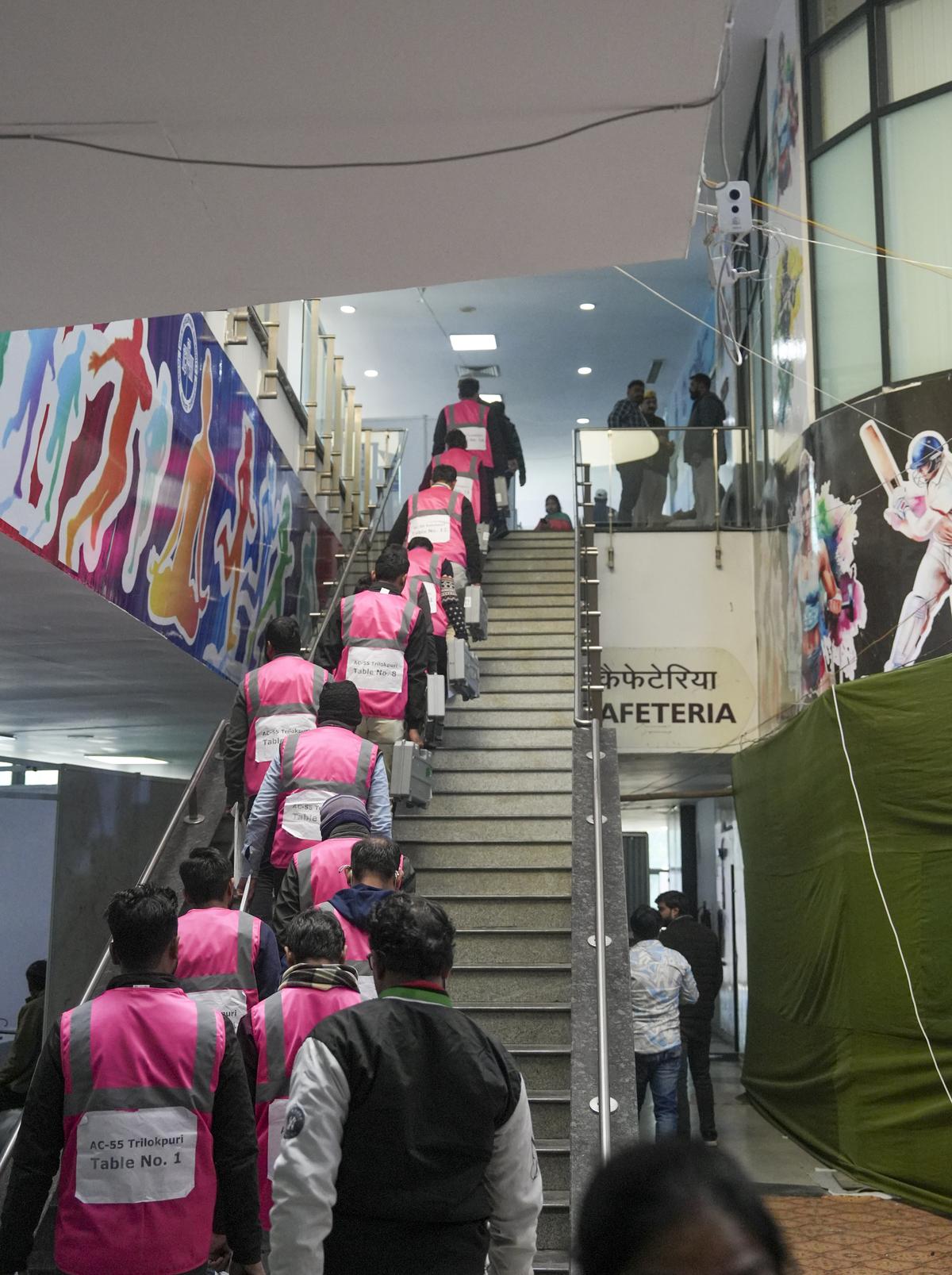
- 19 Mar 2025
In News:
The Election Commission of India (ECI) has initiated discussions with political parties to address growing concerns over the integrity of India’s electoral process. Allegations regarding the manipulation of electoral rolls, duplicate voter IDs, and issues with the conduct of elections have prompted the need for reforms to ensure transparency and fairness.
Legal Framework Governing Elections
The Constitution of India and several key legislative acts outline the processes and authority for conducting elections:
- Article 324 of the Constitution gives the Election Commission the authority to supervise electoral rolls and conduct elections.
- Representation of the People Act, 1950 and 1951 establish the legal framework for elections and the preparation of electoral rolls.
- Registration of Electors Rules, 1960 govern the procedures for the inclusion, correction, and deletion of names in the electoral rolls.
- Delimitation Act, 2002 ensures the redrawing of constituency boundaries based on the latest census data.
The evolution of voting methods in India has progressed from paper ballots to Electronic Voting Machines (EVMs) with Voter Verifiable Paper Audit Trail (VVPAT) since 2004, enhancing the credibility of the process.
Challenges in the Electoral Process
Several concerns have emerged over the years:
- EVM and VVPAT Concerns: Opposition parties have raised fears of EVM tampering, demanding a return to paper ballots. The Supreme Court has dismissed such demands, requiring a sample check of VVPAT-EVM matching in a limited number of machines per constituency.
- Electoral Roll Manipulation: Allegations of fake voters and duplicate voter IDs were raised, particularly in Maharashtra and Delhi. The EC has attributed these discrepancies to the earlier decentralized system of issuing voter IDs, which has now been streamlined through the ERONET platform.
- Campaign Issues: Star campaigners have often violated the Model Code of Conduct (MCC) by making inflammatory and divisive remarks. Moreover, political parties overspend on campaigns, exceeding legal limits, which undermines electoral integrity. The criminalization of politics is another critical issue, with 46% of elected MPs in 2024 facing criminal charges, including serious offenses.
Proposed Reforms
To address these challenges, several reforms are needed:
- Voting and Counting Reforms:
- VVPAT Verification: A scientific approach to VVPAT-EVM matching should be implemented. Full manual verification should be triggered if discrepancies are found in any region.
- Totaliser Machines: The EC’s proposal to use totaliser machines to aggregate votes from multiple EVMs before results are disclosed should be adopted to protect voter anonymity.
- Addressing Duplicate EPICs: Linking Aadhaar with EPIC IDs could help eliminate duplicate voter IDs, provided privacy concerns are addressed.
- Campaign and Electoral Reforms:
- Stronger Enforcement of the MCC: The EC should be empowered to revoke a party's “Star Campaigner” status for serious violations, depriving them of expenditure relief.
- Election Expenditure Regulation: The law should be amended to set limits on political party expenditure, which currently remains unrestricted.
- Criminalization of Politics: The Supreme Court’s directive for candidates to disclose their criminal records should be strictly enforced, requiring such declarations in widely circulated media.
Committee Recommendations
- Vohra Committee (1993): Recommended tracking criminal-politician links and addressing the role of black money in elections.
- Law Commission (2014): Suggested disqualifying politicians charged with serious offenses and increasing penalties for false affidavits.
- 2nd Administrative Reforms Commission: Advocated for state funding of elections to reduce the influence of illicit money.
Way Forward
To strengthen the electoral process, the Election Commission should be granted greater powers to verify criminal records and financial disclosures of candidates. Fast-track courts should be established to expedite cases involving elected officials facing serious charges. Transparency should be increased by mandating real-time disclosure of political funding and expenditures. Furthermore, voter awareness and civil society engagement should be promoted to enhance accountability in the electoral process.
Public Health Education in India

- 18 Mar 2025
In News:
India’s public health education sector stands at a critical juncture. Despite rapid academic expansion—with over 100 institutions now offering Master of Public Health (MPH) and related programs—the sector faces mounting challenges related to employment, quality, and funding. While international aid has declined, domestic investment remains limited, exacerbating systemic issues in workforce development.
Public Health: Constitutional and Strategic Significance
Article 47 of the Indian Constitution mandates the State to improve public health. A well-trained public health workforce is essential to achieve health equity, manage non-communicable diseases, address pandemics like COVID-19, and ensure effective delivery of health services at all levels.
Evolution and Growth of Public Health Education
Public health education in India has roots in colonial institutions, notably the All India Institute of Hygiene and Public Health, Kolkata (1932). Post-independence, community medicine was integrated into medical curricula. However, it was the launch of the National Rural Health Mission (2005) that marked a turning point, creating space for non-medical professionals in public health. Since then, MPH programs have proliferated—from just one institution in 2000 to over 100 today.
Government Initiatives
Key government efforts to strengthen public health education and training include:
- National Health Mission (NHM): Enhances public health systems and skill development.
- PM Swasthya Suraksha Yojana (PMSSY): Expands infrastructure and education through AIIMS-like institutions.
- Fellowship in Public Health Management (FPHM): Builds leadership capacities.
- National Programme for Prevention and Control of Non-Communicable Diseases (NP-NCD) and Integrated Disease Surveillance Programme (IDSP): Promote epidemiology and disease control training.
Persistent Challenges
- Employment Mismatch: A surge in MPH graduates has not been matched by job creation. Entry-level roles receive thousands of applications, and dedicated public health cadres in states remain underdeveloped.
- Lack of Regulation and Standardization: No central regulatory body ensures consistent curricula or quality standards. MPH programs are not under the purview of the NMC or UGC.
- Faculty Shortages and Weak Practical Training: Institutions often lack experienced faculty and real-world training integration, leaving graduates underprepared.
- Uneven Institutional Spread: States like Assam, Bihar, and Jharkhand have few or no public health colleges, deepening regional disparities.
- Funding Deficits: India's public health education receives minimal investment. For instance, the Data Protection Board was allocated just ?2 crore—reflecting systemic underfunding. International aid cuts, such as those from USAID, further strain the sector.
- Low Private Sector Absorption: Private hospitals prefer management professionals over MPH graduates. Development sector roles, heavily reliant on foreign grants, offer limited stability.
Way Forward
- Establish Public Health Cadres: States must create dedicated employment frameworks at all administrative levels.
- Regulate Education Quality: A Public Health Education Council under UGC/NMC should standardize curricula, faculty norms, and institutional benchmarks.
- Expand Institutional Capacity: Encourage public-private partnerships to open MPH colleges in underserved regions.
- Promote Experiential Learning: Mandate field training through internships in NHM, IDSP, and WHO-linked programs.
- Encourage Private Sector Hiring: Offer incentives for hiring MPH graduates in corporate and hospital settings.
- Increase Domestic Investment: Boost government funding for public health education and research, reducing reliance on foreign donors.
Conclusion
India’s public health education must transition from fragmented expansion to structured, quality-driven growth. Strengthening regulation, employment pathways, and training infrastructure is crucial for building a resilient health system and fulfilling the constitutional promise of health for all.
NBFC Stress and Systemic Risks in India’s Financial System

- 14 Mar 2025
In News:
The International Monetary Fund (IMF), in its report titled India Financial System Stability Assessment, has flagged significant vulnerabilities in India’s financial architecture, particularly arising from the Non-Banking Financial Companies (NBFCs) sector. Despite overall resilience post-pandemic, the increasing interconnectedness and exposure of NBFCs pose emerging systemic risks.
A major concern highlighted is the concentration of NBFC lending to the power sector. In FY 2024, 63% of power sector loans were provided by just three large Infrastructure Financing NBFCs—an increase from 55% in FY 2020. This overexposure, particularly by state-owned NBFCs such as IREDA, raises red flags given the inherent risks in infrastructure financing, including delays, cost overruns, and revenue shortfalls. The report notes that 56% of NBFC lending was financed by market instruments like corporate bonds and mutual funds, heightening the risk of contagion in case of financial distress.
NBFCs differ structurally from banks. They cannot accept demand deposits, lack deposit insurance coverage, and have no direct access to Reserve Bank of India (RBI) liquidity windows. Consequently, any shock in their repayment capacity can lead to asset-liability mismatches, potentially spilling over into banks, mutual funds, and bond markets, amplifying systemic risks.
The IMF also examined stress scenarios such as stagflation—a situation characterized by slow economic growth and high inflation. In such cases, public sector banks (PSBs) are particularly vulnerable. The Capital Adequacy Ratio (CAR) of PSBs could fall to the regulatory minimum of 9% under stress, threatening their ability to absorb losses. This is concerning, as the RBI mandates a minimum CAR of 12% for PSBs. The IMF recommends that PSBs retain earnings instead of paying dividends to strengthen their capital buffers and support credit flow during downturns.
While banks and NBFCs have shown broad resilience, ‘weak tails’ exist—non-systemic NBFCs and urban cooperative banks with below-minimum or even negative capital. This underscores the need for strengthened regulatory oversight, especially over state-owned NBFCs, which currently enjoy relaxed prudential norms. The IMF calls for uniform regulation across public and private NBFCs to ensure a level playing field and greater financial stability.
The report also emphasizes the need for improved data sharing and systemic risk monitoring, especially related to NBFC exposures, household credit, and climate-linked financial risks. Physical and transition risks remain moderate but are notable in monsoon-dependent agriculture and carbon-intensive industries like thermal power.
Recommendations include:
- Extending the cybersecurity risk framework to major NBFCs.
- Implementing IFRS-9 based credit risk assessments and countercyclical capital buffers.
- Improving insolvency and bankruptcy resolution mechanisms to reduce recovery time and enhance credit discipline.
India’s financial system is becoming more diverse and inclusive, with rising digital financial access and market participation. However, to sustain growth and resilience, proactive reforms in NBFC regulation, capital adequacy, and systemic risk management are essential.
Is Artificial Intelligence affecting Critical Thinking Skills?
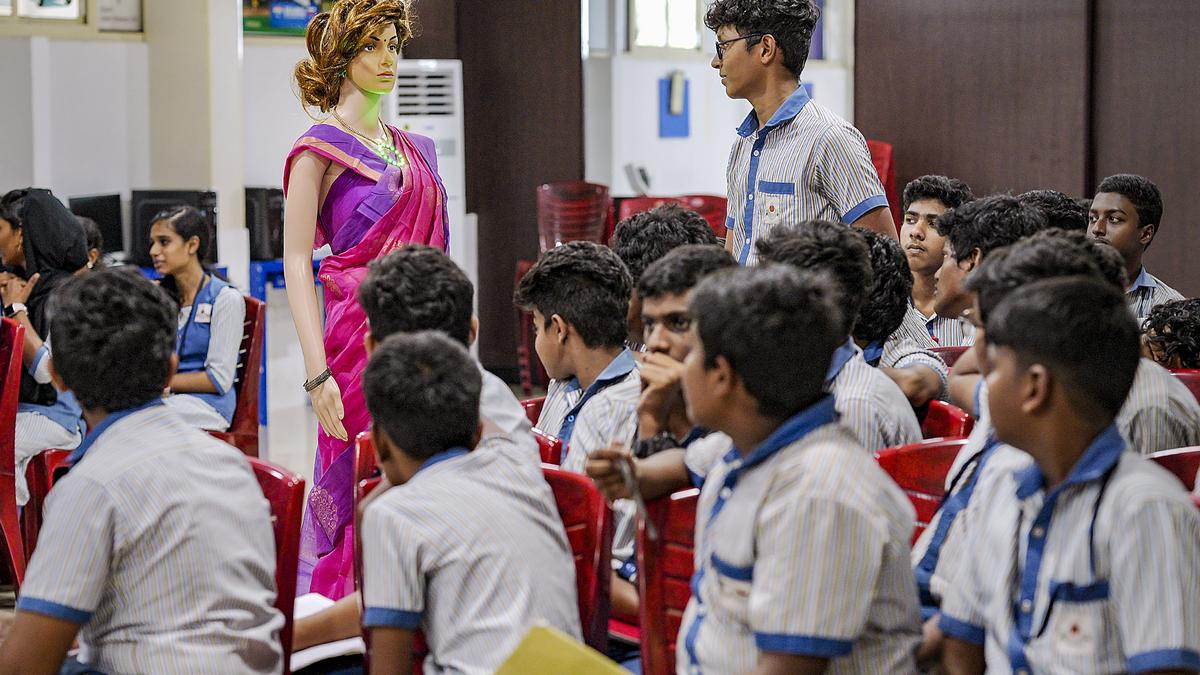
- 13 Mar 2025
Context:
The growing integration of Artificial Intelligence (AI) in educational spaces has sparked a global debate on its impact on students' critical thinking. With AI tools like ChatGPT and Copilot becoming ubiquitous, concerns have emerged about their potential to replace the intellectual rigor traditionally expected of learners.
AI in Classrooms: An Inevitable Shift
AI is no longer a futuristic concept but an entrenched part of everyday life, including education. In India, over 61% of educators reportedly use AI tools, and globally, a majority of students now rely on generative AI for academic work. This shift raises the fundamental question: Is AI eroding students’ ability to think independently?
Experts argue that banning AI from classrooms is neither feasible nor productive. AI’s integration into platforms like Microsoft Word and Adobe Reader means its use is often passive and unavoidable. Instead, the focus should be on responsible and ethical integration aligned with course objectives.
Impact on Critical Thinking
While some educators worry that AI might lead to intellectual passivity, others assert that it depends on the pedagogy. Courses aiming to cultivate analytical thinking—like humanities—should limit AI use, whereas technical subjects such as coding might benefit from it. The evolving skillset now values the ability to validate and critique AI-generated outputs over traditional rote learning.
Yet, over-dependence is a valid concern. Students may begin accepting AI responses without questioning their validity. To address this, a shift in educational design is necessary—moving from information recall to critical engagement with AI-generated content.
AI as Infrastructure in Education
AI is increasingly being seen as critical infrastructure in academic institutions. Reports like the World Economic Forum’s Future of Jobs Report (2025) emphasize the importance of analytical thinking, adaptability, and AI-related competencies. However, there is a need for robust digital literacy training to inform users about the risks—especially data privacy and algorithmic biases.
The adoption of AI in schools and universities must be accompanied by risk audits, including assessments of embedded biases, training data integrity, and transparency in design.
Need for Regulation and Institutional Policies
India currently lacks a comprehensive regulatory framework for AI in education. In the interim, individual institutions must step in to develop internal policies guiding ethical AI use. This includes declaring course-specific AI policies and fostering dialogues among students and faculty. Global universities offer useful templates, with general guidelines complemented by course-specific rules.
Conclusion: Regulate, Don't Resist
AI’s presence in education is irreversible. Rather than resisting its use, educational institutions must adapt by promoting informed, critical engagement with AI. While AI can assist in learning, it should not substitute the cognitive processes that education aims to cultivate. The future lies in developing a balanced model, where AI complements human intelligence rather than undermining it.
Centring Care in India’s Economic Policy
- 06 Mar 2025
In News:
The Union Budget 2025 has seen a significant increase in the allocation for gender-responsive fiscal policies, with a record ?4,49,028.68 crore allocated to the Gender Budget (GB). This represents a 37.3% increase from the previous year, marking 8.86% of the total Budget. However, this increase is largely attributed to the inclusion of PM Garib Kalyan Anna Yojana, which constitutes 24% of the GB, rather than substantial investments in care infrastructure or gender-responsive schemes. This highlights the persistent underestimation of unpaid care and domestic work (UCDW) in India’s economic planning.
The Care Work Crisis: An Overlooked Economic Reality
Globally, women bear the brunt of unpaid care work (UCDW), spending an average of 17.8% of their time on such tasks. In India, this burden is particularly severe. Indian women spend 40% more time on UCDW compared to women in South Africa and China. As per the International LabourOrganisation (ILO), 53% of Indian women remain outside the labour force due to caregiving responsibilities, while only 1.1% of men face similar barriers. This deep-rooted gender inequality reinforces women’s economic disempowerment.
For marginalized women in low-income households, the burden is exacerbated. Many women juggle 17–19 hours of daily labour, balancing paid work with domestic duties, resulting in severe time poverty and poor health. Feminist economists from the Global South emphasize that in India, unpaid work extends beyond household care to include tasks such as family farming, water collection, and fuel gathering. Women often spend up to 73% of their time on these tasks due to limited infrastructure in basic services such as water, sanitation, and clean energy.
Missed Opportunities in the 2025 Budget
Despite the record increase in the Gender Budget, the 2025 Union Budgetmisses critical opportunities to address the care work crisis. The Economic Survey 2023-24 recognized care infrastructure as pivotal for women’s empowerment, yet the budget failed to translate this into significant fiscal commitments. The Jal Jeevan Mission (JJM), which aims to provide 100% potable water coverage by 2028, is a positive step but suffers from funding delays and implementation gaps. While the JJM budget increased by 195% over Revised Estimates, it saw a decline of 4.51% from last year’s Budget Estimates, underscoring allocation and spending mismatches.
Policy Recommendations: The Three R Framework
To address these systemic issues, the Economic Survey 2023-24 suggests that public investment of 2% of GDP in care infrastructure could generate 11 million jobs and reduce the care burden on women. The Three R framework — Recognise, Reduce, Redistribute, and Represent — provides a holistic approach to creating a more inclusive economy:
- Recognise: The first step is acknowledging the full extent of UCDW. India’s 2019 Time Use Survey revealed that women spend an average of seven hours daily on unpaid care tasks. Regular surveys, integrated into existing household surveys, can inform more effective policy-making.
- Reduce: The second step involves reducing the care burden by investing in time-saving technologies and affordable care infrastructure. Expanding childcare centres, eldercare support, and assistive technologies can facilitate women’s workforce participation. The Urban Challenge Fund announced in the 2025 Budget, with ?10,000 crore allocated for FY 2025-26, can finance urban redevelopment projects that integrate care infrastructure, inspired by successful models like Bogotá’s Care Blocks.
- Redistribute: Care responsibilities must be shifted from the household to the State and society. The Smart Cities Mission and the Urban Challenge Fund present opportunities to scale up care infrastructure in urban areas. This redistribution of care work can significantly ease the burden on women and encourage more equitable labor force participation.
- Represent: Women’s representation in decision-making is crucial for creating gender-transformative policies. Policies designed with women’s input are shown to be six to seven times more effective in achieving gender-equitable outcomes. Therefore, promoting female leadership in governance is essential for the success of gender-responsive policies.
Conclusion:
The Union Budget 2025 has made strides in gender-responsive fiscal policies but falls short in addressing the care economy. India has a significant opportunity to set a global example by recognizing unpaid care work, investing in care infrastructure, and redistributing caregiving responsibilities. A gender-sensitive economy, with women’s participation in decision-making, will not only uplift women but also ensure more inclusive growth for the country. The current budget highlights the need for a more deliberate, well-funded strategy to treat care work as a central pillar of India’s economic development.
Environmental Impacts of Artificial Intelligence

- 28 Feb 2025
Introduction
Artificial Intelligence (AI), encompassing technologies that simulate human thinking and decision-making, has become integral to contemporary life, influencing how we work, live, and conduct business. While AI’s foundational concepts date back to the 1950s, recent advances in computing power and data availability have fueled rapid growth. The global AI market, currently valued at $200 billion, is projected to contribute up to $15.7 trillion to the world economy by 2030. Major developments, such as the U.S.’s $500 billion Stargate Project and India's plans to build the world’s largest data centre in Jamnagar with Nvidia, highlight AI’s economic potential. However, this transformative technology also poses significant environmental challenges across its value chain.
Environmental Impact Across the AI Value Chain
The environmental footprint of AI emerges at multiple stages — from hardware production and model development to deployment and maintenance:
- Energy Consumption and Carbon Emissions:Data centres, the backbone of AI infrastructure, consume vast amounts of electricity, accounting for approximately 1% of global greenhouse gas emissions, a figure expected to double by 2026 (IEA). Advanced models like GPT-3 emit up to 552 tonnes of carbon dioxide equivalent during training, comparable to the annual emissions of dozens of cars. A single ChatGPT request consumes roughly ten times the energy of a standard Google search.
- E-Waste Generation and Resource Depletion:The rapid expansion of AI data centres exacerbates the e-waste crisis, with obsolete hardware often discarded irresponsibly. Manufacturing essential components like microchips demands rare earth minerals, mined through environmentally destructive processes.
- Water Usage:Data centres require millions of litres of water for cooling operations. Alarmingly, AI-related data centres are projected to consume six times more water than Denmark’s total usage, straining water resources, especially in regions already facing scarcity.
Global Awareness and Regulatory Efforts
Recognising the growing environmental burden, international organisations and governments have initiated efforts toward greener AI practices:
- At COP29, the International Telecommunication Union (ITU) underscored the urgent need for sustainable AI development.
- Regions like the European Union and the United States have introduced laws to mitigate AI’s environmental impact.
- However, despite over 190 countries adopting non-binding ethical AI guidelines, sustainability concerns remain largely absent from most national AI strategies.
Way Forward
To harmonise AI innovation with environmental responsibility, a multi-pronged approach is necessary:
- Clean Energy Adoption:Shifting to renewable energy sources for powering data centres and purchasing carbon credits are critical steps. Locating centres in regions rich in renewables can further lower carbon footprints.
- Efficiency in Hardware and Algorithms:Developing energy-efficient hardware and maintaining it regularly can substantially reduce emissions. Smaller, domain-specific models should be promoted to lessen computational demands.
- Optimisation of AI Systems:Studies by Google and the University of California, Berkeley, suggest that through optimised algorithms, specialised hardware, and efficient cloud data centres, the carbon footprint of large language models (LLMs) can be reduced by a factor of 100 to 1,000.
- Reusing Pre-trained Models:Businesses should prioritise fine-tuning existing models for new tasks over training fresh models from scratch, significantly saving energy.
- Measurement, Disclosure, and Accountability:Establishing global standards for tracking, measuring, and publicly disclosing the environmental impacts of AI systems is essential for fostering transparency and industry-wide accountability.
- Leveraging AI for Sustainability:AI itself can aid sustainability efforts, such as through projects like Google's DeepMind, which improves wind power forecasting, enabling better integration of renewable energy sources into national grids.
Conclusion
While AI holds immense promise for economic growth and societal advancement, it simultaneously presents critical environmental challenges. Integrating sustainability into the very design of the AI ecosystem is imperative. By embedding environmental responsibility at every stage—from model development to deployment—governments, businesses, and researchers can ensure that AI’s transformative potential is realised without compromising the planet’s future.
India–Sri Lanka Fishing Dispute
- 24 Feb 2025
Context:
The recurring arrests of Indian fishermen by the Sri Lankan Navy in the Palk Bay region underscore a complex and unresolved bilateral issue, rooted in historical practices, ecological concerns, and geopolitical sensitivities. The most recent incidents in early 2025 have intensified the diplomatic and political discourse between the two neighbours.
Background and Origin of the Dispute
The core of the India–Sri Lanka fishing dispute lies in the contested fishing rights in the Palk Bay, a narrow strip of sea separating Tamil Nadu from northern Sri Lanka. The 1974 and 1976 maritime boundary agreements, particularly the ceding of Katchatheevu Island to Sri Lanka, formalized the International Maritime Boundary Line (IMBL). While Indian fishermen were permitted traditional access to the island for specific purposes, the agreements curtailed their fishing activities across the newly delineated boundary.
However, Tamil Nadu fishermen have historically fished in these waters, and the IMBL has not fully erased traditional patterns. The situation is worsened by ecological pressures on Indian fishing grounds, pushing fishermen into Sri Lankan waters.
Key Issues Involved
- Violation of IMBL and Traditional Rights:Indian fishermen often assert customary fishing rights across the IMBL, which clashes with Sri Lanka’s assertion of sovereignty over its territorial waters. Many crossings occur unintentionally due to poor navigation, engine failures, or inclement weather.
- Bottom Trawling and Environmental Concerns:The use of bottom trawlers by Indian fishermen is a major point of contention. This method, which scrapes the seabed, damages marine ecosystems and depletes resources, affecting both nations' long-term fisheries sustainability. Sri Lanka has banned bottom trawling and views it as ecological exploitation and illegal fishing.
- Security and Sovereignty Sensitivities:Sri Lanka perceives these incursions not only as violations of maritime boundaries but also as potential national security threats, recalling past concerns over Tamil militant movements operating from the sea.
- Recurrent Arrests and Humanitarian Concerns:The frequent arrests, imprisonment, and imposition of heavy fines on Indian fishermen have humanitarian and political implications. Often, fishing boats are not returned even after the release of the crew, causing further livelihood losses.
Efforts at Resolution
- Diplomatic Engagement:The issue has prompted high-level political intervention, with the Tamil Nadu government urging the Union Government for effective measures and the convening of a Joint Working Group (JWG) to address the issue diplomatically.
- Livelihood-Based Approaches:Both countries have discussed alternatives to resolve the crisis humanely, including exploring sustainable fishing practices, alternate employment, and deep-sea fishing training.
- Technological Interventions:Use of GPS-based tracking systems and awareness programs aim to prevent inadvertent border crossings and encourage responsible fishing.
- People-to-People Dialogues:Calls for direct interaction between fishermen communities from both nations have been made, suggesting that grassroots engagement may ease tensions and promote mutual understanding.
International Legal Framework
- UNCLOS (1982):Provides legal clarity on maritime boundaries and responsibilities, but emphasizes mutual respect for sovereign rights and sustainable resource use.
- UN Fish Stocks Agreement (1995):Encourages cooperation in conserving transboundary fish stocks, suggesting the role of Regional Fisheries Management Organizations (RFMOs) in managing shared marine resources.
Conclusion
The India–Sri Lanka fishing dispute in the Palk Bay is not merely a bilateral maritime boundary issue; it is a convergence of historical rights, ecological degradation, livelihood dependence, and strategic concerns. While both countries have taken steps towards conflict management, a long-term solution lies in cooperative marine resource governance, joint monitoring, and community-centric diplomacy. Resolving this issue through dialogue, sustainable practices, and mutual sensitivity is essential to safeguard both bilateral relations and the rights and livelihoods of coastal communities.
India's Horticulture Sector

- 19 Feb 2025
In News:
India’s horticulture sector is crucial to its agricultural economy, encompassing the cultivation, production, processing, and marketing of fruits, vegetables, and ornamental plants. The sector includes sub-sectors like pomology (fruit cultivation), olericulture (vegetable cultivation), floriculture (flower cultivation), and arboriculture (cultivation of trees). India stands as the second-largest producer of fruits and vegetables globally, trailing only China.
In 2023-24, India’s horticultural production was estimated at 355 million tonnes, surpassing food grain production. The sector contributes 33% to the agricultural Gross Value Added (GVA), growing at an annual rate of 4-5%, outpacing cereal production.
Despite its size and importance, India’s horticulture sector faces several challenges. Post-harvest losses are significant, with about 8.1% for fruits and 7.3% for vegetables, translating into a loss of ?1.53 trillion annually. These losses are primarily due to inadequate cold storage and processing infrastructure, as well as fragmented value chains, where middlemen dominate, resulting in low farmer incomes. Farmers typically receive only 30% of the final consumer price for their produce.
Challenges in India’s Horticulture Sector
- Infrastructure Deficit: The absence of efficient logistics, cold storage, and warehousing facilities contributes to delays and wastage of perishable horticultural crops. The cold storage capacity is concentrated in just a few states, limiting access for farmers across the country.
- Small Operational Landholdings: Many farmers operate on small plots, limiting their ability to adopt sustainable practices and crop rotation, leading to reduced yields and soil degradation.
- Limited Value Addition: Only 10% of India’s fruits and vegetables are processed, compared to 60-70% in developed countries, leading to distress sales and low earnings for farmers.
- Market Linkages and Export Challenges: Indian farmers have limited access to direct markets, and the country’s export share in horticultural produce is low. Non-tariff barriers such as Sanitary and Phytosanitary (SPS) standards also hinder India's export growth.
Government Initiatives for Horticulture
Several initiatives have been launched to address these challenges:
- Mission for Integrated Development of Horticulture (2014) aims to foster holistic growth through cluster approaches and better linkages.
- Operation Greens, initially focused on specific crops like tomatoes, onions, and potatoes, has been extended to all horticultural crops to address price volatility.
- The Farmer Producer Organisation (FPO) model is being promoted to help farmers collectively bargain for better prices. As of August 2024, 8,875 FPOs have been established with a target of 10,000 by 2027.
- The Agriculture Infrastructure Fund (AIF) provides financial support for cold chains, warehouses, and processing units.
Case Study: Sahyadri FPO
A notable example of FPO success is the Sahyadri Farmer Producer Company Ltd (SFPCL) in Maharashtra, which started with 10 farmers in 2004 and has grown to include 26,500 farmers across 252 villages. With an annual turnover of ?1,549 crore (2023-24), SFPCL has become the largest grape exporter, with 90% of exports going to the EU and UAE. Farmers involved in the FPO receive 55% of the final export price, significantly higher than the typical 30% in traditional markets. This model demonstrates the potential of cooperative farming in enhancing farmers' incomes.
Way Forward: Scaling Up the Amul Model
To replicate the success of AMUL in the dairy sector, India’s horticulture sector must focus on:
- Strengthening FPOs: Support should be provided for working capital, infrastructure, and digital integration. Leveraging platforms like the Open Network for Digital Commerce (ONDC) can enhance market access for FPOs.
- Expanding Processing and Storage Infrastructure: Financial allocation for cold storage, processing facilities, and logistics must be increased under schemes like Operation Greens.
- Public-Private Partnerships (PPP): Encourage collaborations between the government and private sectors to enhance food processing, distribution, and retail linkages.
- Technology Integration: Adoption of technologies like blockchain for traceability and AI-driven price prediction models can improve market transparency and reduce distress sales.
By expanding successful models like Sahyadri FPO, India can transform its horticulture sector, enhance farmer incomes, ensure food security, and increase agri-export earnings. This approach could play a pivotal role in rural development and poverty alleviation, benefiting both farmers and consumers.
USAID Freeze and Its Global Implications
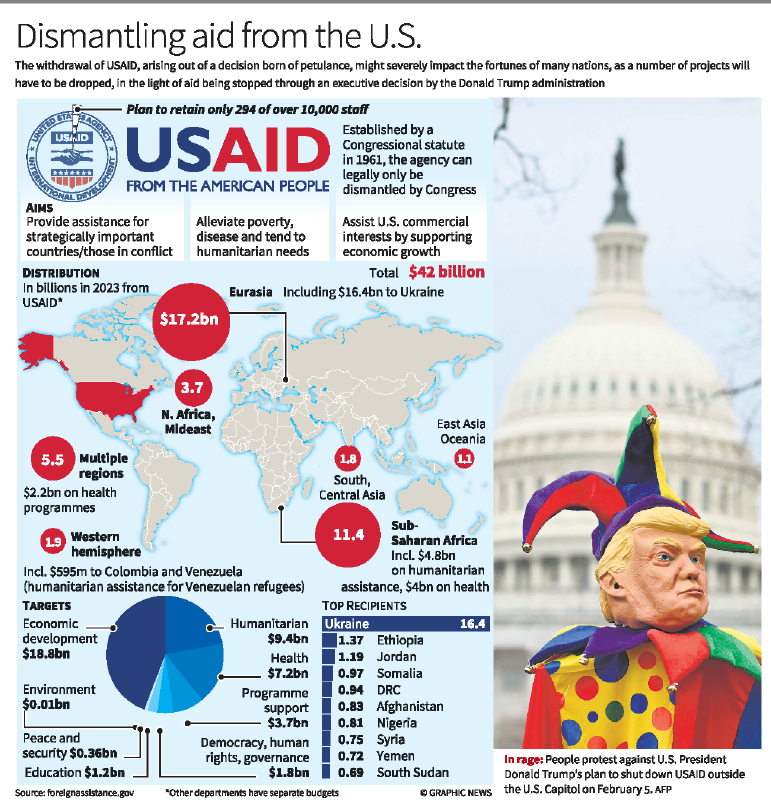
- 17 Feb 2025
Context:
On January 20, U.S. President Donald Trump, upon beginning his second term, issued an executive order imposing a 90-day freeze on foreign assistance. The directive aimed to reassess the efficiency and alignment of U.S. foreign development programs with its foreign policy priorities. This decision led to an immediate halt in operations of the United States Agency for International Development (USAID), with the majority of its 10,000 personnel placed on administrative leave and project funding suspended worldwide.
What is USAID?
- Established in 1961 under President John F. Kennedy through an Act of Congress, the United States Agency for International Development (USAID) functions as an independent agency responsible for administering civilian foreign aid and development assistance.
- Its core mission is to promote democratic values, global peace, and prosperity while advancing American national security and economic interests.
- USAID operates in over 100 countries, partnering with governments, NGOs, private firms, and international organizations.
- It offers financial support, technical assistance, and capacity-building across key sectors such as health, education, food security, economic development, humanitarian relief, environmental sustainability, and governance.
- Prominent initiatives include:
- PEPFAR: A flagship HIV/AIDS prevention and treatment program.
- Feed the Future: Focused on combating hunger and improving food security.
- Power Africa: Aimed at expanding electricity access across Africa.
- Water for the World Act: Enhancing water, sanitation, and hygiene infrastructure.
- In 2024, USAID disbursed $44.2 billion globally, which accounted for approximately 0.4% of the U.S. federal budget. Notably, the agency contributed to around 42% of all humanitarian aid tracked by the United Nations that year.
Rationale and Political Overtones
The Trump administration justified the freeze as a review for improving programmatic efficiency and ensuring alignment with U.S. strategic interests. However, critics argue the move is politically motivated, targeting Biden-era programs. Elon Musk, heading the Department of Government Efficiency (DOGE), labeled USAID a "criminal organization," while Secretary of State Marco Rubio indicated a broader plan for restructuring.
Global Impact of the Freeze
The abrupt suspension of USAID operations threatens development and humanitarian efforts across numerous vulnerable regions. Top recipients like Ukraine, Ethiopia, Somalia, Syria, and Yemen face the sudden withdrawal of critical support in health, food security, disaster relief, and infrastructure.
The United Nations has warned that halting support for HIV/AIDS programs alone could result in over six million deaths within four years. In several African and Middle Eastern nations, the absence of aid could derail long-term projects aimed at poverty alleviation, maternal and child health, vaccination drives, and crisis response mechanisms.
Moreover, the withdrawal risks diminishing the U.S.’s diplomatic influence in the Global South, potentially creating a vacuum for geopolitical competitors such as China, which may expand its presence through initiatives like the Belt and Road Initiative (BRI).
Impact on India
USAID's involvement in India dates back to 1951, when President Truman signed the India Emergency Food Aid Act. Over the decades, it evolved from providing food aid to supporting economic reforms, infrastructure, and public health initiatives. However, India’s dependency on USAID has significantly declined in recent years.
In 2024, USAID allocated approximately $79.3 million to India, primarily focused on healthcare, including HIV/AIDS, tuberculosis, maternal and child health, and immunization programs. This constituted only about 0.2% to 0.4% of USAID’s global disbursement.
While the immediate impact on India may be limited due to reduced reliance and growing self-sufficiency, some ongoing health and sanitation projects could face temporary disruptions. The Indian government and implementing agencies have been directed to suspend USAID-funded operations, raising concerns about the continuity of services for vulnerable populations.
Conclusion and the Way Forward
The freeze on USAID funding reflects a shift in U.S. foreign aid philosophy and signals potential isolationist tendencies. While India may be resilient, many developing nations in Africa, the Middle East, and Asia could witness significant humanitarian and developmental setbacks.
To mitigate the impact, affected countries must:
- Enhance domestic resource mobilization to sustain critical development programs.
- Deepen partnerships with multilateral institutions like the UN, World Bank, and WHO.
- Encourage private sector participation through Corporate Social Responsibility (CSR) initiatives.
- Foster South-South cooperation to promote shared growth models.
The episode underscores the urgent need for the Global South to diversify funding sources and build internal capacities to safeguard developmental progress from geopolitical uncertainties.
Rapid Glacial Retreat in Arunachal Pradesh
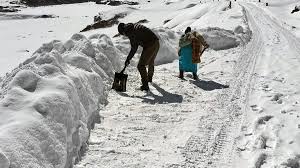
- 05 Feb 2025
In News:
A recent scientific study has revealed that the eastern Himalayas in Arunachal Pradesh have lost 110 glaciers between 1988 and 2020, highlighting a critical impact of climate change in the region.
Key Findings of the Study
- Glacier Loss: The number of glaciers declined from 756 to 646 over 32 years.
- Glacial Area Reduction: Total glacial cover reduced from 585.23 sq. km to 309.85 sq. km, indicating a loss of over 47%.
- Retreat Rate: Glaciers retreated at a rate of 16.94 sq. km per year.
- Elevation: Most glaciers were located at 4,500–4,800 metres above mean sea level on north-facing slopes of 15°–35°.
- Remote Sensing & GIS: The study used advanced tools along with the Randolph Glacier Inventory to track and analyze glacier boundaries.
- Glacial Lakes: Retreat has led to the formation of numerous glacial lakes, increasing the risk of Glacial Lake Outburst Floods (GLOFs), as seen during the 2023 Sikkim disaster which killed at least 55 people and damaged a 1,200 MW Teesta hydropower project.
Causes of Glacial Retreat
- Climate Change:
- The eastern Himalayas are warming faster than the global average.
- Temperature rise: Between 0.1°C and 0.8°C per decade.
- Over the last century, the region has experienced an increase of ~1.6°C.
- By 2100, projections indicate a 5–6°C temperature rise and 20–30% increase in precipitation.
- Black Carbon Deposition: Emissions from human activities (e.g., vehicles, biomass burning) deposit soot on ice, reducing reflectivity (albedo) and increasing heat absorption.
- Erratic Snowfall Patterns: Changes in precipitation reduce snow accumulation, weakening glacier sustenance.
- Geological Factors: Local topography, altitude, and rock composition also influence glacier stability and response to warming.
Implications of Glacial Retreat
- Water Security
- The Himalayas are known as the ‘Third Pole’, storing the largest volume of ice outside the polar regions.
- They are vital for sustaining over 1.3 billion people in South Asia by feeding major rivers (Indus, Ganga, Brahmaputra).
- Glacial retreat threatens long-term freshwater availability, agriculture, and urban water supplies.
- Hydropower and Infrastructure
- Changing river flow patterns due to glacial melt affect hydropower generation and irrigation systems.
- Risk of infrastructure damage from GLOFs is rising.
- Biodiversity and Agriculture: Altered ecosystems and climatic stress impact Himalayan biodiversity and disrupt traditional farming practices.
Himalayan Glaciers and River Systems
- Indus Basin: Originates from Lake Mansarovar; flows through Ladakh and Pakistan.
- Ganga Basin: Emerges from Gangotri Glacier in Uttarakhand; forms the Ganga after merging with Alaknanda.
- Brahmaputra Basin: Rises near Kailash range in Tibet; flows through Arunachal Pradesh, Assam, and Bangladesh.
Major Glaciers in India
Glacier Region Importance
Siachen Ladakh Longest glacier in India (76 km)
Gangotri Uttarakhand Source of the Ganga
Yamunotri Uttarakhand Origin of the Yamuna
Zemu Sikkim Largest glacier in Eastern Himalayas
Rathong Sikkim Feeds Teesta River
Milam Uttarakhand Source of Goriganga River
Pindari Uttarakhand Glacial trekking route
Glacial Lake Outburst Floods (GLOFs)
- GLOFs are sudden discharges of water from glacial lakes, often caused by moraine dam failures.
- These can trigger catastrophic downstream floods, threatening lives, infrastructure, and ecosystems.
Mitigation and Adaptation Strategies
- Climate Action: Drastic cuts in greenhouse gas emissions at national and global levels.
- Sustainable Water Management: Enhance glacier-fed river basin planning.
- Disaster Risk Reduction: GLOF early-warning systems, resilient infrastructure, and relocation policies.
- Community Participation: Local awareness, traditional knowledge integration, and eco-restoration efforts.
- International Cooperation: Transboundary initiatives under frameworks like the HKH (Hindu Kush Himalaya) Monitoring Network and UNFCCC.
Satellite Docking Experiment (SpaDeX)

- 17 Jan 2025
In News:
The Indian Space Research Organisation (ISRO) achieved a historic milestone by successfully executing a satellite docking experiment, making India the fourth country after the United States, Russia, and China to accomplish this feat. This advancement represents a significant leap in India's space capabilities, positioning the nation at the forefront of space exploration and in-orbit servicing.
Key Highlights:
- The Space Docking Experiment (SpaDeX) is a critical technological demonstration by ISRO aimed at developing autonomous docking and undocking capabilities in space.
- The mission involves two satellites, SDX01 (Chaser) and SDX02 (Target), which were launched aboard PSLV C60 on December 30, 2024.
- The docking maneuver was overseen by the Mission Operations Complex (MOX) at the ISRO Telemetry, Tracking, and Command Network (ISTRAC) and was successfully completed in the early hours of January 18, 2025.
Key Steps in the Docking Process:
- Manoeuvre from 15m to 3m hold point.
- Precision docking initiation, leading to spacecraft capture.
- Retraction and rigidization for stability.
- Successful control of the docked satellites as a single object.
Significance of the Mission
- Technological Advancement: The docking of two spacecraft in orbit is a crucial capability that paves the way for:
- Autonomous spacecraft operations
- Refueling and maintenance of satellites
- Space station development
- Lunar and interplanetary missions
Future Applications
- Manned Missions: Enables India to develop technology for manned lunar missions and future space station operations.
- Satellite Servicing: Allows repair, maintenance, and extension of satellite lifespan, reducing costs and space debris.
- Sample Return Missions: Essential for lunar and planetary sample retrieval, crucial for deep-space exploration.
Challenges and Overcoming Setbacks
The SpaDeX docking was initially scheduled for January 7, 2025, but was postponed due to the need for further ground validation and an unexpected drift between the satellites. The issue was later resolved, and the docking was executed with precision.
The Road Ahead
Undocking and Power Transfer Demonstration
- ISRO will follow up with power transfer checks between the docked satellites.
- The satellites will later undock and operate separately for the remaining mission duration of up to two years.
Expanding Space Capabilities
- The successful execution of SpaDeX aligns with India’s plans for an independent space station by the 2030s.
- Strengthens India’s position in international space collaborations and commercial space services.
Conclusion
The SpaDeX mission represents a landmark achievement for India’s space program, placing it among the elite nations capable of satellite docking. This breakthrough will serve as a foundation for India’s ambitious future missions, including deep-space exploration, human spaceflight, and interplanetary research. As ISRO continues to develop advanced space technologies, India is set to play a crucial role in the future of global space exploration.
Unified District Information System for Education Plus (UDISE+) Report
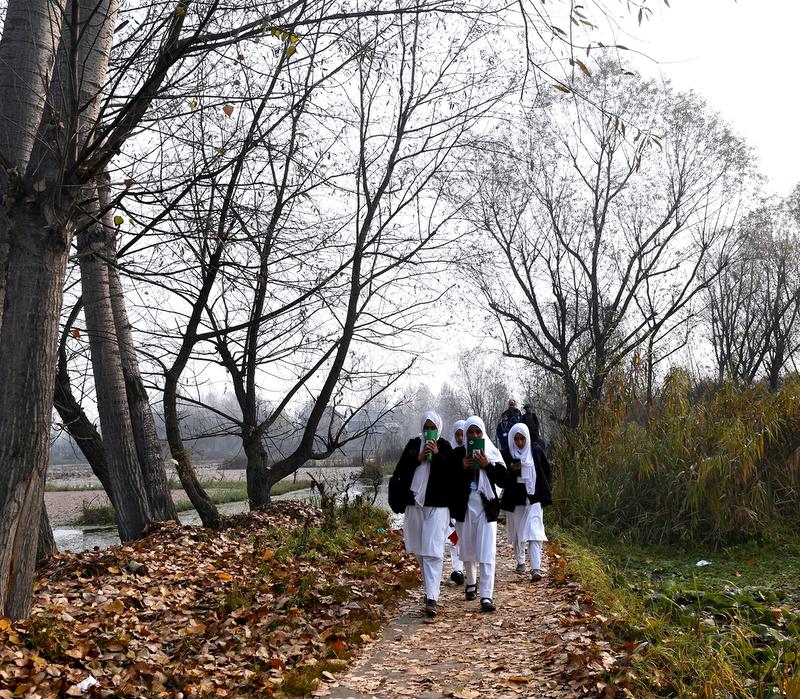
- 10 Jan 2025
In News:
The Unified District Information System for Education Plus (UDISE+) report for 2023-24 reveals a significant decline in school enrolment across India, highlighting critical challenges in the education sector. The total enrolment in grades 1-12 fell by over 1.55 crore students, from 26.36 crore (2018-2022 average) to 24.8 crore in 2023-24. This represents a 6% drop, with the biggest declines occurring in government schools.
Key Findings:
- Enrolment Decline:
- In 2023-24, enrolment decreased from 25.17 crore in 2022-23 to 24.8 crore.
- The drop was not only in government schools (5.59%) but also in private schools (3.67%).
- States like Bihar, Uttar Pradesh, and Maharashtra saw the largest decreases.
- The decline in enrolment is despite an increase in the number of schools, from 14.66 lakh in 2022 to 14.72 lakh in 2023.
- Methodology Change:
- A significant change in the data collection methodology occurred in 2022-23, including linking enrolment to Aadhaar numbers, aimed at reducing data duplication.
- While this has improved data accuracy, it has also led to the removal of inflated figures, explaining part of the enrolment drop.
- Despite these changes, there has been a notable decline of 37 lakh students from 2022-23 to 2023-24, which remains unexplained in the report.
- Gender and Age Trends:
- Boys’ enrolment declined by 6.04%, and girls’ by 5.76%, reflecting a uniform drop across gender groups.
- The dropout rates increase as students progress through school, with the highest dropout at the secondary level.
- Infrastructure and Facilities:
- While most schools have basic facilities like electricity and gender-specific toilets, advanced infrastructure like functional computers (57%) and internet access (53%) is lacking in nearly half of schools.
- This technological gap exacerbates regional disparities and affects educational quality, particularly in rural areas.
- State-Specific Impact:
- Jammu and Kashmir, Assam, Uttar Pradesh, and Madhya Pradesh saw the highest reductions in the number of schools.
- Many school closures or mergers have led to increased distances for students, causing further dropouts during re-admission processes.
Socio-Economic Barriers:
- Economic hardships, migration, and inadequate facilities contribute to the enrolment decline.
- Low-income families and backward regions struggle to prioritize education, further affecting enrolment and retention.
Government Initiatives:
- Initiatives like the National Education Policy (NEP) 2020, Sarva Shiksha Abhiyan, and Right to Education Act (RTE) have made strides in primary education but face challenges in secondary education.
- Education spending has hovered around 4-4.6% of GDP, which is insufficient to meet the needs of the education system.
Moving Forward:
- Targeted Interventions: Focus on expanding vocational training, incentivizing school attendance, and improving digital infrastructure in schools.
- Address Regional Disparities: Conduct audits to address school shortages in densely populated areas and consolidate underutilized urban schools.
- Enhancing Teacher Quality: Invest in teacher training and encourage innovative teaching methods.
- Community Engagement: Promote local participation in school management to address specific educational needs.
Conclusion:
The UDISE+ 2023-24 report underscores the need for urgent reforms in India's education system, focusing on increasing enrolment, reducing dropout rates, and ensuring equitable access to quality education. By addressing these challenges with targeted policies, India can move closer to achieving its educational goals.
Impeachment of Judges
- 12 Dec 2024
In News:
The recent controversy surrounding remarks made by Justice Shekhar Kumar Yadav of the Allahabad High Court has prompted calls for his impeachment. During an event organized by the Vishwa Hindu Parishad (VHP), Justice Yadav made statements that were perceived as communal, leading to concerns over judicial impartiality. This incident has reignited discussions about the impeachment process for judges in India, highlighting the delicate balance between judicial independence and accountability.
Impeachment Process for Judges in India
In India, the impeachment process for judges, although not explicitly mentioned in the Constitution, serves as a mechanism to ensure judicial accountability while safeguarding judicial independence. The process is outlined under Articles 124 and 218 of the Indian Constitution, which govern the removal of Supreme Court and High Court judges, respectively.
Grounds for Impeachment
Judges in India can be removed on two grounds:
- Proved Misbehavior: Conduct that breaches the ethical standards of the judiciary.
- Incapacity: A judge’s inability to perform judicial duties due to physical or mental infirmity.
These grounds are clearly specified to prevent arbitrary removal, ensuring that the process remains fair and just.
Steps in the Impeachment Process
- Initiation of Motion: The process begins when a motion for impeachment is introduced in Parliament, either in the Lok Sabha or Rajya Sabha. The motion must be supported by at least 100 members of the Lok Sabha or 50 members of the Rajya Sabha. This ensures significant parliamentary backing before the motion proceeds.
- Formation of an Inquiry Committee: If the motion is admitted, a three-member inquiry committee is constituted. This includes a Supreme Court judge, the Chief Justice of a High Court, and a distinguished jurist. The committee conducts a thorough investigation into the allegations.
- Committee Report and Parliamentary Debate: Following the investigation, the committee submits its findings. If the judge is found guilty, the report is debated in Parliament. Both Houses must approve the motion by a special majority, which requires a two-thirds majority of members present and voting, as well as a majority of the total membership.
- Final Removal by the President: Once the motion is passed in both Houses, it is presented to the President, who issues the removal order.
Safeguards Against Misuse
The impeachment process includes several safeguards to prevent misuse:
- High Threshold for Initiation: The requirement for significant support from Parliament ensures that the process cannot be initiated frivolously.
- Objective Inquiry: The inquiry committee, comprising legal experts, guarantees an impartial investigation.
- Parliamentary Scrutiny: Both Houses of Parliament are involved, ensuring that the process undergoes democratic scrutiny.
Challenges and Precedents
Despite the rigorous process, no Supreme Court judge has been successfully impeached to date. Past attempts, such as those against Justice V. Ramaswami (1993) and Chief Justice Dipak Misra (2018), were unsuccessful. These instances demonstrate the complexities involved in the impeachment process.
Guidelines for Judges’ Public Statements
Judges in India are entitled to freedom of speech, but they are expected to exercise caution in public statements to maintain the dignity of their office. The Bangalore Principles of Judicial Conduct (2002) and the Restatement of Values of Judicial Life (1997) outline key principles for judicial conduct, including:
- Non-Interference in Political Matters: Judges should refrain from commenting on political issues to avoid any perception of bias.
- Impartiality: Judges must avoid statements that could prejudice ongoing cases or align them with specific ideologies.
Upholding Judicial Impartiality in a Diverse Society
To maintain impartiality, judges must interpret laws based on constitutional values of justice, equality, and secularism. Furthermore, the judiciary must ensure representation from diverse backgrounds to foster inclusivity and reduce systemic biases. Training programs focused on cultural competence and social diversity are essential to ensure that judges are sensitive to the needs of marginalized communities.
Conclusion
The impeachment process, while stringent, plays a critical role in maintaining judicial accountability in India. As seen in the case of Justice Yadav, judicial conduct, particularly public statements, must be carefully scrutinized to preserve the integrity of the judiciary. Upholding impartiality and adhering to constitutional values are paramount in ensuring that the judiciary continues to function as a neutral arbiter in India’s democracy.
Building on the Revival of the Manufacturing Sector
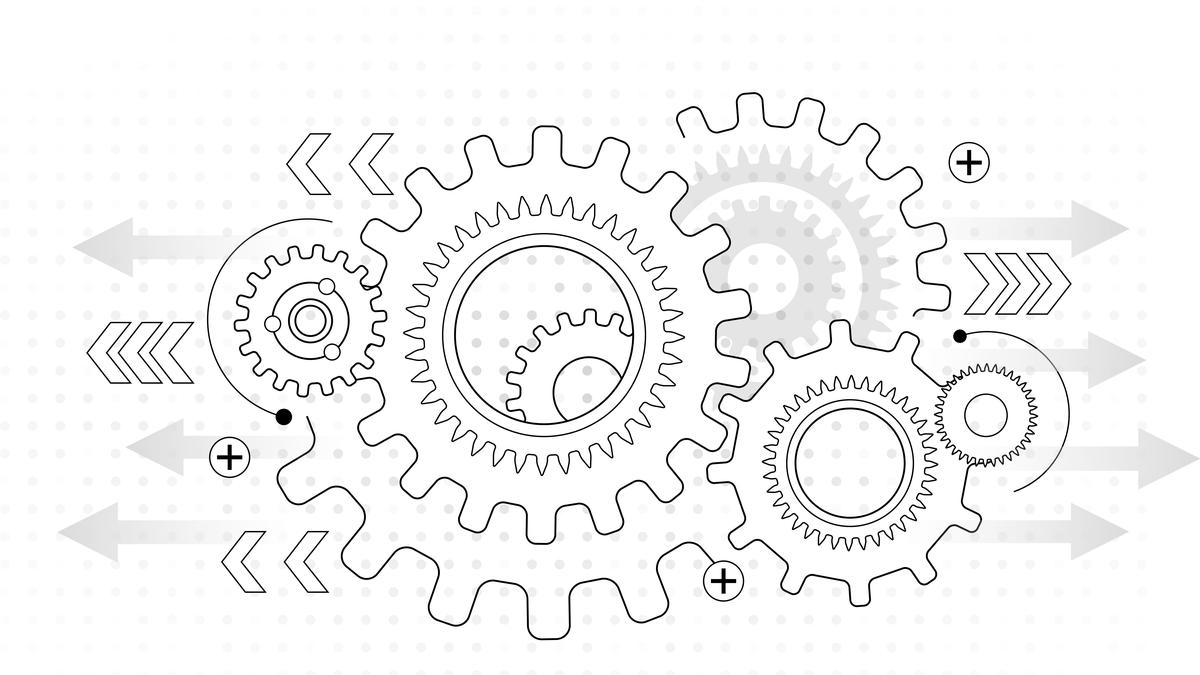
- 07 Dec 2024
In News:
India’s manufacturing sector has shown remarkable signs of recovery and growth, thanks to strategic policy initiatives like the Production Linked Incentive (PLI) scheme. To fully capitalize on this momentum and become a global manufacturing hub, however, deeper reforms are needed.
The Success of the PLI Scheme: A Catalyst for Growth
The government’s PLI scheme has been instrumental in revitalizing key sectors like electronics, pharmaceuticals, automobiles, and textiles. It has not only boosted production but also increased exports and job creation. According to the Annual Survey of Industries (ASI) 2022-23, manufacturing output grew by an impressive 21.5%, while gross value added (GVA) increased by 7.3%. Sectors such as basic metals, refined petroleum products, food products, and motor vehicles, which are beneficiaries of the PLI scheme, contributed 58% of total manufacturing output, registering growth of 24.5%.
This success underlines the potential of India’s manufacturing sector, with the PLI scheme acting as a key enabler. However, while the recovery is promising, there are significant challenges to overcome to sustain long-term growth.
Expanding PLI Incentives to New Sectors
The PLI scheme has largely benefitted traditional industries like electronics and automotive manufacturing. To further accelerate growth, the scope of the scheme must be extended to labour-intensive sectors such as apparel, footwear, and furniture, which hold immense potential for job creation. Additionally, emerging sectors like aerospace, space technology, and maintenance, repair, and overhaul (MRO) services offer new avenues for growth. By diversifying the incentive structure to these sectors, India could establish a more robust and resilient manufacturing ecosystem.
In sectors like capital goods, where India is heavily import-dependent, the potential for reducing supply chain vulnerabilities is significant. Moreover, promoting green manufacturing and advanced technologies could further bolster India’s competitiveness in global markets.
Addressing the Divergence Between Output and Value Addition
Despite a surge in production, India’s gross value added (GVA) has not kept pace with output growth. The ASI data shows that input prices soared by 24.4% in 2022-23, indicating that while production volumes are up, industries are grappling with high input costs. A more streamlined import regime could mitigate these costs. Simplifying tariffs into a three-tier system (for raw materials, intermediates, and finished goods) would reduce input costs, enhance competitiveness, and improve integration into global value chains.
Regional Imbalance: A Barrier to Inclusive Growth
The manufacturing sector’s growth is heavily concentrated in a few states such as Maharashtra, Gujarat, Tamil Nadu, Karnataka, and Uttar Pradesh, which account for over 54% of manufacturing GVA. This concentration not only restricts equitable development but also hampers the overall growth potential of the sector. To address this, it is crucial that states actively participate in India's manufacturing growth story by implementing market reforms in land, labour, and power. Additionally, infrastructure development and investment promotion in less industrialized regions could help balance growth and ensure that the benefits of manufacturing reach all corners of the country.
Fostering MSME Growth and Enhancing Female Workforce Participation
Micro, small, and medium enterprises (MSMEs) contribute about 45% of India’s manufacturing GDP and employ around 60 million people. To scale these businesses and integrate them into global value chains, PLIs should be tailored to accommodate their needs, such as lowering capital investment thresholds and reducing production targets.
Equally important is the enhancement of female workforce participation. Studies suggest that India’s manufacturing output could increase by 9% if more women enter the workforce. The development of supportive infrastructure, such as hostels and childcare facilities, can play a pivotal role in enabling women’s participation, thus driving inclusive growth.
Conclusion: The Path Forward
To transform into a developed economy by 2047, India must continue to focus on strengthening its manufacturing sector. According to industry estimates, manufacturing’s share in Gross Value Added (GVA) can rise from 17% to 25% by 2030 and further to 27% by 2047. Achieving this will require sustained efforts to enhance competitiveness through business reforms, cost reduction, and policy support. India is well-positioned to harness its manufacturing potential, but timely and focused interventions are necessary to turn this vision into reality.
Reflections on Baku’s ‘NCQG Outcome’ at COP29

- 06 Dec 2024
In News:
The recently concluded COP29 in Baku, Azerbaijan, has brought the spotlight back to climate finance, particularly in relation to the New Collective Quantified Goal (NCQG). As the global community grapples with the escalating climate crisis, the discussions and outcomes from the COP29 summit are pivotal in shaping future climate action. However, the agreed-upon financial targets, which were expected to be a step towards transformative climate justice, have sparked significant concern, particularly among developing nations.
The Need for Climate Finance: A Global Responsibility
Climate finance is essential for supporting developing countries, which bear the brunt of climate change despite contributing minimally to global emissions. The Intergovernmental Panel on Climate Change (IPCC) has stressed the need to limit global warming to 1.5°C above pre-industrial levels, yet current policies could lead to a rise of up to 3.1°C. To counter this, developing nations require financial assistance to transition to green energy, adapt to climate impacts, and implement their Nationally Determined Contributions (NDCs).
The upfront costs of green technologies, such as renewable energy, are high, and while they offer long-term savings, their initial investments remain a significant barrier. Additionally, many developing countries face fiscal constraints, making it even more difficult to adopt climate-friendly technologies without external financial support.
The Role of NCQG in Addressing Climate Finance Gaps
The NCQG, an evolution of the 2010 $100 billion annual commitment, aims to provide clarity and accountability in climate financing. Established as a framework to ensure financial resources for climate action, the NCQG should ideally focus on the evolving needs of the Global South. However, at COP29, the target agreed upon was a mere $300 billion annually by 2035, far from the $1.3 trillion that developing countries had requested. This amount falls drastically short of what is necessary to meet the ambitious climate goals and fails to represent a transformative shift in financial flows.
Key Challenges and Discontent with the Outcome
Several challenges have been raised regarding the COP29 outcome:
- Equity and Responsibility: Developed nations are expected to bear a larger share of the financial burden, in line with the principle of 'Common but Differentiated Responsibilities' (CBDR). However, the NCQG outcome bypasses this principle, offering insufficient funds for climate action in developing countries.
- Types of Finance: There is debate over whether private finance should count towards the goal. Developing countries have stressed the importance of public finance over loans, which add to their debt burdens.
- Insufficient Commitment: While the $300 billion annual pledge is a step forward, it is far from adequate. The global climate finance needs, estimated at $5 trillion to $7 trillion by 2030, require bolder commitments from developed nations.
India's Position and Domestic Efforts
At COP29, India emphasized the need for developed countries to fulfill their financial commitments, advocating for at least $1.3 trillion annually until 2030. India, despite being a developing country, has also made significant strides in climate action through domestic policies. The 2024-25 Union Budget allocated substantial funds to renewable energy projects, including ?19,100 crore for the Ministry of New and Renewable Energy. These efforts demonstrate India’s commitment to climate goals, though the financial flow remains insufficient.
Conclusion: The Road Ahead
The NCQG outcome at COP29 highlights the ongoing disparities in global climate finance commitments. While the $300 billion annual target is a step forward, it does not align with the urgency or scale required to tackle the climate crisis. To achieve a just and equitable transition to a sustainable future, future climate finance discussions must prioritize transparency, accountability, and fairness, ensuring that developed nations shoulder their fair share of the responsibility. The path forward requires unwavering international cooperation to ensure that developing countries receive the necessary support to mitigate and adapt to the impacts of climate change.
Current Representation of Women in CAPFs
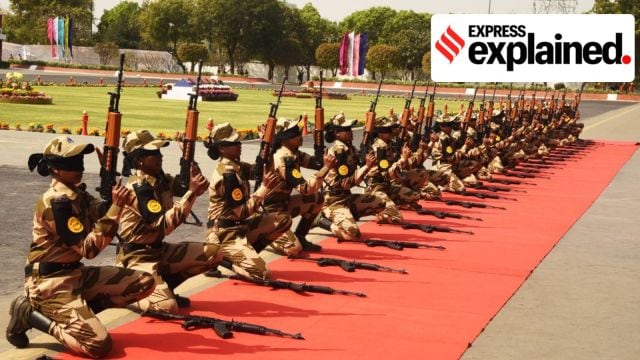
- 04 Dec 2024
In News:
The Central Armed Police Forces (CAPFs) of India, comprising forces like CRPF, BSF, CISF, and others, play a crucial role in maintaining internal security. Women’s participation in these forces has been historically limited, but recent efforts have focused on increasing their representation. As of 2024, women constitute only 4.4% of the total personnel in CAPFs, highlighting the slow progress despite various initiatives.
Current Representation and Changes Over Time
- Overall Representation: Women make up 4.4% of the 9.48 lakh-strong CAPFs. Within this, the Central Industrial Security Force (CISF) has the highest representation at 7.02%, followed by the Sashastra Seema Bal (SSB) at 4.43%, Border Security Force (BSF) at 4.41%, Indo-Tibetan Border Police (ITBP) at 4.05%, Assam Rifles at 4.01%, and Central Reserve Police Force (CRPF) at 3.38%.
- Growth of Women Personnel: From 15,499 women in 2014, the number has tripled to 42,190 in 2024, reflecting a steady increase in recruitment. However, the percentage remains low despite these gains.
- Recruitment Trends: In 2024, 835 women were recruited, with 5,469 more in the process. In 2025, 4,138 women are expected to be recruited.
Government Efforts and Parliamentary Committee Recommendations
- Policy Measures: The government has introduced several steps to encourage women’s participation in CAPFs, such as reservations in constable-level positions: one-third for CRPF and CISF, and 14-15% for border forces like BSF, SSB, and ITBP.
- Challenges in Recruitment: Despite these policies, recruitment has not kept pace with the targets. The 2022 Parliamentary Committee on Home Affairs expressed disappointment over the “abysmally low” number of women in CAPFs, noting that women made up only 3.68% of the forces at that time.
- Recommendations by Parliamentary Committees:
- The Home Affairs Committee recommended fast-tracking phase-wise recruitment of women, particularly in CISF and CRPF.
- The Standing Committee on Personnel (2023) suggested “soft postings” for women to avoid difficult working conditions, especially in remote or strenuous terrains. It also called for reservations for transgender individuals.
- In 2024, further steps like fee waivers, relaxed physical standards, and provisions for maternity and child care leave were introduced to make the work environment more inclusive.
Reasons Behind Low Representation
- Cultural Barriers: Traditional gender roles and societal expectations deter many women from pursuing careers in security forces.
- Work Environment: The demanding nature of the job, which includes postings in remote areas and high-risk operations, makes it less appealing, especially for women with family responsibilities.
- Infrastructure Issues: Lack of adequate accommodation, sanitation facilities, and safety measures for women are deterrents to joining and retaining female personnel.
Conclusion and Future Outlook
Although the representation of women in CAPFs has seen improvement, it remains below expectations due to persistent challenges. The government’s continuous focus on recruitment reforms, better working conditions, and policy incentives will be crucial to achieve gender parity in these forces. As societal attitudes evolve and the infrastructure improves, more women may be encouraged to serve in these vital security roles. Future efforts must include targeted recruitment drives and creating a more inclusive and supportive environment to enhance women’s participation in CAPFs.
Digital Arrests

- 01 Dec 2024
In News:
In 2024, India has witnessed an alarming rise in cybercrime, particularly a new scam called "digital arrests." This type of fraud involves criminals impersonating law enforcement officials to extort money from victims. With more than 92,000 people targeted and ?2,141 crore defrauded from victims, these scams are rapidly becoming a significant concern for the public and law enforcement.
Nature of ‘Digital Arrests’
The modus operandi of digital arrest scams is sophisticated and emotionally manipulative. Cybercriminals contact victims through video calls, often using fake police officers' profiles and official documents to build credibility. They accuse victims of serious crimes such as money laundering or drug trafficking, claiming urgent action is needed to avoid arrest. The scammers create a false atmosphere of fear and urgency, convincing the victim to transfer large sums of money under the pretext of settling legal dues.
A notable example involves Ruchi Garg, who was targeted by scammers posing as police officers, falsely claiming her son was involved in a major scam. She was coerced into transferring ?80,000 before realizing it was a scam. Similar cases have affected hundreds, with perpetrators using AI-generated voices and fake visuals to amplify the deception.
The Growth of Cybercrime in India
Digital arrest scams are part of a broader increase in cybercrime in India. The Indian Cyber Crime Coordination Centre (I4C) has reported a rise in cyber fraud, with financial losses exceeding ?27,900 crore between 2021 and 2024. The most significant sources of these losses include stock trading scams, Ponzi schemes, and digital arrest frauds. As criminals adapt to emerging technologies and use social engineering tactics, the scale and complexity of scams are growing.
The surge in cybercrimes is fueled by vulnerabilities in India's digital landscape. With over 95 crore Internet users, many people, particularly the elderly or less tech-savvy, remain susceptible to such fraud. Cybercriminals often exploit this lack of awareness, combining fear and confusion to manipulate victims.
International Scope and Challenges
One of the challenges in combating digital arrests is the transnational nature of cybercrime. Scams often originate from countries like China, Cambodia, and Myanmar, where "scam compounds" run operations to train individuals in fraudulent techniques. These groups use virtual private networks (VPNs) and encrypted apps to conceal their identities and locations, making it difficult for Indian authorities to trace them.
Moreover, the involvement of mule bank accounts to launder defrauded money complicates investigations. Thousands of such accounts are identified and blocked regularly, but the flow of money continues through multiple channels, including cryptocurrencies.
Government Efforts and Preventive Measures
To address the growing menace of digital frauds, the Indian government has initiated several measures. The I4C, launched in 2020, aims to strengthen the response to cybercrimes by coordinating with various law enforcement agencies. The National Cyber Crime Reporting Portal allows citizens to report cyber fraud, while real-time alerts are sent to banks to prevent financial losses.
Additionally, the Cyber Crime Coordination Centre and other initiatives like Cyber Surakshit Bharat and CERT-In are working to enhance cybersecurity awareness and support victims. The Digital Personal Data Protection Act, 2023, also aims to regulate data security, which can reduce the sale of personal data on the dark web, a key enabler of these scams.
Conclusion
‘Digital arrests’ exemplify the evolving nature of cybercrimes in India. As digital threats become more complex and widespread, it is essential for citizens to remain vigilant and informed. Effective law enforcement, technological innovations, and public awareness are critical to reducing the impact of these scams and safeguarding the digital economy.
Biomedical Waste Regulations
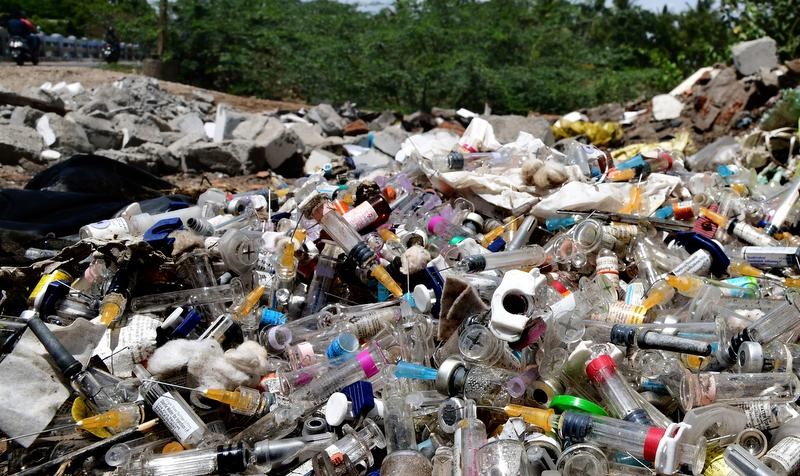
- 30 Nov 2024
The Emergence of HIV and Global Panic
In 1983, scientists Luc Montagnier and Robert Gallo independently identified the virus responsible for AIDS. By the mid-1980s, HIV/AIDS was perceived as a biological death sentence, with the virus primarily attacking immune cells, making medical intervention difficult. The epidemic quickly became associated with fear, ignorance, and stigma, as it was often linked to marginalized groups.
The "Syringe Tide" Incident and Public Outrage
In August 1987, the U.S. faced a public health crisis when discarded medical waste, including syringes and blood vials, washed up on beaches along the Atlantic coast. Known as the "Syringe Tide," this incident shocked the public and fueled anxiety, especially when children were seen playing with syringes. Traced to improper waste disposal in New York City, the event highlighted the hazardous nature of medical waste, which had been previously underestimated. Combined with the HIV/AIDS epidemic, this incident amplified public fear and economic losses of up to $7.7 billion due to the decline in tourism.
U.S. Response: Medical Waste Tracking Act of 1988
The widespread outrage led to the U.S. government passing the Medical Waste Tracking Act in 1988. This was the first law to formally categorize hospital waste as hazardous. The Act introduced stringent guidelines for the handling, transportation, and disposal of medical waste, establishing systemic regulation and oversight. It marked a significant turning point in both public health and environmental safety, changing how medical waste was managed in the healthcare sector.
India’s Journey in Biomedical Waste Management
Initial Steps and Delays
While the U.S. responded swiftly to the crisis, India’s approach to managing biomedical waste was slower. In 1986, India enacted the Environmental Protection Act, which marked the country’s first significant step towards environmental conservation. That same year, India identified its first HIV case. However, biomedical waste was not yet recognized as hazardous, and the Hazardous Waste (Management and Handling) Rules of 1989 failed to address the issue. As a result, local bodies were left to manage waste disposal, leading to inefficiencies.
Judicial Intervention and Legislative Action
In the 1990s, as pollution levels rose, particularly in urban areas like Delhi, the inadequacies of the system became apparent. In the landmark case Dr. B.L. Wadehra vs. Union of India (1996), the Supreme Court criticized Delhi’s waste management system, calling the city an "open garbage dump." This judgment led to a nationwide conversation on waste management and resulted in the Biomedical Waste (Management and Handling) Rules of 1998, marking the formal recognition of hospital waste as hazardous. The rules empowered the Central and State Pollution Control Boards to regulate waste disposal, ensuring accountability.
The Link Between HIV and Biomedical Waste Regulations
The HIV crisis highlighted the need for safe disposal practices to protect the environment and healthcare workers. While India charted its own course, the global response to HIV, particularly the U.S. model, influenced India’s approach to biomedical waste management. Over the years, India has made significant progress, with amendments to the rules in 2016 and 2020 to improve waste management technology and ensure safe disposal.
Current Challenges and Progress
- Ongoing Issues in Biomedical Waste Management: Despite significant progress, challenges remain, especially in rural and resource-limited areas. Mishandling of biomedical waste continues to pose risks, and healthcare professionals still face occupational hazards. Gaps in compliance and awareness persist, but the system’s progress is undeniable.
Conclusion
The HIV/AIDS epidemic, while tragic, indirectly led to significant improvements in healthcare waste management. As the crisis highlighted the dangers of improper waste disposal, it spurred legislative and systemic changes that have contributed to safer healthcare environments. The progress in biomedical waste management demonstrates that crises can often lead to long-term improvements.
India’s Urban Infrastructure
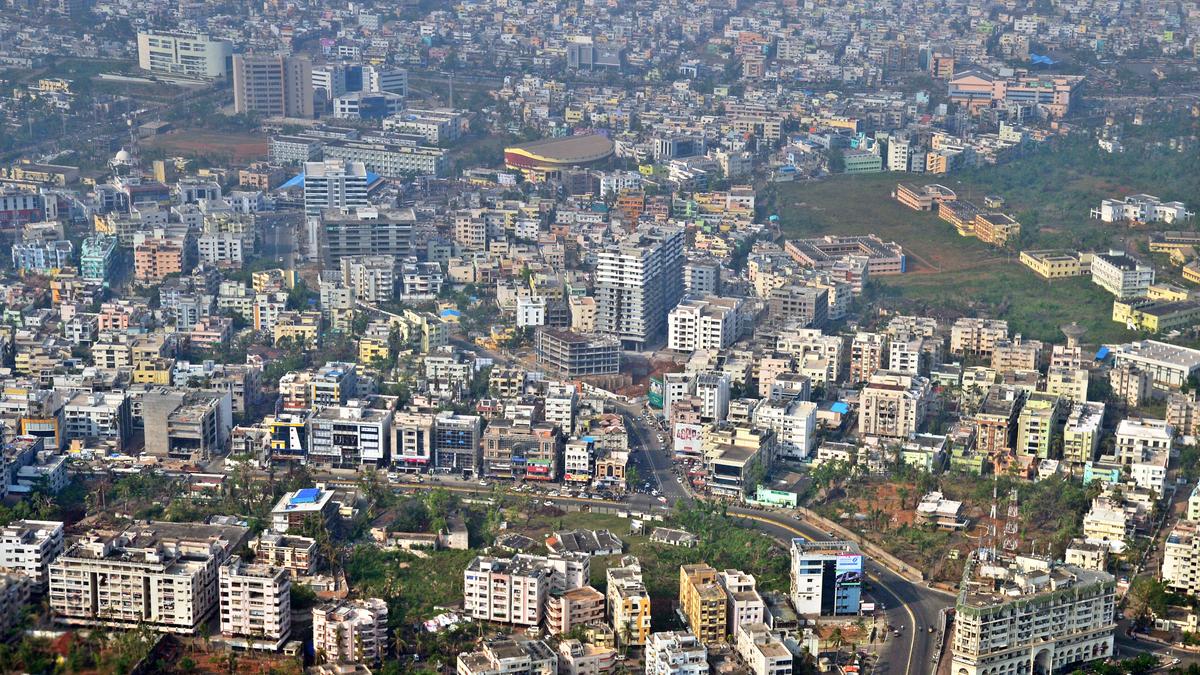
- 28 Nov 2024
Introduction
India’s urban population is projected to double from 400 million to 800 million by 2050. This demographic shift presents both challenges and opportunities for transforming the country’s urban infrastructure. To meet the growing needs of urban areas, India will require an investment of approximately ?70 lakh crore by 2036, a figure significantly higher than current spending levels.
Financial Challenges in Urban Infrastructure
- Investment Gap
- The current annual investment in urban infrastructure stands at ?1.3 lakh crore, which is only 28% of the ?4.6 lakh crore needed annually.
- A large portion of the existing investment, around 50%, is directed towards basic urban services, with the remainder allocated to urban transport.
- Municipal Finances
- Municipal finances have remained stagnant at 1% of GDP since 2002.
- Despite increased transfers from the central and state governments, municipal bodies face financial strain.
- The contribution of municipal own-revenue has decreased from 51% to 43%, indicating a reduced financial independence.
- Revenue Collection Inefficiencies
- Urban local bodies (ULBs) are collecting only a small fraction of their potential revenues, with property tax collections representing just 0.15% of GDP.
- Cost recovery for essential services like water supply and waste management ranges between 20% and 50%, pointing to a significant funding gap.
- Underutilization of Resources
- Cities like Hyderabad and Chennai utilized only 50% of their capital expenditure budgets in 2018-19.
- Central schemes such as AMRUT and the Smart Cities Mission also showed suboptimal fund utilization, with utilization rates of 80% and 70%, respectively.
- Decline in Public-Private Partnerships (PPPs)
- Investments through PPPs in urban infrastructure have seen a sharp decline, from ?8,353 crore in 2012 to ?467 crore in 2018.
- This drop is attributed to limited project-specific revenues and inadequate funding mechanisms.
Structural and Administrative Challenges
- Weak Governance and Fragmented Management
- Fragmented governance and limited administrative autonomy hinder effective urban planning and resource allocation.
- Municipal bodies often lack the ability to undertake long-term planning and project execution due to these governance challenges.
- Climate Vulnerability and Sustainability: Urban areas are increasingly vulnerable to climate risks like floods and heatwaves. However, many urban infrastructure projects fail to incorporate climate resilience in their planning, exacerbating the long-term vulnerability of investments.
- Inadequate Land Management
- There is poor coordination between land use planning and infrastructure development, resulting in urban sprawl and inefficient transportation systems.
- Opportunities to capitalize on the land value generated by metro and rail projects remain underutilized.
Measures for Transforming Urban Infrastructure
- Streamline Revenue Collection: Leverage technology to improve property tax collection systems and enhance cost recovery in essential services.
- Enhance Fund Utilization: Strengthen municipal capacities for effective project planning and incentivize the timely use of allocated grants.
- Scale Public-Private Partnership (PPP) Investments: Develop a pipeline of bankable projects and create risk-sharing mechanisms to attract private sector investments.
- Decouple Project Preparation from Funding: Ensure that infrastructure projects are thoroughly prepared for financial, social, and environmental sustainability before seeking funding.
- Promote Urban Innovation: Establish urban innovation labs and encourage public-private-academic collaborations to foster the adoption of advanced technologies.
- Empower Municipalities: Grant municipalities greater financial autonomy, enabling them to raise capital through municipal bonds and other debt mechanisms.
- Integrated Urban Planning: Align infrastructure development with land use, transport, and housing requirements, while integrating climate resilience into planning.
- Capacity Building: Invest in the training of municipal staff to improve governance and financial management capabilities.
Conclusion
India’s expanding urban population presents a major opportunity for economic growth. However, addressing the financial and structural challenges in urban infrastructure is crucial for harnessing this potential. By adopting a combination of short-term actions, medium-term strategies, and long-term reforms, India can create sustainable, resilient urban infrastructure that meets the growing needs of its cities, fostering inclusive development and long-term prosperity.
The Fight for Accessibility and Dignity in Indian Prisons

- 24 Nov 2024
Introduction
Prisons in India face numerous systemic issues, with overcrowding, abuse, and neglect being prevalent. For prisoners with disabilities, these challenges are magnified, as they struggle with basic needs and lack necessary accommodations. This issue is not only a human rights violation but also a failure in the implementation of legal protections.
Prison Conditions and Accessibility Issues for Disabled Inmates
- Challenges Faced by Disabled Prisoners: Disabled prisoners, such as Professor G.N. Saibaba, who spent a decade in prison before being exonerated, face severe challenges in performing everyday tasks like using toilets or taking baths. His experience of being physically lifted by fellow inmates due to the lack of wheelchair accessibility highlights the systemic neglect.
- Exclusion and Abuse: Prisoners with disabilities are particularly vulnerable to abuse, as their specific needs are ignored. The government does not track the number or conditions of disabled prisoners, which leads to neglect and mistreatment. Notably, Father Stan Swamy, who had Parkinson's disease, was denied essential items like a straw, affecting his ability to eat and drink.
Legal Framework and International Obligations
- Constitutional Protections: The Indian Constitution guarantees rights to prisoners, including protection from torture (Article 21) and the right to fair legal processes (Article 22). The Supreme Court has reinforced the need for humane treatment in prisons through various judgments.
- International Commitments: India has committed to international conventions such as the United Nations Convention on the Rights of Persons with Disabilities and the Nelson Mandela Rules, which require reasonable accommodations for disabled prisoners. Despite these commitments, the practical enforcement of such rights remains minimal.
- Domestic Legislation: The Rights of Persons with Disabilities Act, 2016, mandates the protection of disabled individuals from abuse and exploitation. However, violations like the denial of basic assistive devices to prisoners show a gap in enforcement. The Ministry of Home Affairs has issued guidelines for prison accessibility, but they have yet to be widely implemented.
Systemic Failures and Lack of Political Will
- Overcrowding and Inadequate Infrastructure: Indian prisons house over 5.73 lakh prisoners, far exceeding their capacity. This overcrowding exacerbates the challenges faced by disabled prisoners, as the infrastructure is inadequate to meet their needs. A 2018 audit of Delhi’s prisons revealed significant accessibility gaps, such as inaccessible cells and toilets, making daily life for disabled prisoners even more difficult.
- Political Apathy and Public Indifference: Many believe that prisoners deserve their suffering, fueling a lack of urgency in addressing prison reforms. However, the state is responsible for ensuring the rights and dignity of all prisoners, including those with disabilities. There is a need for a shift in societal attitudes to ensure that these rights are upheld.
Reforms and the Way Forward
- Infrastructure and Accessibility: Prisons must implement universal design principles, ensuring that infrastructures are accessible to all, especially prisoners with disabilities. This includes accessible cells, toilets, and common areas, as well as functional wheelchairs.
- Judicial and Legal Reforms: The judicial system must expedite trials, especially for undertrials, and ensure that all prisoners have access to legal representation. This would help alleviate the overcrowding crisis and improve the overall functioning of the prison system.
- Comprehensive Rehabilitation and Welfare Programs: Prison systems need to focus on rehabilitation rather than mere punishment. Programs for skill development, education, and mental health support should be integrated into prison routines, providing prisoners with opportunities for personal growth and reintegration into society.
- Strengthening Oversight Mechanisms: There must be greater transparency in prison management through independent oversight bodies and regular audits. A whistleblower mechanism can help report violations of prisoner rights, ensuring greater accountability.
India’s Agricultural Sector
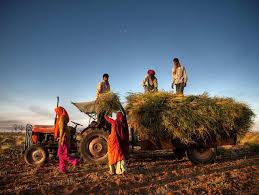
- 23 Nov 2024
In News:
India’s agricultural sector, which employs 42.3% of the population, is crucial to the nation’s economy. However, it faces a range of challenges that need to be addressed to ensure long-term stability, food security, and sustainable growth.
Current Performance of India’s Agricultural Sector
- Key Agricultural Metrics and Growth
- Foodgrain Production: India produced 330.5 million metric tonnes (MT) of foodgrains in 2022-23, maintaining its position as the world’s second-largest producer.
- Horticulture Production: A record high of 351.92 million tonnes in horticultural production was achieved, marking a 1.37% increase from the previous year.
- Market Outlook
- India’s agricultural market is projected to reach USD 24 billion by 2025.
- The food and grocery retail sector is ranked as the sixth-largest globally, with 70% of its sales generated from retail.
- Investment and Export Trends
- FDI in Agriculture: From April 2000 to March 2024, the agricultural services sector attracted USD 3.08 billion in foreign direct investment, while the food processing industry garnered USD 12.58 billion.
- Agricultural Exports: India’s agricultural and processed food exports reached USD 4.34 billion in 2024-25, including products like marine products, rice, and spices.
Key Challenges Confronting India’s Agriculture
- Climate Change and Environmental Impact:Extreme weather events, such as heatwaves and erratic rainfall, continue to impact agricultural productivity. In 2023, India experienced its second-warmest year on record, contributing to crop damage and rising food prices.
- Water Stress and Irrigation Inefficiency: Agriculture consumes the majority of India’s water resources, but irrigation efficiency is still low. The country relies heavily on flood irrigation, which leads to significant water wastage. Only 11% of agricultural land is under micro-irrigation, far below global standards.
- Land Fragmentation and Declining Farm Sizes: The average size of agricultural farms has decreased from 1.08 hectares in 2016-17 to 0.74 hectares in 2021-22, hindering the adoption of modern farming practices and mechanization.
- Market Access and Price Realization: Farmers continue to face challenges in accessing fair market prices due to the dominance of intermediaries and inadequate market infrastructure. Despite reforms like e-NAM, price gaps between farm-gate and retail prices persist, leaving farmers with a smaller share of the final price.
- Technology Adoption and Digital Divide: Although agritech is growing in India, only 30% of farmers use digital tools in agriculture, and rural digital literacy is just 25%, which limits the widespread adoption of modern farming solutions.
Addressing Structural Issues in Indian Agriculture
- Soil Health and Sustainability:The excessive use of chemical fertilizers and mono-cropping practices has led to soil degradation. Approximately 30% of agricultural land in India is experiencing degradation, impacting productivity and sustainability. Stubble burning further exacerbates this issue, worsening air quality and soil health.
- Crop Diversification Challenges:Many farmers are locked into the wheat-rice cycle due to Minimum Support Price (MSP) guarantees, limiting the cultivation of other crops like pulses and oilseeds. Although India is the largest producer of pulses, the domestic production is insufficient to meet the growing demand.
- Feminisation of Agriculture:Women make up 63% of agricultural workers but own only 11-13% of the operational land, limiting their access to resources and decision-making power. This gender disparity hampers their economic security and limits their participation in agricultural development.
Conclusion
India’s agricultural sector holds immense potential but is facing significant structural challenges that must be addressed to ensure its long-term growth and sustainability. Urgent reforms are needed to address issues like climate vulnerability, inefficient irrigation, land fragmentation, and limited market access. Additionally, fostering technology adoption, improving infrastructure, and addressing gender disparities will be crucial for improving the sector's performance and securing India’s food security needs.
Janaagraha’s Report on Urban Local Bodies
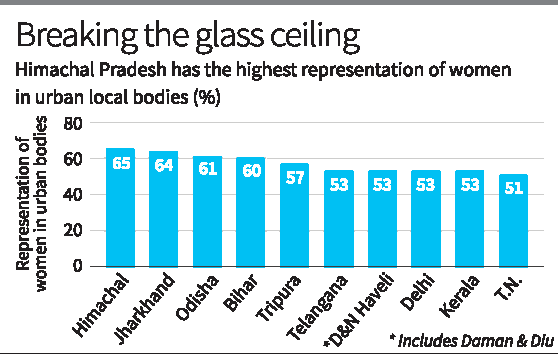
- 22 Nov 2024
In News:
46% of councillors in urban local bodies are women, says a report by Janaagraha, a not-for-profit organisation working to strengthen systems of governance in India’s cities.
Overview: Gender Representation in Urban Local Bodies
- Women Councillors in India: Around 46% of councillors in urban local bodies (ULBs) are women, according to a recent report by Janaagraha, a non-profit organization focused on strengthening urban governance systems.
- Capital Cities: In 19 out of 21 capital cities with active ULBs (such as Patna, Shimla, Ranchi, and Bhubaneswar), women councillors exceed 60% of the total councillor count.
Top States for Women Councillors
- Tamil Nadu stands out with the highest number of women councillors in the country, according to the "Roadmap for India’s City Systems Reforms" report by Janaagraha.
- Other States in the Top 10:
- Rajasthan, Madhya Pradesh, Maharashtra, Andhra Pradesh, Karnataka, Uttar Pradesh, Kerala, Bihar, and Chhattisgarh.
Women’s Reservation and Empowerment
- 50% Reservation: 17 states have legislated 50% women’s reservation in urban local bodies, surpassing the constitutional minimum of 33%.
Pathways for Urban Transformation
- Three Key Recommendations:
- Place-Based Governance: Advocates for governance focused on regional economies and local governments rather than sector-driven policies.
- Decentralised Participatory Governance: Emphasizes the need to strengthen urban local governments and increase citizen participation through the 74th constitutional amendment.
- Building State Capacities: Calls for a more effective role of the Ministry of Housing and Urban Affairs and state urban departments focused on local self-government.
Rural-Urban Transition and Policy Reforms
- Urbanization of Villages: The report highlights that about 1,000 villages have already transitioned into urban areas since the 2011 Census, urging the need for a rural-urban transition policy.
- Reimagine Urban Ministries: Recommends restructuring urban ministries to focus on regional economies and the strengthening of local governance institutions.
Key Challenges in Urban Governance
- Delays in Elections: 61% of ULGs in 15 states have delayed council elections.
- Disempowered Local Bodies: Mayors and ULGs often lack autonomy, with control over only four out of 18 functions.
- Citizen Participation Gaps: There is a lack of formal platforms for citizen involvement in governance.
Skilling and Capacity Building
- Certification-Based Training: Proposes skilling programs for ULG staff, with a focus on improving municipal efficiency and project implementation.
- Shared Service Centres: Recommends creating municipal service centres to benefit smaller cities and enhance urban management.
Conclusion: Need for Place-Based Governance
- Strategic Shift: Srikanth Viswanathan, CEO of Janaagraha, emphasized the need to shift away from a sector-based governance model to a place-based governance approach, better suited to the urban challenges of modern India.
Sustainable Path to Net-Zero for India
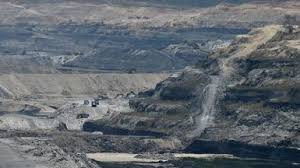
- 19 Nov 2024
In News:
India's commitment to achieving net-zero carbon emissions by 2070 presents a significant challenge, with only 45 years remaining to reach this ambitious target. The path to net-zero requires a balancing act between economic development, energy security, and climate adaptation. India’s efforts to meet its climate goals will be shaped by multiple factors, including resource constraints, land use, and financial limitations.
Why Net-Zero at All?
- Scientific Consensus on Climate Change
- Climate change is a growing concern, with the global temperature rise already reaching 1.1°C above pre-industrial levels.
- To avoid catastrophic impacts, the world needs to limit the temperature rise to 1.5°C. The remaining global carbon budget for this target is around 400-500 billion tonnes of CO?.
- Necessity of Sharp Emission Reductions
- Countries must drastically reduce emissions to stay within the carbon budget. Achieving net-zero emissions is essential for maintaining global climate stability.
Equity in Net-Zero Transitions
- Developed vs. Developing Countries
- Developed nations, historically responsible for a large share of emissions, are expected to lead the transition. However, they have not met the financial and technological support commitments for developing countries.
- Developing nations like India, with low per capita emissions, are under pressure to balance climate action with economic development.
- Climate Justice
- India’s per capita emissions are among the lowest globally, but the richest 10% of Indians contribute significantly to national emissions, exacerbating inequality.
- The impacts of climate change disproportionately affect the economically weaker sections, making the transition to net-zero not only an environmental challenge but a social justice issue as well.
The Challenge of Balancing Development and Sustainability
- Limits of India’s Resources
- India faces resource constraints, including land, water, and biodiversity, which limit the feasible expansion of renewable energy capacity.
- Meeting energy demands while ensuring food security, forest cover, and biodiversity preservation becomes increasingly challenging as energy requirements rise.
- Sustainable Consumption vs. Aspirational Lifestyles
- India’s aspiration to emulate the developed world’s lifestyle is unsustainable due to limited resources, which could lead to severe consequences like groundwater depletion, heat stress, and biodiversity loss.
- The focus should be on sufficiency consumption corridors, ensuring that consumption meets developmental goals without exceeding sustainable limits.
Projected Power Demand and Renewable Energy Targets
- Rising Power Demand
- India’s power demand could increase nine to ten-fold by 2070. Meeting this demand entirely via renewable energy requires significant expansion in energy generation capacity:
- 5,500 GW of solar energy
- 1,500 GW of wind energy
- India’s power demand could increase nine to ten-fold by 2070. Meeting this demand entirely via renewable energy requires significant expansion in energy generation capacity:
- Land Use Constraints
- To meet these targets, India must address land-use trade-offs. Expanding beyond 3,500 GW of solar and 900 GW of wind would require significant compromises in land availability for other uses, including agriculture and conservation.
Strategic Pathways to Net-Zero: Demand and Supply Measures
- Demand-Side Measures
- Energy-efficient construction: Use of better materials and passive designs to reduce cooling energy demand.
- Urban transport: Shift to public and non-motorized transport to reduce energy consumption in cities.
- Dietary choices: Promoting sustainable dietary practices to reduce the carbon footprint of food systems.
- Electrification: Focus on alternative fuels and energy-efficient appliances.
- Supply-Side Measures
- Decentralization of Energy Production: Expanding rooftop solar panels and solar pumps for agriculture.
- Nuclear Power Expansion: Increase nuclear energy to provide a low-carbon baseload and complement renewable sources like solar and wind, which are intermittent.
The Role of International Cooperation and Financial Support
- Global Cooperation
- Global climate action requires alignment between national interests, which may not always coincide, as seen in the context of the U.S. presidential election potentially influencing global climate policy.
- India’s path to net-zero depends heavily on international climate financing, technology transfer, and collaborative efforts to address climate justice.
- Equitable Financing for Developing Countries
- Developed countries are expected to provide financial support to developing nations like India to achieve climate goals. However, this support has been insufficient to date.
Conclusion: India’s Balancing Act
India faces a challenging balancing act as it seeks to provide quality of life for its growing population while achieving its climate adaptation and mitigation goals. The path to net-zero will require careful management of economic growth, energy production, and resource conservation. India must focus on demand-side strategies to reduce energy consumption and increase efficiency while expanding renewable energy infrastructure in a sustainable manner. Additionally, international cooperation and financial support will be crucial in ensuring that India’s transition to net-zero is equitable, efficient, and aligned with its developmental priorities.
Net Borrowing Ceiling
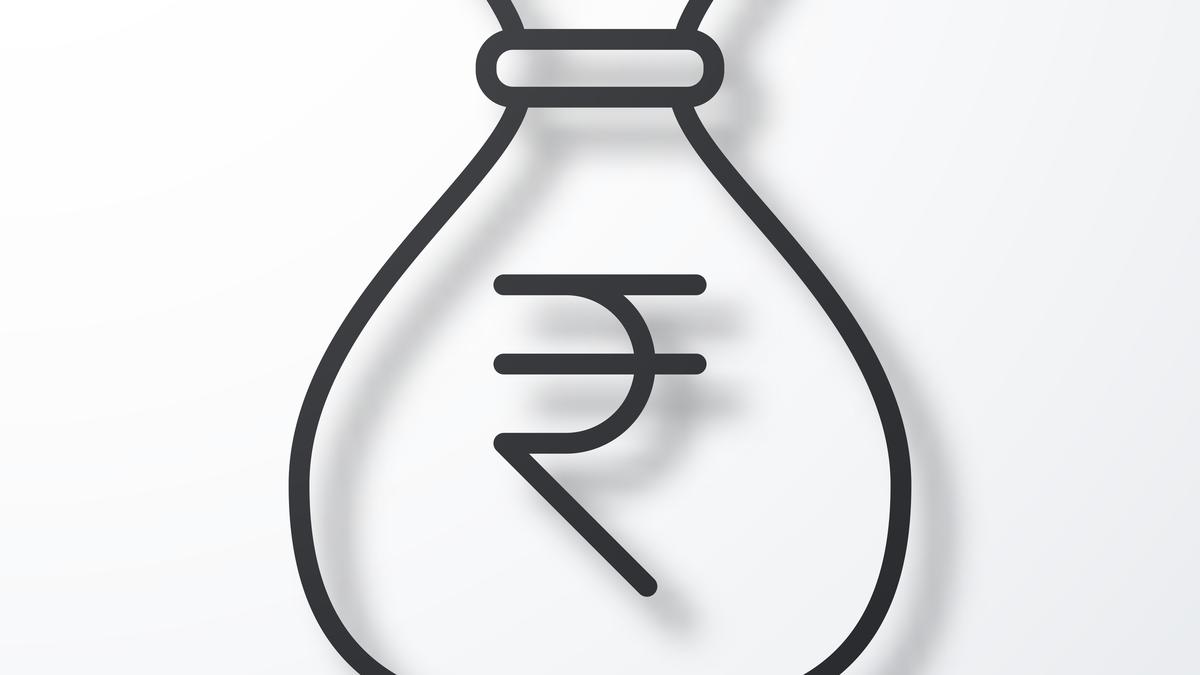
- 16 Nov 2024
In News:
- In 2023, the central government imposed a Net Borrowing Ceiling (NBC) on Kerala, limiting its borrowing capacity to 3% of the projected Gross State Domestic Product (GSDP) for the fiscal year 2023-24.
- Impact on Kerala’s Finances: This ceiling has significantly impacted Kerala’s ability to meet its expenditure needs and fund developmental activities, triggering political and legal disputes. Kerala has approached the Supreme Court of India, arguing that the imposition of NBC infringes upon its constitutional rights under Article 293 of the Indian Constitution.
Constitutional Provisions on Borrowing Powers
Article 292: Borrowing Powers of the Centre
- Central Government’s Borrowing: Article 292 grants the Central Government the authority to borrow money on the security of the Consolidated Fund of India.
- Limits on Borrowing: The extent of borrowing by the Centre is determined by laws enacted by Parliament.
Article 293: Borrowing Powers of the States
- State Borrowing: Article 293 allows State Governments to borrow within India against the Consolidated Fund of the State. However, it imposes certain conditions:
- If a State has outstanding loans or guarantees given by the Centre, the Centre’s consent is required to raise further loans.
- The Central government can impose conditions when granting such consent.
Centre’s Role in State Borrowing
- Article 293(3) allows the Centre to impose conditions on a state’s borrowing if it has existing liabilities or guarantees outstanding.
- The Centre has wide discretion in granting or denying consent, which has been a point of contention in Kerala’s case.
The Imposition of Net Borrowing Ceiling (NBC)
Scope of the NBC
- Comprehensive Coverage: The NBC encompasses all borrowing avenues, including open market loans, loans from financial institutions, and liabilities from State public accounts. To curb circumventing of the borrowing cap via State-owned enterprises, the NBC also covers borrowings by these entities.
Purpose of NBC
- Fiscal Discipline: The NBC is designed to regulate borrowing and prevent states from accumulating unsustainable levels of debt, thus ensuring financial stability.
- Transparency: By including all borrowing avenues, including off-budget borrowings by state-owned enterprises, the NBC aims to provide a clearer picture of a state’s financial health.
Arguments for the NBC
- Macroeconomic Stability: The NBC helps maintain macroeconomic stability by controlling the borrowing levels of states, thus protecting the national economy.
- Compliance with FRBM Act: The NBC aligns with the Fiscal Responsibility and Budget Management (FRBM) Act, aiming to keep the fiscal deficit within prescribed limits.
- Equitable Resource Distribution: The NBC ensures that wealthier states do not disproportionately borrow, thus promoting balanced regional development.
Arguments Against the NBC
- Erosion of Fiscal Autonomy: Critics argue that the NBC undermines the fiscal autonomy of states, as guaranteed by Article 293, by restricting their ability to make independent financial decisions.
- Impact on Developmental Activities: States, particularly Kerala, contend that the borrowing cap restricts their ability to fund key infrastructure projects and social welfare activities.
- Legal Concerns: The NBC’s impact on the interpretation of Article 293 raises legal questions regarding the extent of the Centre’s authority over state borrowing powers.
Fiscal Responsibility and Budget Management (FRBM) Act
Overview of the FRBM Act
- Objective: The FRBM Act, 2003 was enacted to promote fiscal discipline and ensure long-term financial stability in India.
- Key Features:
- Targets a 3% fiscal deficit of GDP for the Centre.
- Requires states to enact similar laws to control their fiscal deficit.
Amendments to FRBM Act
- 2018 Amendment: The FRBM Amendment Act required the central government to ensure that the fiscal deficit did not exceed 3% of GDP and total public debt remained under 60% of GDP.
- Fiscal Deficit Reduction: By 2025-26, the fiscal deficit is expected to be reduced to below 4.5% of GDP.
Way Forward: Strengthening Article 293
Guidelines for Borrowing Powers
- Transparency in Decision-Making: The Centre should ensure that the borrowing process is transparent, with clear standards and procedures for accepting or rejecting state borrowings.
- Consultative Process: The Centre should engage in consultations with states before imposing borrowing caps or conditions, fostering a cooperative federal structure.
- Equitable Treatment: Borrowing restrictions should apply uniformly to all states to avoid bias or favoritism.
Strengthening Fiscal Federalism
- Fiscal Autonomy: States should be given the flexibility to manage their finances in a way that reflects their unique economic needs and challenges.
- Periodic Reviews: The Net Borrowing Ceiling should be reviewed periodically to account for changing economic conditions and developmental priorities.
Chief Justice of India
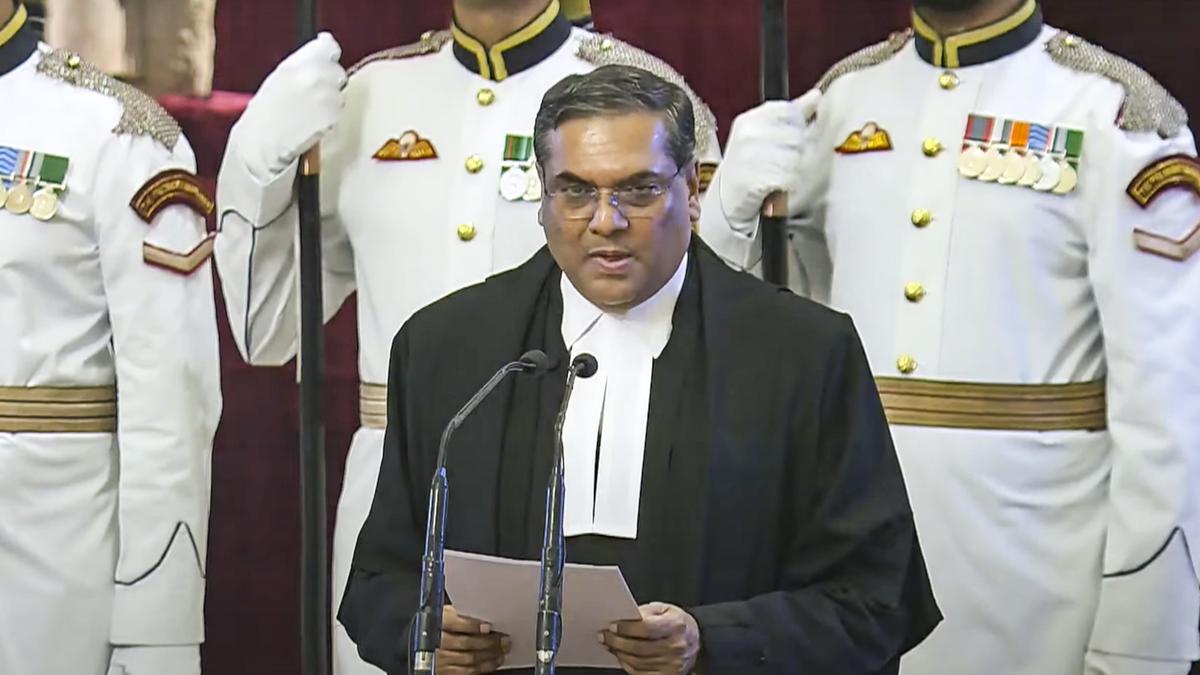
- 13 Nov 2024
In News:
On November 11, 2024, Justice Sanjiv Khanna was sworn in as the 51st Chief Justice of India (CJI) at the Rashtrapati Bhavan, New Delhi, marking a significant milestone in the Indian judiciary. He succeeds Justice D.Y. Chandrachud, who retired on November 10, 2024. Justice Khanna's term as CJI will last until May 13, 2025.
Background of Justice Sanjiv Khanna
Early Life and Legal Career
- Legal Practice: Justice Khanna began his legal career in 1983 after completing his law degree from Delhi University. He practiced in the District Courts of Delhi and handled cases in constitutional law, taxation, arbitration, and environmental law.
- Career in Delhi High Court: He was appointed as an Additional Judge to the Delhi High Court in 2005 and became a Permanent Judge in 2006.
- Appointment to the Supreme Court: Justice Khanna was appointed as a Supreme Court Judge in January 2019, without having served as a Chief Justice of a State High Court, and superseding 32 senior High Court judges.
Key Judicial Rulings of Justice Sanjiv Khanna
Major Constitutional Bench Decisions
- Abrogation of Article 370: Justice Khanna was part of the Bench that upheld the abrogation of Article 370 of the Constitution, which revoked Jammu and Kashmir’s special status.
- Electoral Bonds Scheme: He also contributed to the ruling that struck down the 2018 Electoral Bonds scheme, raising questions about the transparency of political funding.
Support for EVMs
- Justice Khanna defended the use of Electronic Voting Machines (EVMs) and rejected calls to revert to paper ballots, emphasizing the need for technological progress and institutional trust.
Personal Liberty and Bail Decisions
- Arvind Kejriwal’s Interim Bail: Justice Khanna granted interim bail to Delhi Chief Minister Arvind Kejriwal in the liquor policy case, underscoring personal liberty as a fundamental right.
- Judicial Review of Bail Conditions: He also initiated discussions on setting standards for bail conditions in cases involving significant political figures.
Role of the Chief Justice of India (CJI)
Appointment Process
- Article 124(2): A Supreme Court judge is appointed by the President of India, with the senior-most judge of the Supreme Court traditionally becoming the CJI.
- Qualifications: The CJI must be a citizen of India and have served as a judge in a High Court for at least five years or as an advocate in a High Court for ten years.
Powers and Responsibilities
- Master of the Roster: The CJI is the "Master of the Roster," responsible for assigning cases to specific benches and determining the court's schedule.
- Collegium System: The CJI, along with four senior judges, forms the Collegium that recommends judicial appointments for the Supreme Court and High Courts.
- Ad-Hoc Appointments: The CJI can also appoint ad-hoc judges to the Supreme Court under Article 127 of the Constitution.
Removal
- A CJI can only be removed through a process initiated in Parliament, requiring a special majority in both Houses of Parliament.
Appointment of CJI in Other Countries
United States
- The Chief Justice of the United States serves for life, with tenure continuing until impeachment or voluntary retirement.
United Kingdom
- The Lord Chief Justice in the UK is appointed by a special panel from the Appeal Court or the Supreme Court. The tenure is life, but mandatory retirement is set at 75 years of age.
Conclusion
Justice Sanjiv Khanna’s appointment as the 51st Chief Justice of India represents a significant moment in the country's judicial history. With his extensive experience and legal acumen, he faces numerous challenges, from dealing with case pendency to navigating sensitive constitutional issues. His tenure will likely shape the future trajectory of the Indian judiciary, with a focus on upholding justice and personal liberty while addressing the evolving needs of a democratic society.
Indus Waters Treaty (IWT)
- 08 Nov 2024
In News:
Need for modification of the Indus Waters Treaty (IWT) amidst changing geopolitical, environmental, and demographic realities.
Background of the Indus Waters Treaty (IWT)
- About IWT:
- Signed in 1960 between India and Pakistan, brokered by the World Bank.
- Governs the sharing of the Indus River system waters.
- Historical Context:
- Origin in the Inter-Dominion Accord of 1948 post-partition.
- Finalized after negotiations facilitated by the World Bank in 1951.
- Key Provisions:
- Eastern Rivers (Ravi, Beas, Sutlej) allocated to India.
- Western Rivers (Indus, Jhelum, Chenab) allocated to Pakistan, with limited use allowed for India (e.g., hydropower, irrigation).
- Establishment of the Permanent Indus Commission (PIC) for cooperation and dispute resolution.
India’s Perspective
- Rationale for Modification:
- Increased demographic and agricultural demands.
- Need for sustainable water management.
- Acceleration of hydropower projects on western rivers permitted by the treaty.
- Security Concerns: Cross-border terrorism impacting trust in treaty operations.
Pakistan’s Concerns
- Dependence on Indus System: Critical for agriculture and drinking water as the lower riparian state.
- Potential Impacts of Modification:
- Fear of reduced water availability.
- Concerns over India’s hydropower projects altering water flow.
Current Challenges
- Hydropower Projects: Disputes over compliance with treaty provisions regarding hydropower construction.
- Technical Disputes: Divergent interpretations of treaty terms.
- Political Tensions: Strained bilateral relations with minimal diplomatic engagement.
- Climate Change Impacts: Altered precipitation patterns and glacial melt affecting water availability.
Arguments for Modifying the Treaty
- Addressing Contemporary Challenges: Climate change, technological advancements, and increased water demand.
- Securing National Interests:
- Clarifications on hydropower construction.
- Improved dispute resolution mechanisms.
Risks of Modifying the Treaty
- Escalation of Tensions: Perceived unilateral actions by Pakistan.
- Political Sensitivities: Domestic opposition in both countries.
Way Forward: A Balanced Approach
- Engagement and Dialogue: Bilateral discussions with potential third-party mediation (e.g., World Bank).
- Cooperation over Conflict: Recognizing mutual benefits of collaboration in water management.
- Adaptation Measures: Incorporate provisions addressing climate change and technological advances.
Zeroing in on Methane Diplomacy, at COP29
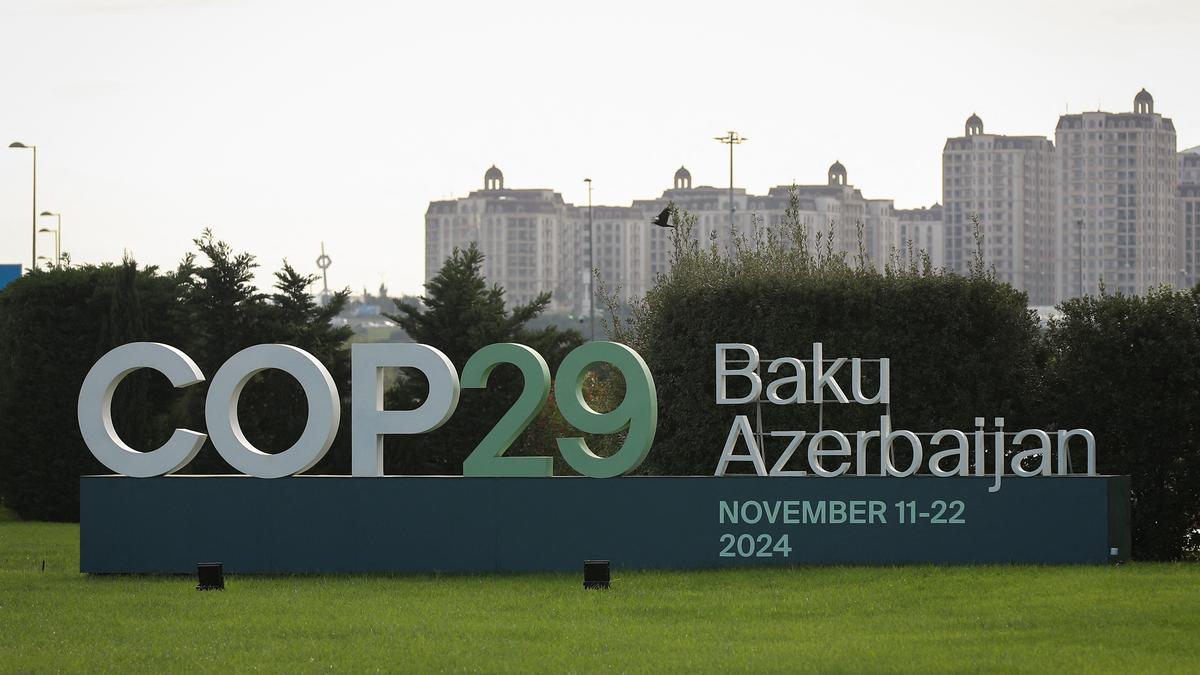
- 07 Nov 2024
In News:
From November 11 to 22, 2024, global leaders will gather in Baku, Azerbaijan, for the 29th Conference of Parties (COP29) under the United Nations Framework Convention on Climate Change (UNFCCC). This year’s summit, known as the Finance COP, will focus on setting a new global climate finance target—the New Collective Quantified Goal (NCQG).
A key focus of the summit is the reduction of methane emissions, as countries aim to curb near-term temperature increases, which buys critical time for long-term CO2 reductions necessary for stabilizing climate change.
U.S.-China Collaboration and Methane Reduction
US-China Collaboration Despite Geopolitical Tensions
Despite ongoing geopolitical tensions, the United States and China have found common ground on the issue of methane reduction. Both nations recognize the importance of addressing methane emissions, which are more potent in the short term than CO2. They, along with the United Arab Emirates, organized a summit at COP28 to discuss methane and other non-CO2 pollutants.
China’s National Plan for Methane Emissions
In November 2023, China launched its first national methane reduction plan, emphasizing capacity-building efforts over explicit reduction targets. This plan marked a significant step in China’s climate policy, underscoring its commitment to mitigating methane emissions alongside the U.S.
Given that China and the U.S. are the two largest contributors to methane emissions globally, their collaboration presents a significant opportunity for global climate mitigation efforts. India, the third-largest emitter of methane, could benefit from this partnership by seeking financial support and technical expertise to address its methane challenges.
India’s Methane Emissions Profile and Challenges
Emissions Breakdown
India’s Third Biennial Update Report to the UNFCCC indicates that in 2016, India emitted approximately 409 million tons of CO2-equivalent methane. The major sources of these emissions include:
- Agriculture: 74% (mainly from livestock and rice cultivation)
- Waste: 14% (unmanaged organic waste in landfills and dumpsites)
- Energy: 11%
- Industrial processes: 1%
Due to the dominant role of agriculture, India has been cautious about committing to stringent methane reduction targets. Initiatives like the Global Methane Pledge, which calls for a 30% reduction from 2020 levels by 2030, have not been fully embraced.
Environmental and Health Impact of Methane Emissions
Methane-related fires at waste dumpsites, such as the Bhalswa dump in Delhi (2022), have highlighted the broader environmental and health risks of methane emissions. These fires contribute significantly to air pollution, making it urgent for India to address methane in its waste management and agricultural sectors.
India’s Initiatives for Methane Reduction
Waste Management Programs
- Comprehensive Waste Management Framework India’s waste management sector is a significant source of methane, contributing 14% of the nation’s total emissions. Although a comprehensive regulatory framework for waste management has been developed, implementation remains slow due to local capacity constraints and financial limitations.
- Innovative Solutions Indore, a city in Madhya Pradesh, has pioneered waste sorting and biomethane production. The city's initiative includes:
- Sorting organic waste
- Converting it into biogas to fuel city buses
This model has gained national attention and is being considered for replication in other cities.
- GOBARdhan Scheme Launched as part of the Swachh Bharat Mission-Urban 2.0, the Galvanizing Organic Bio-Agro Resources Dhan (GOBARdhan) scheme encourages rural communities to convert cattle manure and other organic waste into biogas and compost, reducing methane emissions from livestock waste while providing additional income to rural households.
Agricultural and Livestock Emission Reduction
- National Mission for Sustainable Agriculture (NMSA) The NMSA promotes climate-resilient agricultural practices that reduce methane emissions. For example, Alternate Wetting and Drying (AWD) is a water-saving technique used in rice farming that reduces methane emissions by limiting anaerobic decomposition.
- National Livestock Mission Under the National Livestock Mission, practices such as improved fodder management, silage making, and Total Mixed Ration (TMR) feeding are being promoted. These practices reduce methane emissions from livestock by improving digestion and feed efficiency.
Opportunities for India at COP29
Leveraging U.S.-China Methane Partnership
COP29 offers India an opportunity to leverage the U.S.-China collaboration on methane reduction. By engaging with these two major emitters, India can seek:
- Financial support
- Technical assistance
- Capacity-building resources, particularly for its waste sector, which is a significant source of methane emissions.
Accurate data on methane emissions, such as satellite-based monitoring, can help India refine its emission inventories and enhance the effectiveness of its methane mitigation efforts.
Fast-Tracking India’s Methane Reduction Efforts
Although methane is not the primary focus at COP29, India has an opportunity to fast-track its efforts in methane reduction. The country's existing policies and initiatives, such as waste management programs and agricultural missions, provide a foundation upon which international collaboration can build.
Recent data from satellite monitoring in cities like Delhi and Mumbai shows that actual methane emissions from waste dumpsites may be 50%-100% higher than previously estimated, highlighting the urgency of addressing this issue.
Conclusion
Although methane may not dominate the COP29 agenda, it represents a critical pathway for India to accelerate its climate action. With the groundwork already laid through domestic policies and innovative solutions, India now requires enhanced financial and technical backing to scale up its methane reduction initiatives. By engaging proactively at COP29, India has a unique opportunity to secure the resources needed to tackle methane emissions, benefiting both its citizens and the global fight against climate change.
Supreme Court Ruling on Property and Redistribution
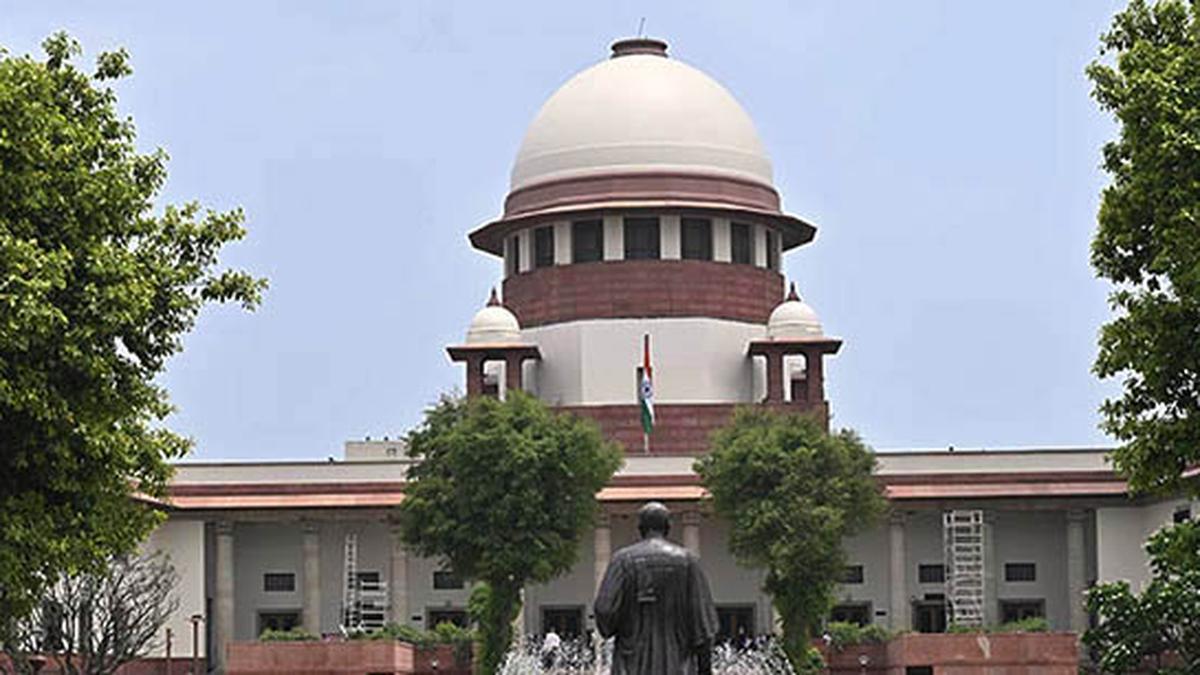
- 06 Nov 2024
In News:
A crucial 9-judge bench of the Supreme Court ruled on the scope of government powers over private property, with a focus on Articles 39(b) and 31C of the Constitution.
Key Issues Considered by the Court
- Article 31C: Whether it still protects laws giving effect to Articles 39(b) and 39(c), even after amendments and past rulings.
- Interpretation of Article 39(b): The meaning of “material resources of the community” and the limits on government acquisition.
Legal and Constitutional Background
- Article 31C and 39(b) Overview:
- Article 31C was introduced by the 25th Amendment (1971) to protect laws related to the distribution of resources for the common good.
- Article 39(b) (Directive Principle of State Policy) mandates that resources should be distributed to best serve the common good.
- Historical Context:
- Kesavananda Bharati Case (1973): The Supreme Court affirmed the Constitution’s "basic structure," impacting the interpretation of amendments to Article 31C.
- Minerva Mills Case (1980): The Court struck down further amendments to Article 31C.
The Supreme Court’s Ruling in 2024
- Restoration of the Post-Kesavananda Position: The Supreme Court clarified that the interpretation of Article 31C is restricted, and the protection under this article applies only to laws implementing Articles 39(b) and 39(c), not all directive principles.
- On Redistributing Private Property:
- The majority opinion held that not all privately owned properties can be considered “material resources of the community” for redistribution under Article 39(b).
- The Court dismissed the broad interpretation of "material resources" used in previous rulings (e.g., Justice Krishna Iyer’s dissent in the Ranganatha Reddy case, 1977).
Dissenting and Concurring Opinions
- Justice Nagarathna’s Concurring Opinion:
- Acknowledged that certain privately owned resources could be considered material resources (e.g., forests, wetlands), but emphasized a balanced approach.
- Distinguished between personal belongings and resources that could be considered part of the public domain.
- Justice Dhulia’s Dissent:
- Argued for a broader interpretation, in line with past rulings, that private resources could be considered material resources if they served the public good.
Interpretation of Article 39(b)
- Scope of the Article:
- Article 39(b) directs the State to ensure that the ownership of material resources is distributed to serve the common good.
- It imposes a positive obligation on the State to create policies for resource distribution, but does not authorize arbitrary expropriation of private property.
- Private Property as Material Resources:
- The Court clarified that private property cannot be deemed a material resource of the community unless specific conditions are met (e.g., scarcity, public welfare implications).
- The judgment emphasized a case-by-case analysis rather than a blanket approach.
Criteria for Assessing Material Resources
The Court provided criteria to evaluate whether a private property could be considered a “material resource of the community”:
- Nature of the Resource: What is the resource’s fundamental characteristic?
- Impact on Public Welfare: Does the resource impact the common good or public interest?
- Ownership Type: Is the resource privately owned or under state control?
- Scarcity: Is the resource scarce or in finite supply?
- Concentration of Ownership: Are the resources concentrated in the hands of a few private entities?
Implications of the Ruling
- Protection of Private Property Rights: The ruling strengthens protections against arbitrary State acquisition of private property, reinforcing the constitutional safeguards for property rights.
- Economic Implications: The Court noted that India’s economic trajectory has shifted from socialism to a market-based economy, and that resource redistribution policies should reflect this change.
- Policy Shifts: The ruling marks a shift away from a socialist economic ideology towards one that emphasizes private property rights, while still considering public welfare in resource distribution.
Conclusion
- Balancing Individual Rights with Public Welfare: The ruling underscores the importance of balancing private property rights with the need for equitable resource distribution to serve the common good.
- Implications for Constitutional Interpretation: This judgment marks a pivotal moment in the interpretation of property rights in India, affirming the evolving nature of the Constitution in response to dynamic economic and social policies.
Does Data Justify Subdivision of Quotas?
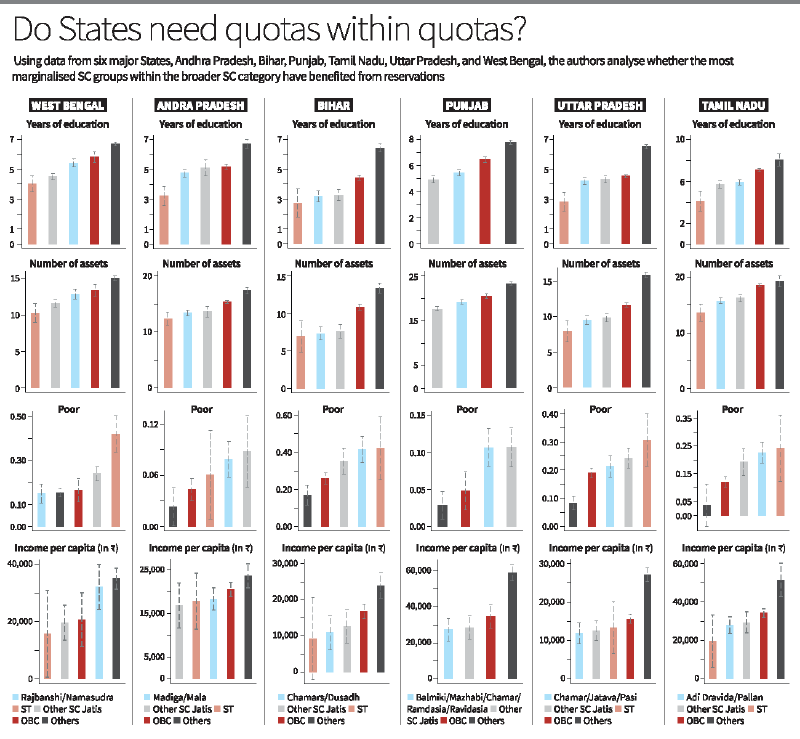
- 05 Nov 2024
Context
India's reservation system has long been a tool for uplifting historically marginalized communities, especially Scheduled Castes (SCs) and Scheduled Tribes (STs). However, recent debates have questioned whether the system serves its intended purpose, particularly in light of disparities within the SC groups. The need for a ‘quota-within-quota’ system has been raised to ensure more equitable outcomes across different SC subgroups.
The Reservation System: Origins and Objectives
Purpose of Reservations
- Historical Background: Established to correct centuries of social and economic exclusion faced by SCs and STs.
- Mechanism for Equality: Aimed to create opportunities in education, government employment, and public offices for historically marginalized groups.
- Dr. B.R. Ambedkar’s Vision: Reservations were designed to transition from formal legal equality to substantive equality.
Challenges of the Current System
- Despite progress, certain SC subgroups seem to have benefited more than others.
- A Supreme Court ruling has led to calls for a 'quota-within-quota' to address intra-SC disparities.
Exploring Intra-SC Disparities: The Data Analysis
States Examined
- Key States: Andhra Pradesh, Bihar, Punjab, Tamil Nadu, Uttar Pradesh, and West Bengal.
- Objective: To investigate whether some SC subgroups have disproportionately benefited from the reservation system.
Findings Across States
- Andhra Pradesh: Minor differences between SC groups (Malas vs. Madigas), with both groups showing similar socio-economic progress.
- Tamil Nadu: No significant disparity between Adi Dravida and Pallan groups, both benefiting equally from reservations.
- Punjab: Subdivision of quotas since 1975 has led to better outcomes for disadvantaged groups like Mazhabi Sikhs and Balmikis.
- Bihar: The Mahadalit category, introduced in 2007, failed due to political intervention, undermining the policy’s goals.
Key Insights
- In some states (e.g., Punjab), a subdivision of quotas has been effective in addressing intra-SC disparities.
- In other states, like Andhra Pradesh and Tamil Nadu, the benefits of reservations are already distributed fairly evenly among SC subgroups.
- The gap between SCs and upper-caste groups remains much larger than the gap within SCs.
The Issue of Access to Reservations
Caste Certificates as a Proxy for Access
- Data from IHDS: Less than 50% of SC households in Uttar Pradesh and Bihar report having caste certificates, limiting access to reserved positions.
- Better Access in Some States: Over 60-70% of SC households in Tamil Nadu and Andhra Pradesh have caste certificates.
Core Issue: Ensuring Access
- Access Challenges: Without proper access to caste certificates, many SCs are excluded from the benefits of the reservation system.
- Priority Area: Ensuring that all eligible SCs have access to reservations is a critical concern before considering subdivision.
The 'Quota-within-Quota' Proposal
Concept and Potential Benefits
- Targeted Assistance: A ‘quota-within-quota’ would provide more focused help to the most disadvantaged SC subgroups, as seen in Punjab.
- Political Considerations: However, the political motivations behind quota subdivision, as seen in Bihar, can undermine the policy’s effectiveness.
Criticism and Limitations
- Uneven Need for Subdivision: In many states, the need for further subdivision is minimal, as the benefits of reservations are already fairly distributed.
- Political Exploitation: The policy risks becoming a political tool rather than a genuine means of achieving social justice, as political influence often determines who is categorized as the most disadvantaged.
Addressing Inequality Beyond Reservations
Income-Based Criteria and Monetary Benefits
- Current Approach: Monetary benefits (e.g., scholarships, lower fees) are a part of the affirmative action system.
- Income Criterion: Should be used to determine eligibility for monetary benefits to focus assistance on those most in need.
The "Creamy Layer" Debate
- Supreme Court’s Suggestion: The introduction of a "creamy layer" exclusion for SCs, akin to the Other Backward Classes (OBCs) model, remains contentious and requires stronger evidence.
Challenges of Economic Mobility
- Stigma and Discrimination: Economic progress does not necessarily eliminate social stigma or discrimination, especially for historically marginalized groups.
- Long-Term Goal: While reservations have contributed to creating a Dalit middle class, addressing stigma will require a gradual process.
The Need for Updated Data and Evidence-Based Policy
Data Deficiency
- Lack of Comprehensive Data: The absence of updated, reliable data on caste-based disparities limits the effectiveness of any policy reform.
- National Census Delay: India’s national Census, the only source of comprehensive data on caste, has been delayed, exacerbating the problem.
Evidence-Driven Reform
- Importance of Data: Robust and up-to-date data is essential to assess the true impact of reservations and to make informed policy decisions.
Conclusion: Reforming the Reservation System
- Reservations’ Success: The reservation system has played a significant role in improving the socio-economic status of SCs and STs.
- Intra-SC Disparities: While some subgroups benefit more than others, the broader gap between SCs and upper-caste groups remains far more pronounced.
- Focus on Access: The primary focus should be on improving access to reservations, ensuring that all eligible SCs benefit fully from affirmative action.
Key Takeaways from COP-16: Convention on Biological Diversity
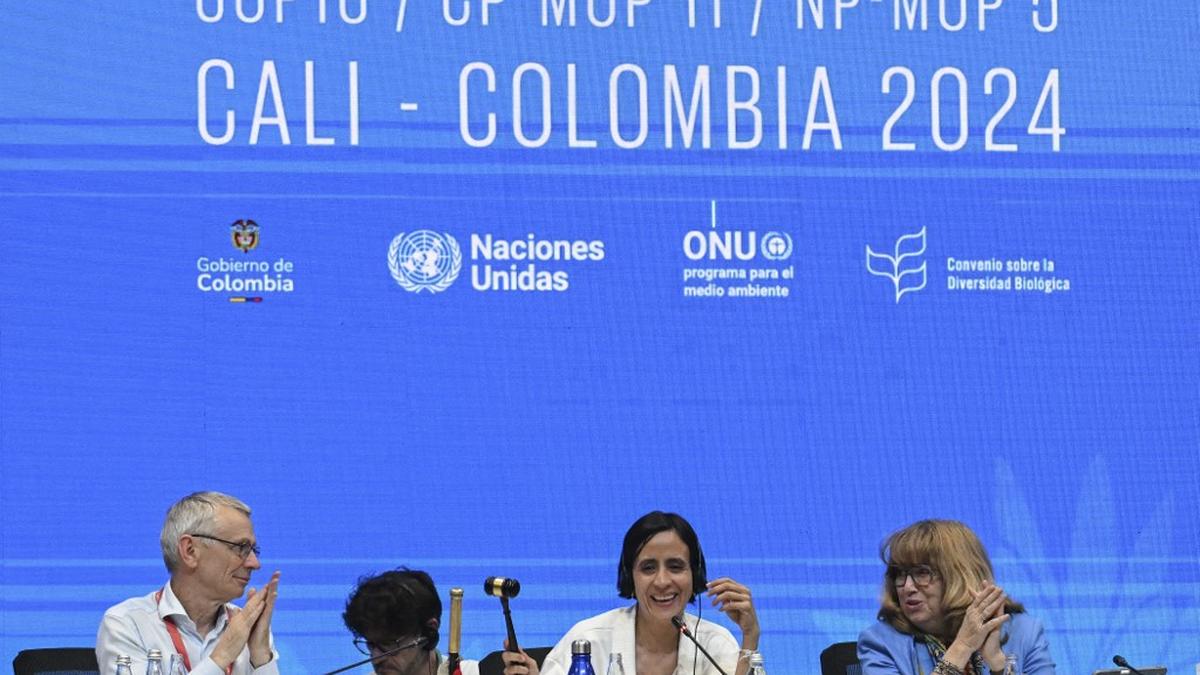
- 03 Nov 2024
In News:
The 16th edition of the Convention of Biological Diversity (CBD) in Cali, Colombia was concluded.
Key Agreements at COP-16
- Establishment of the Cali Fund
- Purpose: To ensure equitable benefit-sharing from the use of Digital Sequence Information (DSI) on genetic resources.
- Focus on Indigenous Communities: At least 50% of the Cali Fund will support Indigenous peoples and local communities, with special emphasis on women and youth.
- Creation of a Permanent Subsidiary Body
- Inclusion of Indigenous Peoples: A new body will ensure the active participation of Indigenous groups in biodiversity conservation and policy discussions.
- Resource Mobilisation Strategy
- Target Funding: The conference agreed on a strategy to secure USD 200 billion annually by 2030 to support global biodiversity initiatives.
- Kunming Biodiversity Fund: A contribution of USD 200 million from China to support biodiversity funding.
- Management of Invasive Alien Species
- New Guidelines: Proposals for databases, cross-border trade regulations, and enhanced coordination with e-commerce platforms to manage invasive species.
- Identification of Ecologically or Biologically Significant Marine Areas (EBSAs)
- Enhanced Process: COP-16 agreed on an evolved process for identifying EBSAs, a critical aspect of marine conservation.
- Global Action Plan on Biodiversity and Health
- One Health Approach: Approval of a global action plan to curb zoonotic diseases, promote health, and safeguard ecosystems.
India’s Contribution at COP-16
Updated National Biodiversity Strategy and Action Plan (NBSAP)
- Financial Commitment: India plans to invest ?81,664 crore (USD 9.8 billion) from 2025-30 on biodiversity conservation.
- Focus Areas: India highlighted efforts such as the establishment of the International Big Cat Alliance, expansion of Ramsar sites, and increased spending on biodiversity from 2018-2022.
International Finance Support
- Global Partnerships: India emphasized the need for international finance to meet biodiversity targets, particularly under the Kunming-Montreal Global Biodiversity Framework (KMGBF).
Key Outcomes from COP-16
- New Mechanisms for Biodiversity Conservation
- Cali Fund: Ensures equitable benefit-sharing from genetic resources.
- Permanent Subsidiary Body: Facilitates the inclusion of Indigenous peoples in policy-making.
- Funding and Resource Mobilization
- USD 200 Billion Annually: Strategy to secure funding for biodiversity initiatives.
- Redirecting Harmful Subsidies: Agreement to redirect USD 500 billion in harmful subsidies by 2030.
- Biodiversity and Human Health
- Global Action Plan on Biodiversity and Health: Aimed at preventing zoonotic diseases and promoting human, animal, and environmental health.
Challenges in Biodiversity Protection
Key Threats to Biodiversity
- Population Growth and Resource Demand: Increasing population and demand for biological resources lead to over-exploitation.
- Habitat Degradation and Climate Change: Destruction of ecosystems and climate change threaten species globally.
- Invasive Species: Introduction of non-native species harms local biodiversity.
- Government Policies: Policies that prioritize development without environmental safeguards contribute to biodiversity loss.
Gaps in Global Biodiversity Framework
- Weak Legal Language: Concerns about insufficient legal protection for critical ecosystems.
- Lack of Implementation Mechanisms: Absence of mandatory review mechanisms for biodiversity targets.
Kunming-Montreal Global Biodiversity Framework (KMGBF)
Framework Overview
- Adoption: Adopted at COP-15 in 2022, the KMGBF sets 23 action-oriented targets for biodiversity by 2030.
- Key Goals: Includes restoring 30% of degraded ecosystems and reducing the risk of invasive species by 50%.
- Living in Harmony with Nature: The framework envisions achieving biodiversity targets and living sustainably with nature by 2050.
Way Forward: Moving from Agreements to Action
- Participation of Stakeholders - Inclusive Approach: Ensuring the involvement of all relevant stakeholders, including governments, businesses, and local communities, in biodiversity conservation.
- Integrated Resource Management - Ecosystem Approach: Promoting a holistic approach to managing biodiversity and natural resources.
- Strengthening Governance - Good Governance Practices: Encouraging better governance to prevent unregulated exploitation of natural resources.
- International Financial Support - Alignment with Financial Institutions: Aligning global financial institutions and multilateral development banks with biodiversity conservation goals.
Tackling Judicial Pendency and Adjournments in India

- 01 Nov 2024
In News:
The issue of judicial delays and adjournments has become a significant concern in India’s judicial system. President Droupadi Murmu, while addressing the National Conference of District Judiciary in September 2024, emphasized the need to eliminate the culture of adjournments. These delays particularly affect the poor and rural populations, who often suffer in silence, avoiding court due to the fear of protracted justice.
Background of the Indian Judicial System
India’s judicial system has evolved under various legal frameworks, including the Code of Civil Procedure (CPC) and the Criminal Procedure Code (CrPC). Initially, civil courts dealt with a wide range of cases, while criminal courts focused on criminal offenses. The establishment of the Supreme Court and High Courts further strengthened India’s judicial architecture to handle constitutional and appellate cases.
To address the growing caseload, the Indian government introduced the tribunal system through the 42nd Constitutional Amendment Act, 1976, aiming to manage specialized disputes. However, despite these reforms, case pendency continues to rise.
Key Issues Contributing to Judicial Delay and Pendency
- Judge-to-Population Ratio - India currently has 21 judges per million people, far below the recommended 50 judges per million as per the 120th Law Commission Report. The shortage of judges directly contributes to the growing backlog of cases.
- Vacant Judicial Positions - As of late 2024, 30% of High Court positions remain vacant, exacerbating the case pendency crisis. The delay in filling these vacancies has resulted in overburdened judges, further delaying case resolution.
- Legislative Overload - The enactment of laws without conducting prior judicial impact assessments leads to an increase in the number of cases, often without considering the capacity of the judiciary to handle them. This lack of foresight results in excessive pressure on courts.
- Overworked Judiciary - Judges often face a heavy workload, with some handling multiple responsibilities across different courts. This overburdening leads to mental fatigue, increased errors, and prolonged decision-making.
- Witness Delays - The absence of witnesses and delays in their appearance in court can significantly prolong the judicial process, contributing to case pendency.
Government Initiatives and Challenges
-
- National Judicial Infrastructure Plan (NJIP): The NJIP aims to modernize judicial infrastructure, improving court functioning and case processing. However, its full implementation across the country remains a work in progress.
- E-Courts Project: The E-Courts project aims to digitize the judicial process, including e-filing and virtual hearings. This initiative has shown promise in reducing procedural delays but still requires wider application.
- Tribunal System: While tribunals were introduced to reduce the burden on regular courts, their success has been limited, and the abolition of six tribunals in 2021 has added additional pressure on High Courts.
- Case Timeline Legislation: Laws prescribing time-bound adjudication for sensitive cases have been enacted, but due to inefficiencies in the system, deadlines are rarely met.
Recommendations for Reform
-
- Enhance Judicial Strength
-
- Increase the Judge-to-Population Ratio: The government should prioritize the appointment of judges to meet the 50 judges per milliontargets.
- Fill Vacant Positions: High Courts should fill vacant positions six months in advance to ensure a steady supply of judges.
-
- Judicial Impact Assessment
- Implement Judicial Impact Assessments: The Justice M. Jagannadha Rao Committee’s recommendation for judicial impact assessments should be made mandatory. Every new Bill should assess the likely increase in judicial workload, the required number of judges, and the necessary infrastructure.
- Promote Alternative Dispute Resolution (ADR)
-
- Encourage ADR Mechanisms: Mediation and arbitration should be promoted as cost-effective alternatives to court proceedings. Public awareness campaigns and legal reforms can encourage the use of ADR.
-
- Strengthen Infrastructure and Technology
- Modernize Court Infrastructure: The judiciary should invest in technology such as e-filing and virtual hearings to reduce administrative burdens and expedite case resolutions.
- Streamline Administrative Processes: Technology can also help automate administrative tasks, thereby reducing the workload on judges and speeding up case processing.
- Limit Adjournments
- Stricter Norms for Adjournments: Judicial bodies should enforce stricter norms for granting adjournments, ensuring that they are not used excessively.
- Oversight Mechanism: An independent body can monitor the frequency of adjournments and take corrective action if needed.
Conclusion
Addressing the issue of judicial adjournments and case pendency requires a comprehensive approach involving structural reforms, better resource allocation, and the adoption of technology. Strengthening the judiciary’s infrastructure, increasing judicial appointments, and promoting alternative dispute resolution are vital steps toward ensuring quicker, fairer justice. The collaborative efforts of the judiciary, government, and society at large are essential to ensuring that India’s judicial system can meet the demands of justice in a timely and efficient manner.
Analysis of Election Expenditure in India

- 30 Oct 2024
Overview
Election expenditure has become a pressing issue in modern democracies, with growing concerns about its implications for political integrity and fair competition. In India, the skyrocketing costs of elections—both in terms of candidate spending and political party expenditure—pose significant challenges to electoral transparency, governance, and equity.
Current State of Election Expenditure in India
The total expenditure on elections in India has risen dramatically in recent years. For the 2024 Lok Sabha elections, the total expenditure by various political parties is estimated to reach around ?1,00,000 crores. This is a significant jump from the ?9,000 crores spent in the 1998 general elections. The expenditure per vote has also risen substantially, from ?25,000 in 1951 to ?1,400 in 2024.
The election expenditure limits for individual candidates are capped by the Election Commission of India (ECI):
- ?95 lakh for larger states (Lok Sabha constituencies)
- ?75 lakh for smaller states
- ?40 lakh for legislative assembly elections in larger states
- ?28 lakh for smaller states
However, these caps apply only to individual candidates. Political parties are not subject to any expenditure limits, allowing them to spend unlimited amounts during campaigns. This discrepancy leads to considerable financial disparities between well-funded national parties and regional or smaller parties, undermining the principle of equitable competition.
Global Comparisons: Election Financing and Spending Limits
Election financing varies widely across democracies, with countries like the United States and the United Kingdom adopting specific limits and regulations to curb excessive spending.
- United States: U.S. elections are financed largely through contributions from individuals, corporations, and Political Action Committees (PACs). Notably, Super PACs—which can raise and spend unlimited funds—have exacerbated concerns over money's influence on political outcomes. The 2024 U.S. presidential election is expected to cost around $16 billion (approximately ?1,36,000 crores).
- United Kingdom: Political parties are subject to strict expenditure limits. Each political party is allowed to spend £54,010 for each constituency, with an overall cap of £35 million for contests across all constituencies. This is aimed at ensuring that elections are not swayed by wealth alone and that smaller parties have a fighting chance.
Despite these measures, the United States still faces issues with unlimited corporate donations and the growing influence of wealthy donors, highlighting the complexities in curbing money in politics.
Challenges Posed by Rising Election Expenditure
The rising costs of elections present multiple challenges in India, exacerbating corruption, unfair competition, and political inequality.
a) Political Corruption and Influence
Large election expenditures are often funded by corporate donations and other private entities, creating a nexus between politicians and donors. This can lead to a quid-pro-quo relationship, where politicians may prioritize the interests of their donors over public welfare. This undermines public trust in the political system.
b) Unaccounted Money and Illegal Practices
A significant portion of the election expenditure is unaccounted for. The Centre for Media Studies (CMS) reports that in the 2019 general elections, around 25% of the total expenditure was spent on illegally distributing cash to voters. This practice, coupled with the absence of strict regulations on third-party campaigners, enables the use of black money in elections, further skewing the electoral process.
c) Uneven Playing Field
The absence of limits on party spending creates a situation where well-funded national parties have an inherent advantage over smaller regional parties and independent candidates. This financial inequality reduces the ability of under-funded candidates to compete based on ideas and merit rather than financial muscle. Furthermore, the growing influence of digital advertising and media campaigns has further widened this gap, with larger parties investing heavily in digital platforms like Google and Facebook, marginalizing those without the resources to do so.
Proposed Reforms to Address Election Expenditure Issues
To address these challenges, several reforms have been suggested by experts, committees, and the Election Commission. These reforms aim to curb excessive spending, ensure fairness, and increase accountability in the electoral process.
a) Capping Expenditure by Political Parties
There is a pressing need to introduce expenditure ceilings for political parties, in addition to those imposed on individual candidates. According to the 2016 Electoral Reforms Report by the Election Commission, political party spending should be capped at a level not exceeding the total expenditure limit for all candidates fielded by the party. This would level the playing field, ensuring that the influence of money is curtailed during elections.
b) State Funding of Elections
Recommendations for state funding of elections have been made by the Indrajit Gupta Committee (1998) and the Law Commission Report (1999). The state could partially finance the campaigns of recognized political parties, ensuring that candidates are not solely reliant on private donations. However, this reform faces challenges in terms of feasibility and implementation, especially regarding the mechanism for allocation of funds.
c) Regulation of Third-Party Campaigners
India should follow the example of countries like Australia, where third-party campaigners are formally registered and required to disclose their funding sources. This would help in tracking illegal contributions and ensure that election spending is transparent.
d) Ban on Government Advertisements During Election Periods
The use of government advertisements by the ruling party during the run-up to elections often leads to an uneven playing field. A ban on government-funded ads during the six months before elections would ensure that the ruling party does not gain an unfair advantage through public resources.
e) Strengthening Electoral Oversight
An independent electoral oversight body could be established to oversee campaign financing and ensure that all parties comply with spending limits. This would include measures to audit party finances, track donations, and verify spending claims, making it more difficult for parties to evade rules or use black money.
Conclusion: The Need for Comprehensive Electoral Reforms
The rising costs of elections in India present significant challenges to the democratic process. While expenditure limits for candidates exist, the lack of restrictions on party spending creates financial inequalities that undermine fair competition. The increasing role of corporate donations, illegal cash distribution, and unregulated third-party spending further complicates the situation.
To ensure fair elections, it is crucial that India adopts reforms such as capping political party expenditures, state funding of elections, and stronger oversight mechanisms. These steps, coupled with bipartisan political will, could help create a more equitable, transparent, and accountable electoral system, fostering greater public trust in the democratic process.
By addressing these challenges head-on, India can work toward an election system that encourages political participation based on ideas and policies rather than financial clout, ultimately strengthening the foundations of democracy.
Analysis of Growing Economic Divide in India

- 29 Oct 2024
Overview
The Economic Advisory Council to the Prime Minister (EAC-PM)'s report titled "Relative Economic Performance of Indian States: 1960-61 to 2023-24" highlights an alarming trend of widening economic disparities across India's states, which is increasingly threatening the principles of federalism and national unity. The findings reveal significant regional imbalances in terms of contributions to the national income, per capita income, and overall economic development. This analysis delves into the key insights from the report and explores the broader implications for India's federal structure, governance, and policy approaches.
Key Insights from the Report
- Regional Economic Disparities:
- Western and Southern States' Dominance: States such as Maharashtra, Gujarat, Tamil Nadu, and Karnataka have consistently outperformed others. These states have benefited from higher private investments, better infrastructure, and a more business-friendly environment. They also enjoy proximity to international markets, especially coastal regions like Gujarat and Tamil Nadu, which have access to ports and export markets.
- Underperformance of Northern and Eastern States: On the other hand, northern states (with exceptions like Delhi and Haryana) and eastern states like Bihar, Odisha, and West Bengal lag behind in economic performance. These regions face challenges such as poor infrastructure, low levels of investment, and weak governance structures, which hinder their growth potential.
- Impact of Liberalization (1991):
- The 1991 economic reforms marked a shift toward market-oriented growth, benefiting states that were already more industrialized or had better urban infrastructure. Southern states, in particular, adapted well to the liberalized environment, attracting higher levels of private investment and expanding their economies.
- The liberalization process disproportionately favored urban centers like Delhi, Mumbai, Chennai, and Bengaluru, where investments were channelized into growing service sectors, technology, and industries, creating a feedback loop of wealth accumulation in these hubs. Meanwhile, the hinterland remained underdeveloped due to insufficient public investment and the lack of private sector interest in these regions.
- Investment Disparities:
- Private Investment: Wealthier states attract a disproportionate share of private investment, which is driven by profitability and market opportunities. These states have better infrastructure, which reduces transaction costs and increases returns on investment. In contrast, underdeveloped states struggle to attract investment due to poor governance, inadequate infrastructure, and perceived higher risks.
- Public Investment: While the public sector still plays a role in investment, the New Economic Policies (NEP) since 1991 have shifted the focus towards private sector-driven growth. This has further widened the investment gap, as the poorer states receive less public investment relative to their needs.
- Role of Infrastructure and Governance:
- The availability and quality of infrastructure are significant determinants of economic performance. States with better roads, energy supply, ports, and communication networks tend to attract more investments. Additionally, good governance, characterized by reduced corruption, better policy implementation, and transparency, also plays a critical role in fostering economic development.
- In contrast, states with weaker governance structures and poor infrastructure struggle to create an enabling environment for businesses, further compounding regional disparities.
- Impact on Federalism:
- The growing economic divide is leading to tensions between the Centre and state governments, particularly in wealthier states that contribute significantly to national income but feel short-changed in resource allocation. These states argue that they are not receiving a fair share of national resources in return for their contributions, leading to growing dissatisfaction with the federal system.
- The tension is exacerbated by political factors, such as accusations from opposition-led states that the Centre uses public investment to favor states aligned with the ruling party. The growing perception of politicization of resource allocation has the potential to undermine the spirit of cooperative federalism.
Structural Causes of Regional Inequality
- Economic and Investment Magnetism:
- Wealthier states attract more private investments, as they offer better returns due to established markets, skilled labor, and urbanization. Cities like Mumbai, Delhi, and Bengaluru serve as economic magnets, drawing talent, technology, and capital, which further consolidates their economic dominance.
- In contrast, states without such economic hubs or access to global markets struggle to attract investment. The absence of urban agglomerations and the concentration of wealth and resources in a few states perpetuate regional disparities.
- Policy and Investment Bias:
- Post-liberalization policies have disproportionately benefited the organized sector, often at the expense of the unorganized sector, which is more prevalent in poorer states. The emphasis on industrial growth and infrastructure development has largely bypassed the rural and informal sectors, which are critical in underdeveloped states.
- The organized sector has also benefited from government support, such as tax concessions and subsidized infrastructure, which have enabled these industries to thrive in already developed regions. This has widened the gap between the haves and the have-nots.
- Cronyism and the Black Economy:
- Crony capitalism and the prevalence of the black economy in poorer states further exacerbate regional imbalances. In some cases, political patronage and corruption divert resources and investments from areas that need them most. This weakens the investment climate, especially in states with higher levels of informal and illegal economic activity.
Implications for Federalism
The growing economic disparity poses a serious threat to India's federal structure. The increasing dissatisfaction of wealthier states with the current fiscal arrangements and the growing demand for fairer resource allocation challenge the spirit of cooperative federalism. A well-functioning federal system relies on equitable distribution of resources and opportunities for all regions to develop.
Policy Recommendations
To address these disparities and strengthen India's federal framework, several policy measures need to be implemented:
- Enhancing Governance and Infrastructure in Lagging States:
- Improved governance and reducing corruption are essential in attracting both private and public investments. Additionally, there must be a focus on developing critical infrastructure, such as roads, energy, and health facilities, which are essential for economic growth.
- States need to increase public investment in sectors like education, healthcare, and social security to improve human capital and productivity.
- Focus on the Unorganized Sector:
- A significant portion of the labor force in poorer states is employed in the unorganized sector. Policies should aim to formalize this sector by providing social security benefits, improving labor rights, and increasing productivity through skill development. This could help raise incomes and stimulate local demand, attracting more private investment.
- Balancing the Organized and Unorganized Sectors:
- While the organized sector has benefited from liberalization, more attention should be given to the unorganized sector, which forms the backbone of the economy in many poorer states. A balanced approach to economic growth, which includes both organized and unorganized sectors, can help reduce disparities.
- Shifting Focus from Urban Centers to Hinterlands:
- Private sector investment must be incentivized in underdeveloped regions through tax breaks, subsidies, and targeted infrastructure projects. This will encourage businesses to expand beyond the major urban centers, thus promoting a more balanced distribution of economic activities.
Conclusion
The widening economic divide in India, as revealed by the EAC-PM report, poses a significant challenge to the country's federalism and unity. To ensure inclusive and balanced development, policy reforms must focus on reducing regional disparities by improving governance, infrastructure, and investment in lagging states. A shift towards equitable growth, addressing the needs of both the organized and unorganized sectors, is essential to promoting national cohesion and ensuring sustainable economic progress across all regions.
Strengthening the Anti-Defection Law to Uphold India's Democratic Integrity

- 28 Oct 2024
In News:
The Anti-Defection Law, introduced in 1985 through the 52nd Constitutional Amendment, aims to curb political instability caused by legislators switching parties for personal or financial reasons. While the law has helped maintain political stability, it faces several challenges, including delays in decision-making, potential bias in adjudication, and lack of transparency in party directives. These issues undermine its effectiveness in safeguarding democratic integrity.
Historical Context and Genesis
The issue of political defections, exemplified by the term "Aaya Ram, Gaya Ram," traces its origins to the 1960s when frequent party-switching destabilized governments. To address this, the Anti-Defection Law was enacted in 1985, disqualifying members who voluntarily gave up their party membership or defied party whips on critical votes. Initially effective in reducing defections, the law has faced challenges due to emerging loopholes, particularly regarding party "splits" and "mergers."
Gaps and Loopholes in the Current Law
One major loophole was the provision allowing a party split if one-third of its members defected, exploited until the 91st Amendment in 2003, which increased the threshold for mergers to two-thirds. Despite this change, defections continue, particularly through "mergers." Another issue is the role of the Speaker in deciding disqualification petitions. Given that the Speaker is often affiliated with the ruling party, their decisions are sometimes seen as biased, leading to delays in resolving defection cases. Additionally, the lack of transparency in issuing party whips has caused disputes regarding their legitimacy.
Proposed Reforms
To address these challenges, two key amendments are proposed:
- Fixed Time Frame for Decision-Making: A clear time frame—such as four weeks—should be established for the Speaker or an adjudicatory body to resolve defection cases. If no decision is made within this period, defecting members should automatically be disqualified.
- Transparency in Whips: Political parties should be required to make the issuance of whips public, either through newspaper publications or electronic communication, to ensure that members are fully informed of party positions on critical votes.
Ethical Concerns and Impact on Democracy
While the Anti-Defection Law was introduced to promote political stability, it has inadvertently stifled internal dissent within parties. Legislators are often forced to follow party lines, even when their personal convictions or constituents' interests conflict. This limits their freedom of expression and undermines the representative nature of democracy. Furthermore, the law has not fully curbed unethical practices such as "poaching" of members or defectors seeking personal gain, which continue to destabilize governments and erode public trust in the system.
The Way Forward: Political Will and Comprehensive Reforms
To strengthen the Anti-Defection Law, reforms must balance party discipline with individual freedoms. Key steps include:
- Independent Adjudication: Establishing an independent tribunal to handle defection cases can reduce political bias and expedite the decision-making process.
- Clear Timeframes: Setting a fixed timeline for resolving defection cases will prevent delays and ensure accountability.
- Transparency in Whip Issuance: Ensuring public notice of party whips will reduce ambiguity and disputes.
- Promoting Ethical Conduct: Strengthening ethical guidelines to discourage "poaching" and protect the integrity of the electoral process.
16th BRICS Summit
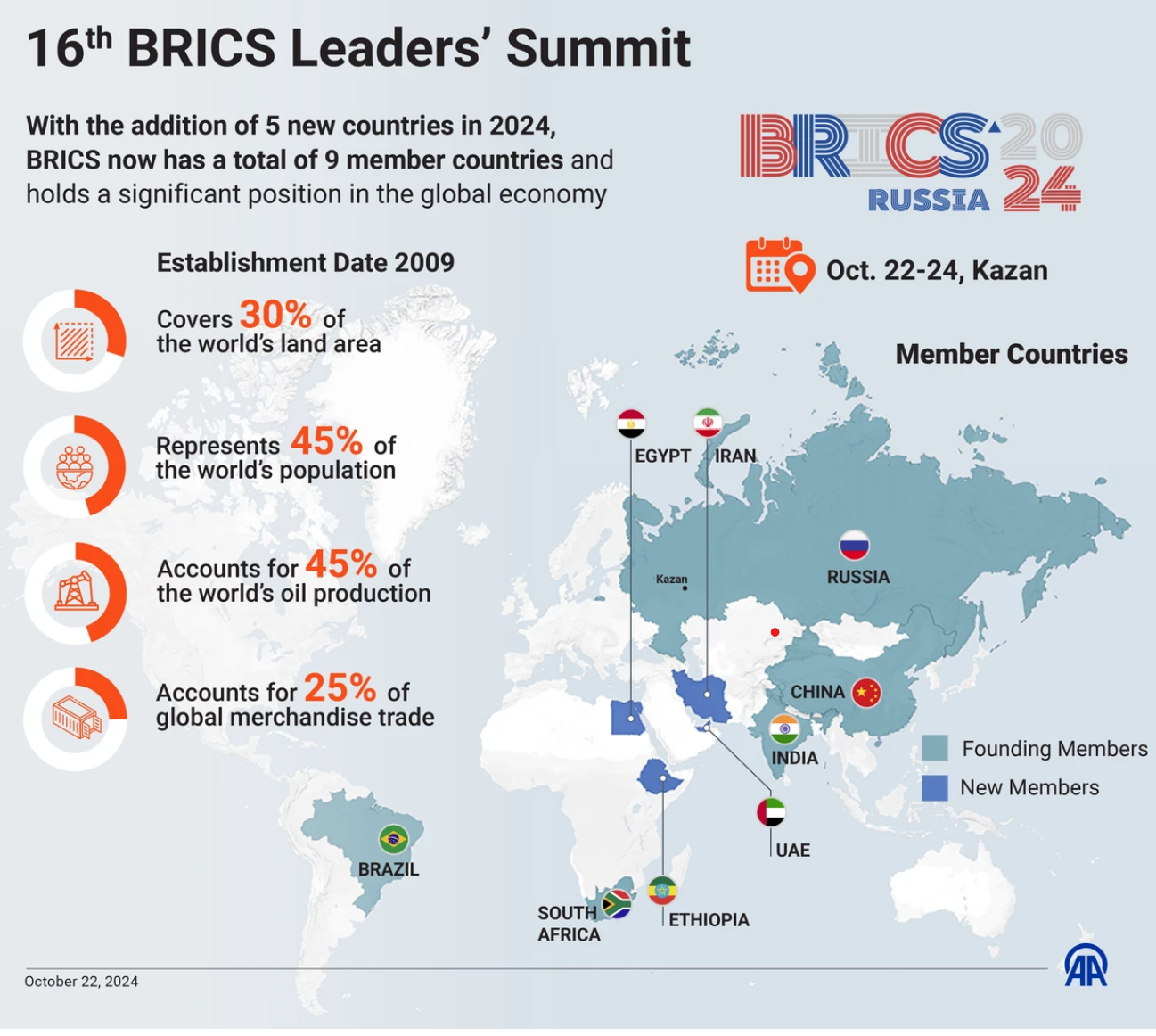
- 25 Oct 2024
In News:
Recently, the 16th BRICS Summit was held in Kazan, Russia.
Key Highlights:
Overview of the Bilateral Meeting between PM Modi and President Xi
- Location & Context: The meeting took place on the sidelines of the 16th BRICS Summit in Kazan, Russia (October 23, 2024), marking the first bilateral interaction between PM Modi and President Xi Jinping in nearly five years.
- Significance: The meeting focused on India-China relations, specifically the border dispute that arose following the 2020 standoff in Ladakh.
- Agreement on Border Disengagement: Both leaders welcomed an agreement for "complete disengagement" along the Line of Actual Control (LAC), which could pave the way for the resolution of issues that emerged after the Galwan Valley clashes in June 2020.
Key Points of the India-China Border Pact
- Resolution of Border Issues: The agreement addresses longstanding disputes, including in Depsang Plains and Demchok, where Chinese forces had encroached on Indian territory.
- Restoration of Patrolling: Both nations agreed to restore patrols to old patrolling points (PPs) along the LAC in these disputed areas.
- Next Steps: The Special Representatives (SRs) on the India-China boundary will meet soon to oversee the management of peace and tranquility in the border areas and explore mutually acceptable solutions.
- Diplomatic Mechanisms: Dialogue mechanisms at the foreign ministers and other official levels will be utilized to stabilize and rebuild bilateral relations, contributing to regional and global stability.
Strategic Importance of the Bilateral Meeting
- Maintaining Peace and Stability: PM Modi emphasized that differences between India and China should be managed carefully to ensure that broader peace and tranquility are maintained.
- Global Impact: Both leaders affirmed that stable India-China relations would have a positive impact on regional and global peace and contribute to a multipolar world.
- Long-Term Strategic Perspective: The leaders discussed progressing bilateral relations from a strategic perspective, enhancing communication, and exploring cooperation to address developmental challenges.
Key Takeaways from the 16th BRICS Summit
- Expansion and New Membership: The summit saw the inclusion of five new members—Egypt, Ethiopia, Iran, the UAE, and Saudi Arabia (pending formalization). This expansion reflects BRICS’s growing influence as a forum representing the Global South.
- Focus on Multilateralism: Leaders emphasized multilateral cooperation to address challenges such as global security, economic growth, and sustainable development.
- Kazan Declaration: The declaration touched upon key issues:
- Geopolitical Conflicts: It called for dialogue and diplomacy to resolve disputes like the Ukraine crisis and the West Asia conflict.
- Sanctions and Trade: Criticized unilateral sanctions and their disruptive effects on global trade and development goals.
- Grain Exchange: A proposal was made to establish a BRICS Grain Exchange, aimed at improving agricultural trade among member states.
- Financial Integration: There was a push for greater financial integration through the use of local currencies for trade, exemplified by India’s UPI system as a successful model.
Importance of BRICS in the Global Context
- Global Influence: BRICS continues to be a key player in global geopolitics, representing 40% of the world’s population and 26% of global GDP (as of 2023).
- Strategic Goals: BRICS has consistently called for reform of international institutions like the UNSC, IMF, and World Bank, advocating for a more equitable global governance structure.
- Economic Collaboration: The New Development Bank (NDB), established in 2015, continues to play a vital role in funding development projects across BRICS countries, though the group’s influence in global finance remains limited compared to the World Bank.
Challenges Facing BRICS Expansion
- Geopolitical Contradictions: The inclusion of diverse new members (e.g., UAE, Egypt, Iran) could complicate decision-making due to geopolitical rivalries.
- Decision-Making Hurdles: Achieving consensus among an expanding membership will become more challenging. The expansion may dilute the cohesiveness of the group, as seen in other multilateral forums like the Non-Aligned Movement (NAM) and G77.
- De-Dollarisation Efforts: While BRICS aims to de-dollarize trade and reduce reliance on the SWIFT system, efforts to develop alternatives like a BRICS payment system and BRICS currency are still in nascent stages.
- Economic Disparities: Economic gaps among members—China’s GDP is significantly larger than the combined GDP of other members—could also create imbalances in decision-making.
India’s Role and Strategic Positioning in BRICS
- Geopolitical Balancing: India's participation in BRICS is a strategic maneuver to balance its global position and strengthen ties with emerging economies, particularly in the Global South.
- Diplomatic Relations with Russia: India continues to prioritize its relationship with Russia, which remains crucial for regional security and energy cooperation.
- India-China Ties: The agreement on the India-China border represents a significant shift in relations, with potential for a reset in Sino-Indian ties.
Key Themes in the Kazan Declaration
- Global Governance: Calls for reforming global institutions to give developing nations more representation.
- Energy and Sustainability: Proposals for strengthening energy cooperation, including the creation of energy corridors and the promotion of sustainable energy practices.
- Security: Emphasized the need for universal security by addressing the security concerns of all nations and promoting dialogue over confrontation.
Conclusion: Future of India-China and BRICS Relations
- India-China Relations: The border disengagement pact is a critical step towards stabilizing the India-China relationship, with potential positive impacts on regional security and global geopolitics.
- BRICS’s Growing Influence: As BRICS expands, it faces internal challenges but remains a potent voice for the Global South, aiming to reshape global governance and financial systems.
- India’s Strategic Positioning: India is likely to play a pivotal role in BRICS, especially as the group’s focus shifts towards regional stability, economic cooperation, and de-dollarization in the coming years.
Stubble Burning and the Supreme Court's Ruling: Protecting the Right to a Pollution-Free Environment
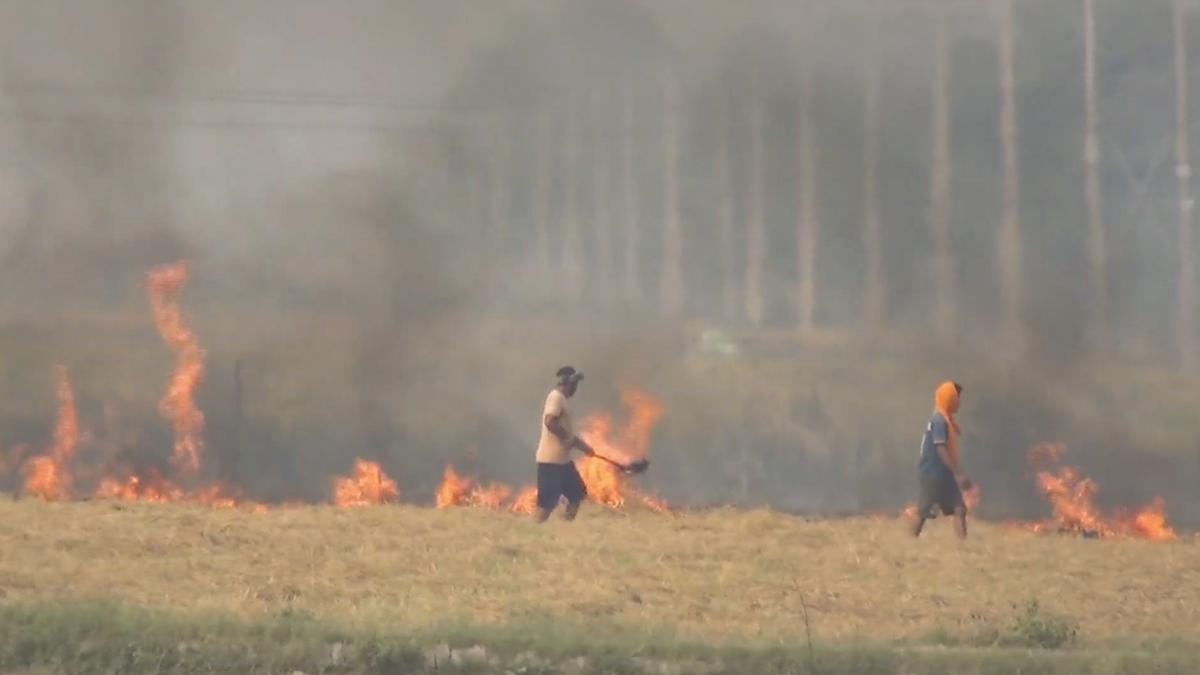
- 24 Oct 2024
Introduction
Recently, the Supreme Court of India expressed serious concerns about the ongoing issue of stubble burning in the states of Punjab and Haryana. The Court criticized the selective enforcement of penalties for stubble burning and emphasized that such practices violate citizens' fundamental right under Article 21 of the Indian Constitution, which guarantees the right to live in a pollution-free environment.
Court’s Observations on Stubble Burning
- The Supreme Court highlighted the failure of state governments in effectively implementing laws against stubble burning.
- Selective Enforcement: The Punjab and Haryana governments were accused of prosecuting only a few violators while allowing many others to escape punishment by paying a nominal fine.
- The Court observed that this approach is a blatant violation of the right to live in a pollution-free environment, which is guaranteed under Article 21 of the Constitution.
Right to a Pollution-Free Environment
- The Court emphasized that every citizen has the fundamental right to live in an environment free from pollution, as mandated by Article 21 of the Constitution.
- The Court questioned the effectiveness of current environmental regulations, specifically pointing out the lack of proper machinery to collect fines under Section 15 of the Environment (Protection) Act, 1986.
Impact of Stubble Burning
Stubble burning, primarily in the northern states of India, exacerbates air pollution, especially in Delhi and surrounding regions. The seasonal spike in air pollution during the months of October and November is largely attributed to farm fires. This not only worsens the air quality but also has severe implications for public health.
Environmental and Health Consequences
- Air Pollution: The burning of crop residues significantly contributes to the rise in PM2.5 and PM10 levels, leading to hazardous air quality.
- Soil Health: Burning crop residues depletes essential nutrients from the soil, reducing organic carbon content and harming soil fertility.
Health Risks
- Exposure to pollutants like particulate matter (PM) can lead to respiratory problems, heart diseases, and other health complications for the population, especially in densely populated areas like Delhi.
Legal and Institutional Shortcomings
- Inadequate Implementation: Despite laws and penalties being in place, the lack of an effective enforcement mechanism has resulted in the persistence of stubble burning.
- Toothless Penalties: The Supreme Court criticized the amended Section 15 of the Environment Protection Act, 1986, which replaced criminal penalties with financial fines for environmental violations. However, the lack of rules and appointed adjudicating officers has rendered this provision ineffective.
- No Serious Enforcement: The failure of the Central government and state authorities to implement effective penalties has led to widespread non-compliance with environmental laws.
Government Actions and Responses
Centre’s Efforts:
- The Central Government has introduced a Central Sector Scheme to promote agricultural mechanization for in-situ management of crop residue in Punjab, Haryana, Uttar Pradesh, and Delhi.
- The government provides financial assistance of up to 50% for the purchase of machinery, such as the Happy Seeder, to manage paddy stubble without burning.
- A total of ?3,062 crore has been released from 2018 to 2023 to tackle stubble burning.
State-Level Actions:
- The Punjab government has introduced cash incentives for farmers who refrain from burning stubble. Additionally, the state is offering non-fiscal incentives, such as access to panchayat land for storing paddy straw.
- The Pusa Decomposer, developed by the Indian Agricultural Research Institute (IARI), is a bio-enzyme used to decompose crop residue. It helps in turning the stubble into manure within 20-25 days, enhancing soil health.
Challenges for Farmers:
- Many farmers still prefer burning stubble due to high costs associated with alternative methods of residue management.
- The Happy Seeder and other machinery remain expensive and are not affordable for most small-scale farmers, leading them to resort to burning as the most cost-effective option.
Court’s Directive and the Way Forward
- The Supreme Court directed the Centre and state governments to ensure better enforcement of laws related to air pollution, vehicular emissions, and industrial pollution.
- The Court also urged the Union Government to consider Punjab’s request for additional funds to tackle the stubble burning issue and to strengthen the enforcement mechanism.
- Urgency for Action: The Court’s observations suggest that the existing framework needs urgent reforms to protect citizens’ right to a pollution-free environment.
Constitutional Provisions Related to Environmental Protection
India’s Constitution provides several provisions to ensure the protection of the environment:
Article 21: Right to Life and Environment
- In the landmark case Subhash Kumar v. State of Bihar (1991), the Supreme Court held that the right to life under Article 21 includes the right to a wholesome environment.
- This view was reiterated in Virender Gaur v. State of Haryana (1994), further strengthening the legal framework for environmental protection.
Directive Principles of State Policy
- Article 48A: The State is mandated to protect and improve the environment and safeguard forests and wildlife.
- Article 39(e) and 47: These Articles place a duty on the State to promote public health and ensure environmental protection.
Fundamental Duties
- Article 51A(g) places a duty on citizens to preserve and protect the environment.
Conclusion
The Supreme Court’s ruling highlights the urgent need for better implementation of environmental laws and the protection of citizens’ fundamental rights under Article 21. While government schemes are in place, a more robust and consistent approach is required to address the issue of stubble burning and air pollution. Immediate reforms in the enforcement mechanisms and incentives for farmers are crucial to achieve a sustainable, pollution-free environment in India.
Biodiversity COP16
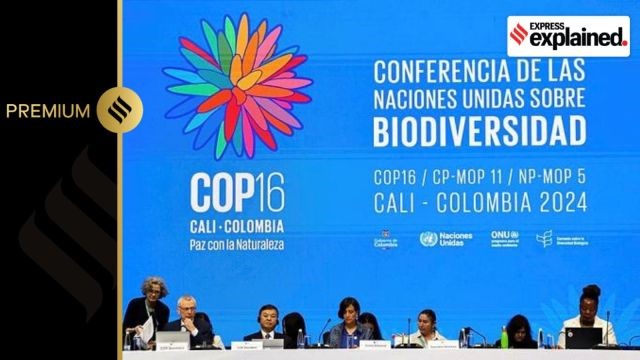
- 23 Oct 2024
In News:
The Convention on Biological Diversity (CBD), while historically overshadowed by climate change discussions, is now gaining increasing attention due to the growing recognition of the global biodiversity crisis. This evolving prominence highlights the need for urgent action to preserve ecosystems and halt biodiversity loss, which is intimately linked with the climate crisis.
Overview of the Convention on Biological Diversity (CBD)
- Origins and Objectives:
- The CBD emerged from the 1992 Rio Earth Summit, alongside the UN Framework Convention on Climate Change (UNFCCC).
- Main Goals:
- Protect global biodiversity.
- Restore ecosystems.
- Ensure equitable distribution of the benefits derived from biological resources.
- COP16 and the Kunming-Montreal Framework:
- The 16th Conference of Parties (COP16) marks the first meeting following the Kunming-Montreal Global Biodiversity Framework adopted at COP15 in 2022.
- The framework sets out four key goals and 23 targets to be achieved by 2030, including:
- Protect 30% of global lands and oceans by 2030.
- Restore 30% of degraded ecosystems by 2030.
The Growing Convergence Between Climate Change and Biodiversity
- Interlinkages Between Climate Change and Biodiversity:
- Mutual Impact:
- Climate change accelerates biodiversity loss by altering habitats and threatening species.
- In turn, ecosystem degradation contributes to climate change by releasing greenhouse gases (GHGs) from deforestation and soil degradation.
- Shared Drivers:
- Both crises are driven by unsustainable human activities, including over-exploitation of natural resources, deforestation, over-consumption, and pollution.
- Increasing Synergy:
- There is a growing realization of the need for integrated solutions that address both climate change and biodiversity loss simultaneously.
- Momentum for 30 x 30 Targets
- The 30 x 30 Commitment:
- The 30 x 30 targets are central to the Kunming-Montreal Framework, which includes:
- Conservation of 30% of the world's lands and oceans.
- Restoration of 30% of degraded ecosystems.
- These targets aim to ensure the preservation of biodiversity-rich areas and the restoration of degraded ecosystems globally by 2030.
- National Biodiversity Strategies and Action Plans (NBSAPs):
- Countries are required to develop and submit their NBSAPs (akin to Nationally Determined Contributions (NDCs) for climate change).
- As of now, only 32 countries have submitted their NBSAPs, with more expected during COP16.
- High Seas Treaty:
- A crucial agreement for achieving 30 x 30 targets is the High Seas Treaty (also called Biodiversity Beyond National Jurisdictions (BBNJ)), which focuses on:
- Establishing protected marine areas in biodiversity-rich regions beyond national jurisdictions.
- Ensuring regulation of human activities in these areas.
Access and Benefit Sharing: The Case of Genetic Resources
- Genetic Resources and Their Exploitation:
- The oceans, along with terrestrial ecosystems, harbor a wide variety of genetic resources that can be exploited for medical, commercial, and scientific purposes.
- Advances in biotechnology and digital sequencing of genetic material have raised issues about the equitable sharing of benefits from these resources.
- Nagoya Protocol and Benefit Sharing:
- The Nagoya Protocol (2010) set out guidelines for the access and fair sharing of benefits derived from genetic resources.
- At COP16, discussions will center on how genetic sequences (used in products such as medicines, crops, etc.) can be used fairly, ensuring that indigenous communities, who may be the original custodians of these resources, benefit equitably.
Finance Mechanisms for Biodiversity Conservation
- Financial Targets:
- One of the key goals of the Kunming-Montreal Framework is to mobilize $200 billion per year by 2030 for biodiversity conservation globally.
- Developed countries are expected to contribute $20 billion annually to developing nations, increasing to $30 billion by 2030.
- Phasing Out Harmful Subsidies:
- Countries are urged to eliminate perverse incentives that harm biodiversity, such as subsidies for:
- Over-fishing.
- Deforestation.
- Fossil fuel consumption.
- The goal is to repurpose such incentives to support sustainable practices and conservation efforts.
- New Financial Mechanisms:
- COP16 discussions will also focus on creating innovative financial mechanisms, such as:
- A biodiversity fund.
- Biodiversity credits, similar to carbon credits, which would allow countries or organizations to offset their biodiversity loss by investing in conservation projects elsewhere.
Challenges and the Way Forward
- Implementation of 30 x 30 Targets:
- The main challenge lies in translating ambitious goals into actionable plans at the national and local levels. Countries must not only submit action plans but also implement and monitor them effectively.
- Increased Global Cooperation:
- Addressing biodiversity loss requires collaboration between countries, industries, and local communities to ensure that efforts are comprehensive and inclusive.
- Public Awareness and Engagement:
- It is crucial to raise awareness about the importance of biodiversity conservation and the urgent need for collective action to mitigate the combined threats of biodiversity loss and climate change.
Conclusion: The Need for Urgent Action
The discussions at COP16 signal an important shift in how the world addresses biodiversity and its links to climate change. As countries continue to recognize the interconnectedness of these two crises, the outcome of the CBD negotiations could play a pivotal role in shaping global environmental policy. However, meeting the ambitious goals set forth by the Kunming-Montreal Framework requires strong political will, adequate financing, and effective global cooperation.
